List of Indian monarchs
This article is a list of the various dynasties and monarchs that have ruled in the Indian subcontinent and it is one of several lists of incumbents.
.png.webp)
The earliest Indian rulers are known from epigraphical sources found in archeological inscriptions on Ashokan edicts[1][2] written in Pali language and using brahmi script. They are also known from the literary sources like Sanskrit literature, Jain literature and Buddhist literature in context of literary sources. Archaeological sources include archeological remains in Indian subcontinent which give many details about earlier kingdoms, monarchs, and their interactions with each other.
Early types of historic documentation include metal coins with an indication of the ruler, or at least the dynasty, at the time. These Punch-marked coins were issued around 600s BCE and are found in abundance from the Maurya Empire in 300s BCE. There are also stone inscriptions and documentary records from foreign cultures from around this time. The main imperial or quasi-imperial rulers of North India are fairly clear from this point on, but many local rulers, and the situation in the Deccan and South India has less clear stone inscriptions from early centuries. Main sources of South Indian history is Sangam Literature dated from 600s BCE. Time period of ancient Indian rulers is speculative, or at least uncertain.
Vedic Era (c. 2000s BCE – 500s BCE)
Kingdom of Kashmir
Gonanda dynasty I
Kalhana mentions that Gonanda I ascended the throne in 653 Kali calendar era. Dating of Gonanda kings based on calculation of Jogesh Chander Dutt.[3]
| Ruler |
|---|
| Gonanda I |
| Damodara I |
| Yashovati |
| Gonanda II |
| 35 kings (names lost) |
| Lava |
| Kusheshaya |
| Khagendra |
| Surendra |
| Godhara |
| Suvarna |
| Janaka |
| Shachinara |
| Ashoka (Gonandiya) |
| Jalauka |
| Damodara II |
| Abhimanyu I |
Gonanditya dynasty (c. 1175 – 167 BCE)
The Gonanditya dynasty ruled Kashmir for 1002 years.[4]
| Ruler | Reign[5] | Ascension year | Notes |
|---|---|---|---|
| Gonanda III | 35 years | 1175 BCE | Gonanda III founded a new dynasty. (I.191) He belonged to Rama's lineage, and restored the Nāga rites |
| Vibhishana I | 53 years, 6 months | 1147 BCE | |
| Indrajit | 35 years | 1094 BCE | |
| Ravana | 30 years, 6 months | – | A Shivalinga attributed to Ravana could still be seen at the time of Kalhana. |
| Vibhishana II | 35 years, 6 months | 1058 BCE | |
| Nara I (Kinnara) | 40 years, 9 months | 1023 BCE | His queen eloped with a Buddhist monk, so he destroyed the Buddhist monasteries and gave their land to the Brahmins. He tried to abduct a Nāga woman, who was the wife of a Brahmin. Because of this, the Nāga chief burnt down the king's city, and the king died in the fire. |
| Siddha | 60 years | 983 BCE | Siddha, the son of Nara, was saved from Nāga's fury, because he was away from the capital at the time. He was a religious king, and followed a near-ascetic lifestyle. |
| Utpalaksha | 30 years, 6 months | 923 BCE | Son of Siddha |
| Hiranyaksha | 37 years, 7 months | 893 BCE | Son of Utpalaksha |
| Hiranyakula | 60 years | 855 BCE | Son of Hiranyaksha |
| Vasukula (Mukula) | 60 years | 795 BCE | Son of Hiranyakula. During his reign, the Mlechchhas (possibly Hunas) overran Kashmir. |
| Mihirakula | 70 years | 735 BCE | According to historical evidence, Mihirakula's predecessor was Toramana. Kalhana mentions a king called Toramana, but places him much later, in Book 3.[6] According to Kalhana, Mihirakula was a cruel ruler who ordered killings of a large number of people, including children, women and elders. He invaded the Sinhala Kingdom, and replaced their king with a cruel man. As he passed through Chola, Karnata and other kingdoms on his way back to Kashmir, the rulers of these kingdoms fled their capitals and returned only after he had gone away. On his return to Kashmir, he ordered killings of 100 elephants, who had been startled by the cries of a fallen elephant. Once, Mihirakula dreamt that a particular stone could be moved only by a chaste woman. He put this to test: the women who were unable to move the stone were killed, along with their husbands, sons and brothers. He was supported by some immoral Brahmins. In his old age, the king committed self-immolation. |
| Vaka (Baka) | 63 years, 18 days | 665 BCE | A virtuous king, he was seduced and killed by a woman named Vatta, along with several of his sons and grandsons. |
| Kshitinanda | 30 years | 602 BCE | The only surviving child of Vaka |
| Vasunanda | 52 years, 2 months | 572 BCE | "Originator of the science of love" |
| Nara II | 60 years | 520 BCE | Son of Vasunanda |
| Aksha | 60 years | 460 BCE | Son of Nara II |
| Gopaditya | 60 years, 6 days | 400 BCE | Son of Aksha. Gave lands to Brahmins. Expelled several irreligious Brahmins who used to eat garlic (non-Sattvic diet); in their place, he brought others from foreign countries. |
| Gokarna | 57 years, 11 months | 340 BCE | Son of Gopaditya |
| Narendraditya I (Khingkhila) | 36 years, 3 months, 10 days | 282 BCE | Son of Gokarna |
| Yudhisthira I | 34 years, 5 months, 1 day | 246 BCE to 167 BCE | Called "the blind" because of his small eyes. In later years of his reign, he started patronizing unwise persons, and the wise courtiers deserted him. He was deposed by rebellious ministers, and granted asylum by a neighboring king. His descendant Meghavahana later restored the dynasty's rule. |
Pratapaditya's dynasty (c. 167 BCE – 25 CE)
No kings mentioned in this book have been traced in any other historical source.[6] These kings ruled Kashmir for 192 years.[5]
| Ruler | Reign[5] | Ascension year | Notes |
|---|---|---|---|
| Pratapaditya I | 32 years | 167 BCE | Pratapaditya was a relative of a distant king named Vikrmaditya (II.6). |
| Jalauka | 32 years | 135 BCE | Son of Pratapaditya |
| Tungjina I | 36 years | 103 BCE | Shared the administration with his queen. The couple sheltered their citizens in the royal palace during a severe famine resulting from heavy frost. After his death, the queen committed sati. The couple died childless. |
| Vijaya | 8 years | 67 BCE | From a different dynasty than Tungjina. |
| Jayendra | 37 years | 59 BCE | Son of Vijaya: his "long arms reached to his knees". His flatters instigated him against his minister Sandhimati. The minister was persecuted, and ultimately imprisoned because of rumors that he would succeed the king. Sandhimati remained in prison for 10 years. In his old age, the childless king ordered killing of Sandhimati to prevent any chance of him becoming a king. He died after hearing about the false news of Sandhimati's death. |
| Sandhimati | 47 years | 22 BCE to 25 CE | Sandhimati was selected by the citizens as the new ruler. He ascended the throne reluctantly, at the request of his guru Ishana. He was a devout Shaivite, and his reign was marked by peace. He filled his court with rishis (sages), and spent his time in forest retreats. Therefore, his ministers replaced him with Meghavahana, a descendant of Yudhishthira I. He willingly gave up the throne. |
Gonanda dynasty II (c. 25 – 345 CE)
| Ruler | Reign[5] | Ascension year | Notes |
|---|---|---|---|
| Meghavahana | 34 years | 25 CE | ._Circa_7th_century_CE%252C_Kashmir.jpg.webp) Possible coinage of Meghavahana. Obverse: Shiva Pashupati ("Lord of the Beasts"), making a mudra gesture with right hand and holding filleted trident; behind, a lioness or tiger. Trace of legend Meghana... in Brahmi. Reverse: Goddess seated facing on lotus, holding lotus in both hand, Kidara monogram to left, Jaya in Brahmi to right. Circa 7th century CE, Kashmir.[7] |
| Shreshtasena (Pravarasena I / Tungjina II) | 30 years | 59 CE | Son of Meghavahana |
| Hiranya | 30 years, 2 months | 89 CE | Son of Shreshtasena, assisted by his brother and co-regent Toramana. The king imprisoned Toramana, when the latter stuck royal coins in his own name. Toramana's son Pravarasena, who had been brought up in secrecy by his mother Anjana, freed him. Hiranya died childless. Several coins of a king named Toramana have been found in the Kashmir region. This king is identified by some with Huna ruler Toramana, although his successor Mihirakula is placed much earlier by Kalhana.[6] |
| Matrigupta | 4 years, 9 months, 1 day | 120 CE | According to Kalhana, the emperor Vikramditya (alias Harsha) of Ujjayini defeated the Shakas, and made his friend and poet Matrigupta the ruler of Kashmir. After Vikramaditya's death, Matrigupta abdicated the throne in favour of Pravarasena. According to D. C. Sircar, Kalhana has confused the legendary Vikramaditya of Ujjain with the Vardhana Emperor Harsha (c. 606–47 CE).[8] The latter is identified with Shiladitya mentioned in Xuanzang's account. However, according to M. A. Stein, Kalhana's Vikramaditya is another Shiladitya mentioned in Xuanzang's account: a king of Malwa around 580 CE.[9] |
| Pravarasena II | 60 years | 125 CE |  Coinage of Pravarasena, supposed founder of Srinagar. Obverse: Standing king with two figured seated below. Name "Pravarasena". Reverse: goddess seated on a lion. Legend "Kidāra". Circa 6th-early 7th century CE.[7] |
| Yudhishthira II | 39 years, 8 months | 185 CE | Son of Pravarasena |
| Narendraditya I (Lakshmana) | 13 years | 206 CE | Son of Yudhishthira II and Padmavati |
| Ranaditya I (Tungjina III) | 42 years | 219 CE |  Sri Tujina. Circa 7th century CE, Kashmir.[7] |
| Vikramaditya | 42 years | 267 CE | Son of Ranaditya |
| Baladitya | 36 years, 8 months | 309 to 345 CE | Younger brother of Vikramaditya. He subdued several enemies. An astrologer prophesied that his son-in-law would succeed him as the king. To avoid this outcome, the king married his daughter Anangalekha to Durlabhavardhana, a handsome but non-royal man from Ashvaghama Kayastha caste. |
Heheya Kingdom
- Maharaja Pururusu
- Maharaj Ayusu
- Maharaj Nahusha
- Maharaj Yayati
- Maharaj Yadu
- Maharaj Sahasrajit
- Maharaj Shatjit
- Maharaj Haihay – (Founder of Heheya Kingdom)[11]
- Maharaj Dharma
- Maharaj Dharmnetra
- Maharaj Kuntiraj
- Maharaj Sahjit
- Maharaj Mahishman – (Founder of Mahismati)[12]
- Maharaj Bhadrasen
- Maharaj Durdabh
- Maharaj Dhhannaka
- Maharaj Kritvirya
- Maharaj Sahasrarjun
- Maharaj Veersen (Jaydwaj)
Later they were divided among different sub-castes which include Kansara, Kasera, Tamrakar, Thathera, Tambat and many more.[13]
Medieval Haihayas
A number of early medieval dynasties, which include the Kalachuri and Mushika Kingdom of Kerala, claimed their descent from the Haihayas.[14]
Kalinga Kingdom (c. 1100 – 261 BCE)
Kalinga dynasty (I) (c. 1100 – 700 BCE)
According to Mahabharata and some Puranas, the prince 'Kalinga' founded the Kalinga Kingdom, in the current day region of coastal Odisha, including the North Sircars.[15][16] The Mahabharata also mentions one 'Srutayudha' as the king of the Kalinga kingdom, who joined the Kaurava camp.[17] In the Buddhist text, Mahagovinda Suttanta, Kalinga and its ruler, 'Sattabhu', have been mentioned.[18]
- Known rulers are-
- King Kalinga, (founder of Kalinga Kingdom)
- King Odra, (founder of Odra Kingdom)
- Srutayudha
- Srutayush
- Manimat
- Chitrangada
- Subahu
- Virasena
- Sudatta
- Nalikira
- Yavanaraj
- Dantavakkha or Dantavakhra (c. 9th century BCE)
- Avakinnayo Karakandu (c. late 9th to early 8th century BCE)
- Vasupala (c. 8th century BCE)
Kalinga dynasty (II) (c. 700 – 350 BCE)
This dynasty is mentioned in Chullakalinga Jataka and Kalingabodhi Jataka. The last ruler of First Kalinga dynasty is said to have broken away from the Danda kingdom along with the kings of Asmaka and Vidarbha as its feudal states, and established rule of Second Kalinga dynasty.
- Known rulers are-
- Dandaki
- Mahakalinga
- Chullakalinga
- Kalinga II (c. 7th – 6th century BCE)
- Other or late Kalinga rulers according to Dāṭhavaṃsa are-
This was probably another dynasty or late rulers of Second Kalinga dynasty, which is mentioned in Dāṭhavaṃsa.
- Known rulers are-
- Brahmadatta (c. 6th – 5th century BCE)
- Sattabhu
- Kasiraja
- Sunanda
- Guhasiva
Suryavamsha of Kalinga (c. 350 – 261 BCE)
- Known rulers are-
- Brahmaadittiya (c. 4th century BCE)
His son, prince 'Soorudasaruna-Adeettiya' was exiled and as per Maldivian history, established the first kingdom Dheeva Maari and laid the foundation of the Adeetta dynasty.[19]
- Unknown rulers
- Maha Padmanabha (until 261 BCE), ruler of Kalinga at time of Mauryan annexation of Kalinga.[20]
After Kalinga War (261 BCE), Kalinga Kingdom became a part of Mauryan Empire, after which Kalinga Kingdom was succeeded by Mahameghavahana Empire between 230 and 190 BCE which ruled until 350 CE.[21]
Videha dynasty of Mithila (c. 1100 – 700 BCE)
There were 52 Janaka (kings) ruled Videha dynasty of Mithila-[22]
- Mithi - (founder of Mithila and the first Janaka)[23]
- Udavasu
- Nandivardhana
- Suketu
- Devarata
- Brihadvrata
- Mahavira
- Sudhriti
- Dristaketu
- Haryasva
- Maru
- Pratindhaka
- Kritiratha
- Devamidha
- Vibhuta
- Mahidhrata
- Kirtirata
- Mahorama
- Swarnorama
- Hrisvaroma
- Seeradhwaja
- Bhaanumaan
- Shatadyumn
- Shuchi
- Oorjnaamaa
- Kriti
- Anjan
- Kurujit
- Arishtnemi
- Shrutaayu
- Supaarshwa
- Srinjaya
- Kshemaavee
- Anenaa
- Bhaumarath
- Satyarath
- Upagu
- Upagupt
- Swaagat
- Swaanand
- Suvarchaa
- Supaarshwa
- Subhaash
- Sushrut
- Jaya
- Vijaya
- Rit
- Sunaya
- Veetahavya
- Dhriti
- Bahulaashwa
- Kriti - last King of Videha or Janaka dynasty, Kirti Janak was atrocious ruler who lost control over his subjects. He was dethroned by public under leadership of Acharyas (Learned Men).
During this period of fall of Videha dynasty, the famous republic of Licchavi was rising in Vaishali and Mithila region came under control of Licchavi clan of Vajji confederacy in around eight century BCE.[24]
Kalinga Kingdom (c. 1100 – 261 BCE)
Kalinga dynasty (I) (c. 1100 – 700 BCE)
According to Mahabharata and some Puranas, the prince 'Kalinga' founded the Kalinga Kingdom, in the current day region of coastal Odisha, including the North Sircars.[15][16] The Mahabharata also mentions one 'Srutayudha' as the king of the Kalinga kingdom, who joined the Kaurava camp.[17] In the Buddhist text, Mahagovinda Suttanta, Kalinga and its ruler, 'Sattabhu', have been mentioned.[18]
- Known rulers are-
- King Kalinga, (founder of Kalinga Kingdom)
- King Odra, (founder of Odra Kingdom)
- Srutayudha
- Srutayush
- Manimat
- Chitrangada
- Subahu
- Virasena
- Sudatta
- Nalikira
- Yavanaraj
- Dantavakkha or Dantavakhra (c. 9th century BCE)
- Avakinnayo Karakandu (c. late 9th to early 8th century BCE)
- Vasupala (c. 8th century BCE)
Kalinga dynasty (II) (c. 700 – 350 BCE)
This dynasty is mentioned in Chullakalinga Jataka and Kalingabodhi Jataka. The last ruler of First Kalinga dynasty is said to have broken away from the Danda kingdom along with the kings of Asmaka and Vidarbha as its feudal states, and established rule of Second Kalinga dynasty.
- Known rulers are-
- Dandaki
- Mahakalinga
- Chullakalinga
- Kalinga II (c. 7th – 6th century BCE)
- Other or late Kalinga rulers according to Dāṭhavaṃsa are-
This was probably another dynasty or late rulers of Second Kalinga dynasty, which is mentioned in Dāṭhavaṃsa.
- Known rulers are-
- Brahmadatta (c. 6th – 5th century BCE)
- Sattabhu
- Kasiraja
- Sunanda
- Guhasiva
Suryavamsha of Kalinga (c. 350 – 261 BCE)
- Known rulers are-
- Brahmaadittiya (c. 4th century BCE)
His son, prince 'Soorudasaruna-Adeettiya' was exiled and as per Maldivian history, established the first kingdom Dheeva Maari and laid the foundation of the Adeetta dynasty.[19]
- Unknown rulers
- Maha Padmanabha (until 261 BCE), ruler of Kalinga at time of Mauryan annexation of Kalinga.[20]
After Kalinga War (261 BCE), Kalinga Kingdom became a part of Mauryan Empire, after which Kalinga Kingdom was succeeded by Mahameghavahana Empire between 230 and 190 BCE which ruled until 350 CE.[21]
Shakya Republic of Kapilavastu (c. 7th to 5th century BCE)
- Known Shakya rulers are–[25]
Later Shakya Republic was conquered by Virudhaka of Kosala.
Kingdom of Tambapanni (c. 543–437 BCE)
House of Vijaya
| Portrait | Name | Birth | Death | King From | King Until | Marriages | Claim |
|---|---|---|---|---|---|---|---|
.jpg.webp) |
Vijaya | ? Sinhapura son of Sinhabahu, and Sinhasivali |
505 BC Tambapanni |
543 BC | 505 BC | Kuveni two children Pandu Princess |
Founded Kingdom Marriage to Kuveni |
| Upatissa (regent) |
- | - | 505 BC | 504 BC | Prince Vijaya's Chief Minister | ||
| Panduvasdeva | - | - | 504 BC | 474 BC | Nephew of Vijaya | ||
| Abhaya | - | - | 474 BC | 454 BC | Son of Panduvasdeva | ||
| Tissa (regent) |
- | - | 454 BC | 437 BC | Younger brother of Abhaya |
The Sixteen Kingdoms
Kingdom of Magadha
Magadha Dynasty
- Rulers -
| Ruler |
|---|
| King Magadha |
| Sudhanva, (Nephew of King Magadha and son of King Kuru II) |
| Sudhanu |
| Suhotra |
| Chyavana |
| Chavana |
| Kritri |
| Kriti |
| Krita |
| Kritayagya |
| Kritavirya |
| Kritasena |
| Kritaka |
| Uparichara Vasu |
(Uparichara Vasu was father of Brihadratha, he was succeeded by his son Brihadratha on throne of Magadha)
(Uparichara Vasu descendants founded many kingdoms like King Pratyagraha of Chedi Kingdom and great-grandfather of Shishupala, King Vatsa of Vatsa Kingdom and King Matsya of Matsya Kingdom and great-grandfather of Virata and Satyavati)
Brihadratha Dynasty (c. 1700 – 682 BCE)
- Rulers -
| Ruler | Reign (BCE) |
|---|---|
| Brihadratha | 1700–1680 BCE |
| Jarasandha | 1680–1665 BCE |
| Sahadeva | 1665–1661 BCE |
| Somadhi | 1661–1603 BCE |
| Srutasravas | 1603–1539 BCE |
| Ayutayus | 1539–1503 BCE |
| Niramitra | 1503–1463 BCE |
| Sukshatra | 1463–1405 BCE |
| Brihatkarman | 1405–1382 BCE |
| Senajit | 1382–1332 BCE |
| Srutanjaya | 1332–1292 BCE |
| Vipra | 1292–1257 BCE |
| Suchi | 1257–1199 BCE |
| Kshemya | 1199–1171 BCE |
| Subrata | 1171–1107 BCE |
| Dharma | 1107–1043 BCE |
| Susuma | 1043–970 BCE |
| Dridhasena | 970–912 BCE |
| Sumati | 912–879 BCE |
| Subala | 879–857 BCE |
| Sunita | 857–817 BCE |
| Satyajit | 817–767 BCE |
| Viswajit | 767–732 BCE |
| Ripunjaya | 732–682 BCE |
(Ripunjaya was the last ruler of dynasty, dethroned by Pradyota in 682 BCE)
Pradyota Dynasty (c. 682 – 544 BCE)
- Rulers-
| Ruler | Reign (BCE) | Period |
|---|---|---|
| Pradyota Mahasena | 682–659 BCE | 23 |
| Palaka | 659–635 BCE | 24 |
| Visakhayupa | 635–585 BCE | 50 |
| Ajaka | 585–564 BCE | 21 |
| Varttivarddhana | 564–544 BCE | 20 |
(Varttivarddhana was last ruler of dynasty dethroned by Bimbisara in 544 BCE)
Haryanka Dynasty (c. 544 – 413 BCE)
- Rulers-
| Ruler | Reign (BCE) |
|---|---|
| Bimbisara | 544–491 BCE |
| Ajatashatru | 491–461 BCE |
| Udayin | 461–428 BCE |
| Anirudha | 428–419 BCE |
| Munda | 419–417 BCE |
| Darshaka | 417–415 BCE |
| Nāgadāsaka | 415–413 BCE |
(Nāgadāsaka was last ruler of dynasty overthrowed by his named as Shishunaga in 413 BCE)
Shishunaga Dynasty (c. 413 – 345 BCE)
- Rulers-
| Ruler | Reign (BCE) |
|---|---|
| Shishunaga | 413–395 BCE |
| Kalashoka | 395–377 BCE |
| Kshemadharman | 377–365 BCE |
| Kshatraujas | 365–355 BCE |
| Nandivardhana | 355–349 BCE |
| Mahanandin | 349–345 BCE |
(Mahanandin was murdered by his illegitimate son Mahapadma Nanda in 345 BCE)
Nanda Dynasty (c. 345 – 322 BCE)
- Rulers-
| Ruler | Reign (BCE) |
|---|---|
| Mahapadma Nanda | 345–340 BCE |
| Pandhukananda | 340–339 BCE |
| Panghupatinanda | 339–338 BCE |
| Bhutapalananda | 338–337 BCE |
| Rashtrapalananada | 337–336 BCE |
| Govishanakananda | 336–335 BCE |
| Dashasidkhakananda | 335–334 BCE |
| Kaivartananda | 334–333 BCE |
| Karvinathanand | 333–330 BCE |
| Dhana Nanda | 330–322 BCE |
(Dhana Nanda lost the throne to Chandragupta Maurya (the son-in-law of Dhana Nanda) after being defeated by him in 322 BCE)
Maurya Dynasty (c. 322 – 184 BCE)
- Rulers-
| Ruler | Reign | |
|---|---|---|
| Chandragupta Maurya |  | 322–297 BCE |
| Bindusara | 297–273 BCE | |
| Ashoka |  | 268–232 BCE |
| Dasharatha Maurya |  | 232–224 BCE |
| Samprati | 224–215 BCE | |
| Shalishuka | 215–202 BCE | |
| Devavarman | 202–195 BCE | |
| Shatadhanvan | 195–187 BCE | |
| Brihadratha | 187–184 BCE | |
(Brihadratha, the last ruler of this dynasty, was dethroned by Pushyamitra Shunga in 185 BCE)
Shunga Dynasty (c. 185 – 73 BCE)
- Rulers-
| Ruler | Reign (BCE) |
|---|---|
| Pushyamitra Shunga | 185–149 BCE |
| Agnimitra | 149–141 BCE |
| Vasujyeshtha | 141–131 BCE |
| Vasumitra | 131–124 BCE |
| Bhadraka | 124–122 BCE |
| Pulindaka | 122–119 BCE |
| Ghosha | 119–108 BCE |
| Vajramitra | 108–94 BCE |
| Bhagabhadra | 94–83 BCE |
| Devabhuti | 83–73 BCE |
(Devabhuti was the last ruler of dynasty dethroned by Vasudeva Kanva in 73 BCE)
Kanva Dynasty (c. 73 – 28 BCE)
- Rulers-
| Ruler | Reign | Period |
|---|---|---|
| Vasudeva Kanva | 73–64 BCE | 9 |
| Bhumimitra | 64–50 BCE | 14 |
| Narayana | 50–38 BCE | 12 |
| Susarman | 38–28 BCE | 10 |
(Susarman was the last ruler of dynasty, defeated by Simuka of Satavahana Empire)
Gandhara Kingdom (c. 1500 – 518 BCE)
Gandhara region centered around the Peshawar Valley and Swat river valley, though the cultural influence of "Greater Gandhara" extended across the Indus river to the Taxila region in Potohar Plateau and westwards into the Kabul and Bamiyan valleys in Afghanistan, and northwards up to the Karakoram range.[26][27]
- Known Gandhara rulers are-
- Nagnajit
- Subala
- Shakuni
- Achala
- Kalikeya
- Suvala
- Vrishaka
- Vrihadvala
- Gaya
- Gavaksha
- Vrishava
- Charmavat
- Arjava
- Suka
- Kulinda
- Pushkarasakti (c. 535–518 BCE), last ruler of Gandhara kingdom probably at time of Achaemenid conquest of the Indus Valley
- Kandik, (late ruler)
Kuru Kingdom (c. 1200 – 345 BCE)
Kuru II was the ruler of Puru dynasty after whom the dynasty was named Kuruvāmshā and the kingdom was renamed from Puru dynasty to Kuru Kingdom. He had three sons, namely Vidhuratha I who became the ruler of Pratisthana, Vyushitaswa who died at a very young age, and Sudhanva, who became the ruler of Magadha. So Vidhuratha I became the king of Hastinapura.
- List of rulers–
- Kuru II
- Vidhuratha I
- Jahnu
- Parikshit II
- Janamejaya II
- Bheemasena
- Prathishravas
- Pratipa
- Shantanu, (Bhishma was the eldest son of Shantanu and Ganga. Chitrāngada and Vichitravirya were the sons of Shantanu and Satyavati.)
- Vichitravirya, (Dhritarashtra, Pandu and Vidura were the sons of Vichitravirya)
- Pandu
- Dhritarashtra, (The Pandava were the five sons of Pandu and Kunti whereas the Kaurava were the hundred sons of Dhritarashtra and Gandhari.)
- Yudhishthira, (Yaudheya was the son of Yudhishthira and Devika. Ghatotkacha was the son of Bhima and Hidimbi, Abhimanyu was the son of Arjuna and Subhadra. Babruvahana was the son of Arjuna and Chitrāngadā. Iravan was the son of Arjuna and Ulupi. Niramitra was the son of Nakula and Karenumati. Suhotra was the son of Sahadeva and Queen Vijaya. Upapandava were the 5 sons of Pandava and Draupadi)
- Parikshit, (was the son of Abhimanyu.)
- Janamejaya
- Satanika
- Ashwamedhatta
- Dwiteeyram
- Chatramal
- Chitrarath
- Dushtshailya
- Ugrasena
- Shoorsen
- Bhuvanpati
- Ranjeet
- Rikchak
- Sukdeva
- Narharidev
- Suchirath
- Shoorsen II
- Parvatsen
- Mehavi
- Soncheer
- Bheemdev
- Nriharidev
- Pooranmal
- Kardavi
- Alammik
- Udaipal
- Duvanmal
- Damat
- Bheempal
- Kshemaka
Kshemaka was the last Kuru king dethroned by Mahapadma Nanda of Nanda Empire in 345 BCE.[28][29]
Kosala Kingdom (c. 1100 – 345 BCE)
- List of rulers–[30]
- Brihadbala
- Brihatkshaya
- Urukriya
- Vatsavyuha
- Prativyoma
- Bhaanu
- Divakara
- Veer Sahadeva
- Brihadashva
- Bhanuratha
- Pratitashva
- Supratika
- Marudeva
- Sunakshatra
- Pushkara
- Antariksha
- Suvarna
- Bruhadaraaj
- Kritanjaya
- Ranajjaya
- Sanjaya Mahakoshala or Jayasena
- Prasenajit
- Virudhaka
- Sumitra
Sumitra was the last ruler of Kosala kingdom, who was defeated by the Nanda ruler emperor Mahapadma Nanda of Magadha in 340 BCE. However, he wasn't killed, and fled to Rohtas, located in present-day Bihar.[31]
Panchala Kingdom (c. 1100 BCE – 350 CE)
Ajamida II had a son named Rishin. Rishin had two sons namely Samvarana II, whose son was Kuru and Brihadvasu whose descendants were Panchalas.[32][33][34]
- List of Panchala Kingdom rulers are-
- Rishin
- Brihadbhanu, (son of Brihadvasu)
- Brihatkaya
- Puranjaya
- Riksha
- Bramhyaswa
- Aramyaswa
- Mudgala, Yavinara, Pratiswan, Maharaja Kampilya - (founder of Kampilya capital of Panchala Kingdom)
- Sranjaya, (son of Aramyaswa)
- Dritimana
- Drdhanemi
- Sarvasena, (founder of Ujjain Kingdom)
- Mitra
- Rukmaratha
- Suparswa
- Sumathi
- Sannatimana
- Krta
- Pijavana
- Somadutta
- Jantuvahana
- Badhrayaswa
- Brihadhishu
- Brihadhanu
- Brihadkarma
- Jayaratha
- Visvajit
- Seinyajit
- Nepavirya, (after this King's name the country was named Nepaldesh)
- Samara
- Sadashva
- Ruchiraswa
- Pruthusena
- Prapti
- Prthaswa
- Sukrthi
- Vibhiraja
- Anuha
- Bramhadatta II
- Vishwaksena
- Dandasena
- Durmukha
- Durbuddhi
- Dharbhya
- Divodasa
- Sivana I
- Mitrayu
- Maitrayana
- Soma
- Sivana II
- Sadasana
- Sahadeva
- Somaka, (Somaka's eldest son was Sugandakrthu and youngest was Prishata. But in a war all sons died and Prishata Survived and became the king of Panchala)
- Prishati, (son of Somaka)
- Drupada, (son of Prishata)
- Dhrishtadyumna, (was the son of Drupada, Draupadi and Shikhandi were the daughters of Drupada)
- Keśin Dālbhya
- Pravahana Jaivali
- Achyuta, (last known ruler of Panchala Kingdom which was defeated in c. 350 CE by Gupta ruler Samudragupta.)
Anga Kingdom (c. 1100 – 530 BCE)
- Known Anga rulers are-
- Maharaj Anga - (founder of the kingdom and son of King Bali)
- Romapada
- Brihadratha
- Angaraj Karna
- Vrishaketu - (son of Karna)
- Tamralipta
- Lomapada
- Chitraratha
- Vrihadratha
- Vasuhoma
- Dhatarattha
- Dhadivahana
- Brahmadatta - (last king of Anga kingdom)
Kamboja Kingdom (c. 700 – 200 BCE)
- Known Kamboja rulers are-
Three Crowned Kings of Tamilakam
Pandyan dynasty (c. 600 BCE – 1650 CE)
Early Pandyans
- Koon Pandiyan - (Earliest Known Pandyan king)
- Nedunj Cheliyan I (Aariyap Padai Kadantha Nedunj Cheliyan), he was mentioned in legend of Kannagi
- Pudappandiyan
- Mudukudumi Paruvaludhi
- Nedunj Cheliyan II (Pasumpun Pandiyan)
- Nan Maran
- Nedunj Cheliyan III (Talaiyaalanganathu Seruvendra Nedunj Cheliyan)
- Maran Valudi
- Musiri Mutriya Cheliyan
- Ukkirap Peruvaluthi
Middle Pandyans (c. 590–920 CE)
- Kadungon (590–620 CE)
- Maravarman Avani Culamani (c. 620–645 CE)
- Jayantavarman (c. 645–670 CE)
- Arikesari Maravarman Nindraseer Nedumaaran (c. 670–710 CE)
- Kochadaiyan Ranadhiran (710–735 CE)
- Arikesari Parankusa Maravarman Rajasimha I (735–765)
- Parantaka Nedunjadaiyan (765–815)
- Rasasingan II (790–800)
- Varagunan I (800–830)
- Srimara Srivallabha (815–862)
- Varagunavarman II (862–880)
- Parantaka Viranarayana (880–900)
- Maravarman Rajasimha II (900–920)
Pandyans under Chola Empire (c. 920–1216 CE)
- Sundara Pandyan I
- Vira Pandyan I
- Vira Pandyan II
- Amarabhujanga Tivrakopa
- Jatavarman Sundara Chola Pandyan
- Maravarman Vikrama Chola Pandyan
- Maravarman Parakrama Chola Pandyan
- Jatavarman Chola Pandya
- Seervallabha Manakulachala (1101–1124)
- Maaravaramban Seervallaban (1132–1161)
- Parakrama Pandyan I (1161–1162)
- Kulasekara Pandyan III
- Vira Pandyan III
- Jatavarman Srivallaban (1175–1180)
- Jatavarman Kulasekaran I (1190–1216)
Pandalam (Later Pandyans) (c. 1212–1345 CE)
- Parakrama Pandyan II (1212–1215)
- Maravarman Sundara Pandyan (1216–1238)
- Sadayavarman Kulasekaran II (1238–1240)
- Maravarman Sundara Pandyan II (1238–1251)
- Jatavarman Sundara Pandyan (1251–1268)
- Maaravarman Kulasekara Pandyan I (1268–1308)
- Sundara Pandyan IV (1309–1327)
- Vira Pandyan IV (1309–1345)
Tenkasi Pandyans (c. 1422–1650 CE)
During the 15th century, the Pandyans lost their traditional capital city Madurai because of the Islamic and Nayaks invasion, and were forced to move their capital to Tirunelveli in southern Tamilakam and existed there as vassals.
- Cataiyavarman Parakrama Pandyan (1422–1463)
- Cataiyavarman III Kulasekara Pandyan (1429–1473)
- Azhagan Perumal Parakrama Pandyan (1473–1506)
- Kulasekara Pandyan (1479–1499)
- Cataiyavarman Civallappa Pandyan (1534–1543)
- Parakrama Kulasekara Pandyan (1543–1552)
- Nelveli Maran (1552–1564)
- Cataiyavarman Adiveerama Pandyan (1564–1604)
- Varathunga Pandyan (1588–1612)
- Varakunarama Pandyan (1613–1618)
- Kollankondan (1618–1650)
Chera dynasty (c. 600 BCE–1530 CE)
Ancient Chera (c. 600 BCE–400 CE)
- Vanavan or Vanavaramban (425–350 BCE)
- Kuttuvan Uthiyan Cheralathan (350–328 BCE)
- Imayavaramban Neduncheralathan (328–270 BCE)
- Palyaanai Chelkezhu Kuttuvan (270–245 BCE)
- Kalangaikanni narmudicheral (245–220 BCE)
- Perumcheralathan (220–200 BCE)
- Kudakko Neduncheralathan (200–180 BCE)
- Kadal Pirakottiya Velkezhu kuttuvan (180–125 BCE)
- Adukotpattuch Cheralathan (125–87 BCE)
- Selvak kadungo Vazhiyathan (87–62 BCE)
- Yanaikatchei Mantharanj Cheral Irumborai (62–42 BCE)
- Thagadoor Erintha Perum Cheral Irumborai (42–25 BCE), (unification of Upper and lower Kongu Nadu).
- Ilancheral Irumborai (25–19 BCE)
- Karuvur Eriya Koperumcheral Irumborai (19–1 BCE)
- Vanji Mutrathu tunjiya Anthuvancheral (1 BCE–10 CE)
- Kanaikal Irumborai (20–30 CE)
- Palai Padiya Perum kadngko (1–30 CE)
- Kokothai Marban (30–61 CE)
- Cheran Chenguttuvan (61–140 CE)
- Kottambalathu tunjiya Maakothai (140–150 CE)
- Cheraman mudangi kidantha Nedumcheralathan (150–160 CE)
- Cheraman Kanaikkal Irumborai (160–180 CE)
- Cheraman Ilamkuttuvan (180–200 CE)
- Thambi Kuttuvan (200–220 CE)
- Poorikko (220–250 CE)
- Cheraman Kuttuvan Kothai (250–270 CE)
- Cheraman Vanjan (270–300 CE)
- Mantharanj Cheral (330–380 CE), found in Allahabad Pillar of Samudragupta.
Kongu Cheras (Karur) (c. 400–844 CE)
- Ravi Kotha
- Kantan Ravi
- Vira Kotha
- Vira Narayana
- Vira Chola
- Vira Kerala
- Amara Bhujanga Deva
- Kerala Kesari Adhirajaraja Deva
Kodungallur Cheras (c. 844–1122 CE)
(The Perumals, formerly Kulasekharas)
- Sthanu Ravi Kulasekhara (844–870 CE)
- Kulasekhara Alvar/Kulasekhara Varma
- Rama Rajasekhara (870–883 CE)
- Vijayaraga (883–895 CE)
- Kotha Kotha Kerala Kesari (895–905 CE)
- Kotha Ravi (905–943 CE)
- Indu Kotha (943–962 CE)
- Bhaskara Ravi Manukuladithya (962–1021 CE)
- Ravi Kotha Rajasimha (1021–1036 CE)
- Raja Raja (1036–1089 CE)
- Ravi Rama Rajadithya (1036–1089 CE)
- Adithyan Kotha Ranadithya (1036–1089 CE)
- Rama Kulasekhara (1089–1122 CE)
Venadu Cheras (Kulasekhara) (c. 1090–1530 CE)
- Rama Kulasekhara (1090–1102)
- Kotha Varma Marthandam (1102–1125)
- Vira Kerala Varma I (1125–1145)
- Kodai Kerala Varma (1145–1150)
- Vira Ravi Varma (1145–1150)
- Vira Kerala Varma II (1164–1167)
- Vira Aditya Varma (1167–1173)
- Vira Udaya Martanda Varma (1173–1192)
- Devadaram Vira Kerala Varma III (1192–1195)
- Vira Manikantha Rama Varma Tiruvadi (1195- ?)
- Vira Rama Kerala Varma Tiruvadi (1209–1214)
- Vira Ravi Kerala Varma Tiruvadi (1214–1240)
- Vira Padmanabha Martanda Varma Tiruvadi (1240–1252)
- Ravi Varma (1252–1313)
- Vira Udaya Martanda Varma (1313–1333)
- Aditya Varma Tiruvadi (1333–1335)
- Vira Rama Udaya Martanda Varma Tiruvadi (1335–1342)
- Vira Kerala Varma Tiruvadi (1342–1363)
- Vira Martanda Varma III (1363–1366)
- Vira Rama Martanda Varma (1366–1382)
- Vira Ravi Varma (1383–1416)
- Vira Ravi Ravi Varma (1416–1417)
- Vira Kerala Martanda Varma (1383)
- Chera Udaya Martanda Varma (1383–1444)
- Vira Ravi Varma (1444–1458)
- Sankhara Sri Vira Rama Martanda Varma (1458–1468)
- Vira Kodai Sri Aditya Varma (1468–1484
- Vira Ravi Ravi Varma (1484–1503)
- Martanda Varma, Kulasekhara Perumal (1503–1504)
- Vira Ravi Kerala Varma, Kulasekhara Perumal (1504–1530)
Chola dynasty (c. 600 BCE – 1279 CE)
Ancient Chola rulers (c. 600 BCE – 300 CE)
- Eri Oliyan Vaendhi
- Maandhuvaazhi
- El Mei Nannan
- Keezhai Kinjuvan
- Vazhisai Nannan
- Mei Kiyagusi Aerru
- Aai Kuzhi Agusi Aerru
- Thizhagan Maandhi
- Maandhi Vaelan
- Aai Adumban
- Ilamcetcenni
- Karikala Chola
- Nedunkilli
- Nalankilli
- Killivalavan
- Perunarkilli
- Kocengannan
- Nalluruththiran
Chola Empire rulers (c. 848 – 1279 CE)
| Ruler | Reign | Notes | |
|---|---|---|---|
| Vijayalaya Chola | 848–870 | Founder of the Chola Empire, and descendant of the Early Cholas. | |
| Aditya I | 870–907 | ||
| Parantaka I | 907–955 | ||
| Gandaraditya | 955–957 | Ruled jointly. | |
| Arinjaya | 956–957 | ||
| Parantaka II | 957–970 | ||
| Uttama | 970–985 | ||
| Rajaraja I the Great | .jpg.webp) | 985–1014 | |
| Rajendra I |  | 1014–1018 | |
| Rajadhiraja I | 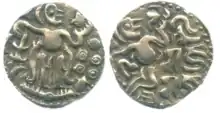 | 1018–1054 | |
| Rajendra II | 1054–1063 | ||
| Rajamehendra | 1060-1063 | ||
| Virarajendra | 1063–1070 | ||
| Athirajendra | 1070 | Left no heirs. | |
| Kulothunga I |  | 1070–1122 | Son of Amangai Devi Chola, daughter of Rajendra I, and Rajaraja Narendra, ruler of Eastern Chalukya dynasty. Kolothunga's reign started the period which was known as Chalukya-Chola dynasty or simply Later Cholas. |
| Vikrama | 1122–1135 | ||
| Kulothunga II |  | 1135–1150 | Grandson of the previous. |
| Rajaraja II | 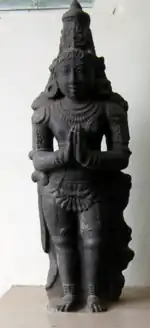 | 1150–1173 | |
| Rajadhiraja II | 1173–1178 | Grandson of king Vikrama Chola. | |
| Kulothunga III | 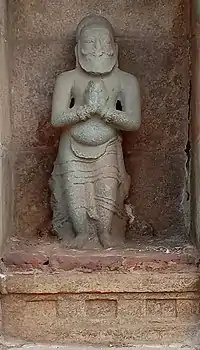 | 1178–1218 | |
| Rajaraja III | 1218–1256 | ||
| Rajendra III | 1256–1279 | Last Chola ruler, defeated by the Jatavarman Sundara Pandyan I of the Pandya dynasty. After the war, the remaining Chola royal bloods were reduced to the state of being chieftains by the Pandyan forces. | |
Classical Era (c. 200s BCE – c. 550s CE)
Velir dynasties (c. 300 BCE – 1200 CE)
- Major dynasties of Velir are-
Ay dynasty (Velir) (c. 300 BCE – 800 CE)
Early Ay Kings
- Ay Andiran
- Ay Titiyan
- Ay Atiyan
Medieval Ay Kings
- Chadayan Karunanthan
- Karunanthadakkkan Srivallabha (r. 856–884 CE)
- Vikramaditya Varaguna (r. 884–911 CE)
Satavahana dynasty (c. 228 BCE – 224 CE)
The beginning of the Satavahana rule is dated variously between 230 BCE to 100 BCE and lasted until the early 3rd century CE.[35] Satavahanas dominated the Deccan region from the 1st century BCE to 3rd century CE.[36] The following Satavahana kings are historically attested by epigraphic records, although the Puranas name several more kings.
S. Nagaraju relies on the Puranic lists of 30 kings, and gives the following regnal dates:[37]
| S. No | Ruler | Reign |
|---|---|---|
| 1 | Simuka | (r. 228 – 205 BCE) |
| 2 | Krishna | (r. 205 – 187 BCE) |
| 3 | Satakarni I | (r. 187 – 177 BCE) |
| 4 | Purnotsanga | (r. 177 – 159 BCE) |
| 5 | Skandhastambhi | (r. 159 – 141 BCE) |
| 6 | Satakarni II | (r. 141 – 85 BCE) |
| 7 | Lambodara | (r. 85 – 67 BCE) |
| 8 | Apilaka | (r. 67 – 55 BCE) |
| 9 | Meghasvati | (r. 55 – 37 BCE) |
| 10 | Svati | (r. 37 – 19 BCE) |
| 11 | Skandasvati | (r. 19 – 12 BCE) |
| 12 | Mrigendra Satakarni | (r. 12 – 9 BCE) |
| 13 | Kunatala Satakarni | (r. 9 – 1 BCE) |
| 14 | Satakarni III | (r. 1 BCE – 1 CE) |
| 15 | Pulumavi I | (r. 1 – 36 CE) |
| 16 | Gaura Krishna | (r. 36 – 61 CE) |
| 17 | Hāla | (r. 61 – 66 CE) |
| 18 | Mandalaka aka Puttalaka or Pulumavi II | (r. 69 – 71 CE) |
| 19 | Purindrasena | (r. 71 – 76 CE) |
| 20 | Sundara Satakarni | (r. 76 – 77 CE) |
| 21 | Chakora Satakarni | (r. 77 – 78 CE) |
| 22 | Shivasvati | (r. 78 – 106 CE) |
| 23 | Gautamiputra Satkarni | (r. 106 – 130 CE) |
| 24 | Vasisthiputra aka Pulumavi III | (r. 130 – 158 CE) |
| 25 | Shiva Sri Satakarni | (r. 158 – 165 CE) |
| 26 | Shivaskanda Satakarni | (r. 165–172) |
| 27 | Sri Yajna Satakarni | (r. 172 – 201 CE) |
| 28 | Vijaya Satakarni | (r. 201 – 207 CE) |
| 29 | Chandra Sri Satakarni | (r. 207 – 214 CE) |
| 30 | Pulumavi IV | (r. 217 – 224 CE) |
Mahameghavahana dynasty of Kalinga (c. 225 BCE – 300 CE)
Mahamegha Vahana was the founder of the Kalingan Chedi or Cheti Dynasty.[38][39] The names of Sobhanaraja, Chandraja, Ksemaraja also appear in context.[40] But, Kharavela is the most well known among them. The exact relation between Mahamegha Vahana and Kharavela is not known.[38]
Kingdom of Kangleipak (Manipur) (c. 200s BCE –1950 CE)
The Meitei people are made up of seven major clans, known as Salai Taret.
The clans include:
Ancient dynasties (clans) of Kangleipak
- Khapa-Nganpa Salai
- Taang-chaa Leela Pakhangpa
- Kangba
- Maliya Fampalcha
- Kaksu Tonkonpa
- Koilou Nongtailen Pakhangpa
- Samlungpha (44–34 BCE)
- Chingkhong Poireiton (34–18 BCE )
- Singtabung (18–8 BCE)
- Paangminnaba (8–1 BCE)
- Luwang Salai
- Luwang Khunthipa (1–5 CE)
- Luwang Punshipa (5–33 CE)
Ningthouja or Mangang dynasty (c. 33–1074 CE)
- Nongta Lailen Pakhangpa (33–154 CE)
- Khuiyoi Tompok (154–264 CE)
- Taothingmang (264–364 CE)
- Khui Ningonba (364–379 CE)
- Pengsipa (379–394 CE)
- Kaokhangpa (394–411 CE)
- Naokhampa (411–428 CE)
- Naophangpa (428–518 CE)
- Sameilang (518–568 CE)
- Urakonthoupa (568–658 CE)
- Naothingkhon (663–763 CE)
- Khongtekcha (763–773 CE)
- Keilencha (784–799 CE)
- Yalaba (799–821 CE)
- Ayangpa (821–910 CE)
- Ningthoucheng (910–949 CE)
- Chenglei-Ipan-Lanthapa (949–969 CE)
- Keiphaba Yanglon (969–984 CE)
- Irengba (984–1074 CE)
Kangleipak dynasty (c. 1074–1819 CE)
- Loiyumpa (1074–1112)
- Loitongpa (1112–1150)
- Atom Yoilempa (1150–1163)
- Iyanthapa (1163–1195)
- Thayanthapa (1195–1231)
- Chingthang Lanthapa (1231–1242)
- Thingpai Shelhongpa (1242–1247)
- Pulanthapa (1247–1263)
- Khumompa (1263–1278)
- Moilampa (1278–1302)
- Thangpi Lanthapa (1302–1324)
- Kongyampa (1324–1335)
- Telheipa (1335–1355)
- Tonapa (1355–1359)
- Tapungpa (1359–1394)
- Lailenpa (1394–1399)
- Punsipa (1404–1432)
- Ningthoukhompa (1432–1467)
- Senpi Kiyampa (1467–1508)
- Koilempa (1508–1512)
- Lamkhyampa (1512–1523)
- Nonginphapa (1523–1524)
- Kapompa (1524–1542)
- Tangchampa (1542–1545)
- Chalampa (1545–1562)
- Mungyampa (1562–1597)
- Khaki Ngampa(1597–1652)
- Khunchaopa (1652–1666)
- Paikhompa (1666–1697)
- Charairongba (1697–1709)
- Gharib Nawaz (Ningthem Pamheipa) (1709–1754), (adoption of the name Manipur)
- Chit Sain (1754–1756)
- Gaurisiam (1756–1763)
- Ching-Thang Khomba (Bhagya Chandra) (1764–1798)
- Rohinchandra (Harshachandra Singh) (1798–1801)
- Maduchandra Singh (1801–1806)
- Charajit Singh (1806–1812)
- Marjit Singh (1812–1819)
(Came to power with Burmese support).
Princely State (c. 1825–1947 CE)
- Gambhir Singh (1825–1834)
(Restored after the First Anglo-Burmese War)
- Regency for Chandrakirti Singh (1834–1850)
- Nara Singh (1844–1850)
- Debendro Singh (1850)
- Chandrakirti Singh (1850–1886)
- Surchandra Singh (1886–1890)
- Kulachandra Singh (1890–1891)
- Churachand Singh (1891–1941)
- Bodhchandra Singh (1941–1947)[43][44]
Kuninda Kingdom (c. 2nd century BCE to 3rd century CE)
The Kingdom of Kuninda was an ancient central Himalayan kingdom documented from around the 2nd century BCE to the 3rd century CE, located in the southern areas of modern Himachal Pradesh and far western areas of Uttarakhand in North India.
- The only known ruler of Kuninda Kingdom is
- Amoghabhuti (late 2nd to early 1st century BCE)
Foreign assimilated kingdoms in Indian subcontinent
These empires were vast, centered in Persia or the Mediterranean; their satrapies (provinces) in India were at their outskirts.
The sequence of there invasions are-
- The boundaries of the Achaemenid Empire after conquest of Indus valley reached North-West of the Indus River in 535 to 518 BCE.
- Alexander the Great (326–323 BCE) of the Argead dynasty who fought Porus in the Battle of the Hydaspes River.
- Seleucus I Nicator (323–321 BCE), diadochos was defeated by Chandragupta Maurya in Seleucid–Mauryan war 305 BCE.
- The Hellenistic Euthydemid Dynasty under Demetrius I also reached the north-western frontiers of India in 200s BCE.
Indo-Greek Kingdom (Yavanarajya) (c. 200 BCE – 10 CE)
- Demetrius I (c. 200–190 BCE), founder of dynasty
- Euthydemus II ( c. 190–185 BCE)
- Pantaleon (c. 190–180 BCE)
- Demetrius II of India
- Antimachus I (c. 171–160 BCE)
- Antimachus II (c. 170–165 BCE)
- Menander I (c. 165/155–130 BCE)
- Agathokleia (c. 130–125)
- Strato I (c. 125–105 BCE)
- Demetrius III Aniketos (c. 105–100 BCE)
- Amyntas Nikator (c. 100–90 BCE)
- Menander II (c. 90–80 BCE)
- Demetrius IV (c. 80–30 BCE)
- Strato II (c. 30–10 BCE)
- Strato III (c. 10 CE), last ruler
Indo-Scythian (Saka) ( c. 12 BCE – 395 CE)
Aprācas rulers (c. 12 BCE − 45 CE )
- Vijayamitra (c. 12 BCE − 15 CE)
- Indravasu (c. 15 – 20 CE)
- Vispavarman
- Iṃdravarmo
- Aspa (c. 20 – 45 CE)
- Sasan (c. 45 – 50 CE)
Northern Satraps rulers (Mathura area) (c. 20 BCE – 20 CE)
Minor local rulers
- Bhadayasa
- Mamvadi
- Arsakes
Northwestern Scythian rulers (c. 85 BCE – 10 CE)
- Maues (c. 85–60 BCE)
- Vonones (c. 75–65 BCE)
- Spalahores (c. 75–65 BCE)
- Spalarises (c. 60–57 BCE)
- Azes I (c. 57–35 BCE)
- Azilises (c. 57–35 BCE)
- Azes II (c. 35–12 BCE)
- Zeionises (c. 10 BCE–10 CE)
- Kharahostes (c. 10 BCE–10 CE)
Kshaharatas rulers
- Liaka Kusuluka
- Kusulaka Patika
- Bhumaka
- Nahapana (founder of the Western Satraps)
Western Satraps (Western Saka) (c. 119 – 395 CE)
- Nahapana (c. 119–124)
- Chastana (c. 124)
- Jayadaman (c. 124–130)
- Rudradaman I (c. 130–150)
- Damajadasri I (170–175)
- Jivadaman (175–199)
- Rudrasimha I (175–188)
- Isvaradatta (188–191)
- Rudrasimha I (restored) (191–197)
- Jivadaman (restored) (197–199)
- Rudrasena I (200–222)
- Samghadaman (222–223)
- Damasena (223–232)
- Damajadasri II (232–239) with
- Viradaman (234–238)
- Yasodaman I (239)
- Vijayasena (239–250)
- Damajadasri III (251–255)
- Rudrasena II (255–277)
- Visvasimha (277–282)
- Bhratadarman (282–295)
- Visvasena (293–304)
- Rudrasimha II, son of Lord (Svami) Jivadaman (304–348) with
- Yasodaman II (317–332)
- Rudradaman II (332–348)
- Rudrasena III (348–380)
- Simhasena (Indo-Scythian ruler) (380–382)
- Rudrasena IV (382–388)
- Rudrasimha III (388–395)
Pāratas rulers (c. 125 – 300 CE)
- Yolamira (c. 125–150)
- Bagamira (c. 150)
- Arjuna (c. 150–160)
- Hvaramira (c. 160–175)
- Mirahvara (c. 175–185)
- Miratakhma (c. 185–200)
- Kozana (c. 200–220)
- Bhimarjuna (c. 220–235)
- Koziya (c. 235–265)
- Datarvharna (c. 265–280)
- Datayola II (c. 280–300)
Kushan Empire (c. 1 – 375 CE)
| Ruler | Reign | Notes | |
|---|---|---|---|
| Heraios | 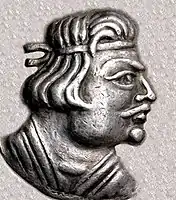 | 1–30 | King or clan chief of the Kushans. Founder of the dynasty. |
| Kujula Kadphises | 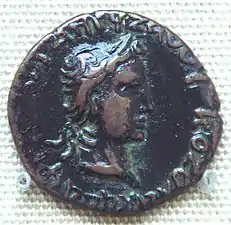 | 30–80 | United the Yuezhi confederation during the 1st century, and became the first Kushan emperor. |
| Vima Takto Soter Megas | 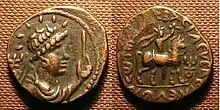 | 80–90 | Alias The Great Saviour. His empire covered northwestern Gandhara and greater Bactria towards China, where Kushan presence has been asserted in the Tarim Basin. Under his reign, embassies were also sent to the Chinese court. |
| Vima Kadphises | 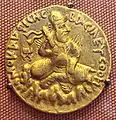 | 90–127 | The first great Kushan emperor. He introduced gold coinage, in addition to the existing copper and silver coinage. Most of the gold seems to have been obtained through trade with the Roman Empire. |
| Kanishka I the Great | 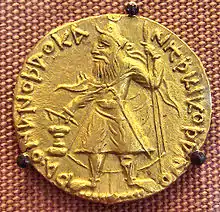 | 127–144 | Came to rule an empire in Bactria extending to Pataliputra on the Gangetic plain. His conquests and patronage of Buddhism played an important role in the development of the Silk Road, and in the transmission of Mahayana Buddhism from Gandhara across the Karakoram range to China. |
| Huvishka |  | 144–191 | His rule was a period of retrenchment and consolidation for the Empire. |
| Vasudeva I | 191–232 | He was the last great Kushan emperor, and the end of his rule coincides with the invasion of the Sassanians as far as northwestern India, and the establishment of the Indo-Sassanians or Kushanshahs from around 240. | |
| Kanishka II | 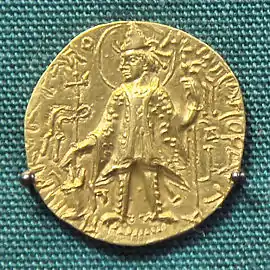 | 232–245 | It is likely he lost part of his empire to the Kushano-Sassanians. |
| Vashishka |  | 245–250 | |
| Kanishka III | .jpg.webp) | 250–275 | |
| Vasudeva II |  | 275–310 | |
| Chhu | 310–325 | ||
| Vasudeva III | c.300? | Kings whose existence is uncertain. | |
| Vasudeva IV | |||
| Vasudeva V | |||
| Shaka Kushan/Shaka I | 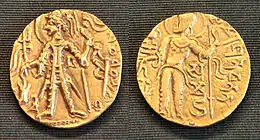 | 325–350 | |
| Kipunada |  | 350–375 | May have been a subject of Samudragupta from Gupta Empire. |
Indo-Parthian (Pahalava) (c. 21 – 100 CE)
- Gondophares I (c. 21–50)
- Abdagases I (c. 50–65)
- Satavastres (c. 60)
- Sarpedones (c. 70)
- Orthagnes (c. 70)
- Ubouzanes (c. 77)
- Sases or Gondophares II (c. 85)
- Abdagases II (c. 90)
- Pakores (c. 100)
Indo-Sasanian Kingdom (c. 233 – 365 CE)
- Ardashir I Kushanshah (233–245 CE)
- Peroz I Kushanshah (245–275 CE)
- Hormizd I Kushanshah (275–300 CE)
- Hormizd II Kushanshah (300–303 CE)
- Peroz II Kushanshah (303–330 CE)
- Varahran Kushanshah (330-365 CE)
Alchon Huns (Huna) (c. 400 – 670 CE)
- Anonymous kings (c. 400 – 430 CE)
- Khingila (c. 430 – 490 CE)
- Javukha/Zabocho (c. mid 5th – early 6th CE)
- Mehama (c. 461 – 493 CE)
- Lakhana Udayaditya (c. 490's CE)
- Aduman
- Toramana (c. 490 – 515 CE)
- Mihirakula (c. 515 – 540 CE)
- Toramana II (c. 530 – 570 CE)
- Pravarasena (c. 530 – 590 CE)
- Gokarna (c. 570 – 590 CE)
- Narendraditya Khinkhila (c. 590 – 630 CE)
- Yudhishthira (630 – 670 CE)
Chutu dynasty of Banavasi (c. 100 BCE–200 CE)
The following Chutu rulers are known from coins and inscriptions:[45]
- Chutukulananda
- Mulananda
- Sivalananda
Nagvanshi dynasty of Chotanagpur (c. 64–1952 CE)
Following is the list of Nagvanshi rulers according to Nagpuri poem "Nagvanshavali" written by Beniram Mehta and book "Nagvansh" written by Lal Pradumn Singh. The list of Kings and chronology varies in these books. 57th Nagvanshi king Dripnath Shah (c.1762–1790 CE) submitted list of Nagvanshi kings to Governor general of India in 1787.[46]
Rajas and Maharajas of Chotanagpur
- Raja Phani Mukut Rai (c. 64 – 162 CE), first Raja
- Raja Mukut Rai (c. 162 – 221 CE)
- Raja Ghat Rai (c. 221 – 278 CE)
- Raja Madan Rai (c. 278 – 307 CE)
- Raja Pratap Rai (c. 307 – 334 CE)
- Raja Kandrap Rai (c. 334 – 365 CE)
- Raja Udaimani Rai (c. 365 – 403 CE)
- Raja Jaimani Rai (c. 403 – 452 CE)
- Raja Srimani Rai (c. 452 – 476 CE)
- Raja Phani Rai (c. 476 – 493 CE)
- Raja Gendu Rai (c. 493 – 535 CE)
- Raja Hari Rai (c. 535 – 560 CE)
- Raja Gajraj Rai (c. 560 – 606 CE)
- Raja Sundar Rai (c. 606 – 643 CE)
- Raja Mukund Rai (c. 643 – 694 CE)
- Raja Udai Rai (c. 694 – 736 CE)
- Raja Kanchan Rai (c. 736 – 757 CE)
- Raja Magan Rai (c. 757 – 798 CE)
- Raja Jagan Rai (c. 798 – 837 CE)
- Raja Mohan Rai (c. 837 – 901 CE)
- Raja Gajdant Rai (c. 901 – 931 CE)
- Raja Gajghant Rai (c. 931 – 964 CE)
- Raja Chandan Rai (c. 964 – 992 CE)
- Raja Anand Rai (c. 992 – 1002 CE)
- Raja Sripati Rai (c. 1002 – 1055 CE)
- Raja Jaganand Rai (c. 1055 – 1074 CE)
- Raja Nripendra Rai (c. 1074 -1084 CE)
- Raja Gandharva Rai (c. 1084 -1098 CE)
- Raja Bhim Karn (c.1098 -c.1132)
- Raja Jash Karn (c.1132-c.1180)
- Raja Jai Karn (c.1180-c.1218)
- Raja Go Karn (c.1218-c.1236)
- Raja Hari Karn (c.1236-c.1276)
- Raja Shiv Karn (c.1276-c.1299)
- Raja Benu Karn (c.1299-c.1360)
- Raja Phenu Karn
- Raja Tihuli Karn
- Raja Shivdas Karn (c.1367-c.1389)
- Raja Udai Karn (c.1389-c.1427)
- Raja Pritvi Karn (c.1427-c.1451)
- Raja Pratap Karn (c.1451-c.1469)
- Raja Chhatra Karn (c.1469 – c.1515)
- Raja Virat Karn (c.1515 – c.1522)
- Raja Sindhu Karn (c.1522 – c.1535)
- Raja Madhu Karn Shah (c. 1584 -c.1599)
- Raja Bairisal (c. 1599 -c.1614)
- Raja Durjan Sal (c. 1614–1615)(c.1627 -c.1640)
- Raja Deo Shah
- Raja Raghunath Shah (1640–1690)
- Raja Ram Shah (1690–1715)
- Raja Yadunath Shah (1715–1724)
- Raja Shivnath Shah (1724–1733)
- Raja Udainath Shah (1733–1740)
- Raja Shyamsundar Nath Shah (1740–1745)
- Raja Balram Nath Shah (1745–1748)
- Raja Maninath Shah (1748–1762)
- Raja Dhripnath Shah (1762–1790)
- Raja Deo Nath Shah (1790–1806)
- Maharaja Gobind Nath Shah Deo (1806–1822), first Maharaja
- Maharaja Jagannath Shah Deo (1822–1872)
- Maharaja Udai Pratap Nath Shah Deo (1872–1950)
- Maharaja Lal Chintamani Sharan Nath Shahdeo (1950–1952)
Bharshiva dynasty (Nagas of Padmavati) (c. 170–350 CE)
- Vrisha-naga
(Possibly ruled at Vidisha in the late 2nd Century).
- Vrishabha or Vrisha-bhava
(May also be the name of a distinct king who succeeded Vrisha-naga).
- Bhima-naga (210–230 CE)
(Probably the first king to rule from Padmavati)
- Skanda-naga
- Vasu-naga
- Brihaspati-naga
- Vibhu-naga
- Ravi-naga
- Bhava-naga
- Prabhakara-naga
- Deva-naga
- Vyaghra-naga
- Ganapati-naga
Chandra dynasty (c. 202–1050 CE)
| # | King | Period | Reign (CE) |
|---|---|---|---|
| 1 | Chandrodaya | 27 | 202–229 |
| 2 | Annaveta | 5 | 229–234 |
| 3 | Chandra | 77 | 234–311 |
| 4 | Rimbhiappa | 23 | 311–334 |
| 5 | Kuverami (Queen) | 7 | 334–341 |
| 6 | Umavira | 20 | 341–361 |
| 7 | Jugna | 7 | 361–368 |
| 8 | Lanki | 2 | 368–370 |
| 9 | Dvenchandra | 55 | 370–425 |
| 10 | Rajachandra | 20 | 425–445 |
| 11 | Kalachandra | 9 | 445–454 |
| 12 | Devachandra | 22 | 454–476 |
| 13 | Yajnachandra | 7 | 476–483 |
| 14 | Chandrabandu | 6 | 483–489 |
| 15 | Bhumichandra | 7 | 489–496 |
| 16 | Bhutichandra | 24 | 496–520 |
| 17 | Nitichandra | 55 | 520–575 |
| 18 | Virachandra | 3 | 575–578 |
| 19 | Pritichandra | 12 | 578-90 |
| 20 | Prithvichandra | 7 | 590–597 |
| 21 | Dhirtichandra | 3 | 597–600 |
| 22 | Mahavira | 12 | 600-12 |
| 23 | Virayajap | 12 | 612-24 |
| 24 | Sevinren | 12 | 624-36 |
| 25 | Dharmasura | 13 | 636-49 |
| 26 | Vajrashakti | 16 | 649-65 |
| 27 | Dharmavijaya | 36 | 665–701 |
| 28 | Narendravijaya | 2 yr 9 months | 701–703 |
| 29 | Dharmachandra | 16 | 703–720 |
| 30 | Anandachandra | 9+ | 720-729+ |
| Harikela Dynasty | |||
| 1 | Traillokyachandra | 30 | 900–930 |
| 2 | Srichandra | 45 | 930–975 |
| 3 | Kalyanachandra | 25 | 975–1000 |
| 4 | Ladahachandra | 20 | 1000–1020 |
| 5 | Govindachandra | 30 | 1020–1050 |
Abhira dynasty of Nasik (203–370 CE)
The following is the list of the sovereign and strong Abhira rulers:[49]
- Abhira Sivadatta
- Sakasena alias Saka Satakrni
- Abhira Ishwarsena alias Mahaksatrapa Isvaradatta
- Abhira Vashishthiputra Vasusena
Second Magadha Empire (c. 240 – 750 CE)
Imperial Guptas
| Ruler | Reign | ||
|---|---|---|---|
| Srigupta | 240–290 | ||
| Ghatotkacha | 290–320 | ||
| Chandragupta I |  | 320–325 | |
| Samudragupta |  | 325–375 | |
| Kacha | 4th-century | ||
| Ramagupta | 375–380 | ||
| Chandragupta II Vikramaditya |  | 380–415 | |
| Kumaragupta I |  | 415–455 | |
| Skandagupta |  | 455–467 | |
| Purugupta | 467–472 | ||
| Kumaragupta II Kramaditya |  | 472–479 | |
| Buddhagupta |  | 479–496 | |
| Narasimhagupta Baladitya |  | 496–530 | |
| Kumaragupta III | 530–540 | ||
| Vishnugupta Candraditya |  | 540–550 | |
| Bhanugupta | ? | ||
Later Guptas (c. 490 – 750 CE)
The genealogy of Later Gupta rulers regin is disputed, this list is approx to there original regin:[50][51]
| Nu. | King | Reign (CE) | Notes |
|---|---|---|---|
| 1 | Krishna-gupta | c. 490–505 | |
| 2 | Harsha-gupta | c. 505–525 | |
| 3 | Jivita-gupta I | c. 525–550 | |
| 4 | Kumara-gupta | c. 550–560 | |
| 5 | Damodara-gupta | c. 560–562 | |
| 6 | Mahasena-gupta | c. 562–601 | |
| 7 | Madhava-gupta | c. 601–655 | |
| 8 | Aditya-sena | c. 655–680 | |
| 9 | Deva-gupta | c. 680–700 | |
| 10 | Vishnu-gupta | c. 700–725 | |
| 11 | Jivita-gupta II | c. 725–750 | |
Vakataka dynasty (c. 250–500 CE)
| Ruler | Reign | Capital | Notes | |
|---|---|---|---|---|
| Vindhyashakti | 250-275 | Vatsagulma | Founder of the Vakataka Empire and dynasty. | |
| Pravarasena I | 275-330 | Vatsagulma | After his death, his sons divided the empire: Rudrasena took the northern half, and Sarvasena the southern (with the original capital) | |
| Rudrasena I | 330-360 | Pravapura and Nandivardhana (Northern) | Son of Pravarasena, took the northern part of the realm. | |
| Sarvasena I | 330-355 | Vatsagulma (Southern) | Son of Pravarasena, took the southern part of the realm. | |
| Vindhyasena | 355-400 | Vatsagulma (Southern) | ||
| Prithivishena I | 360-385 | Pravapura and Nandivardhana (Northern) | ||
| Rudrasena II | 385-390 | Pravapura and Nandivardhana (Northern) | ||
| Regency of Prabhavatigupta (390-410) | Ruled under regency of his mother (daughter of Chandragupta II). The regency coincided with the zenith of the Gupta Empire, which also extended influence into the Vakataka realms. | |||
| Divakarasena | 390-410 | Pravapura and Nandivardhana (Northern) | ||
| Pravarasena II | 400-415 | Vatsagulma (Southern) | ||
| Damodarasena | 410-420 | Pravapura and Nandivardhana (Northern) | ||
| Sarvasena II | 415-455 | Vatsagulma (Southern) | ||
| Pravarasena II | 430-440 | Pravapura and Nandivardhana (Northern) | ||
| Narendrasena | 440-460 | Pravapura and Nandivardhana (Northern) | ||
| Devasena | 455-480 | Vatsagulma (Southern) | ||
| Prithivishena II | 460-480 | Pravapura and Nandivardhana (Northern) | ||
| Harishena | 480-510 | Vatsagulma (Southern) | ||
Pallava dynasty (c. 275 – 897 CE)
Early or Middle Pallavs rulers regin is disputed, this timeline is approx to there original regin:
| Nu. | King | Reign (CE) (disputed) | Notes |
|---|---|---|---|
| Former Pallava | |||
| 1 | Simhavarman I | c. 275–300 | |
| 2 | Sivaskandavarman | c. 300–330 | |
| 3 | Skandavarman I | c. 330–340 | |
| Middle Pallava | |||
| 4 | Vishnugopa | c. 340–360 | |
| 5 | Skandavarman II | c. 360–380 | |
| 6 | Kumaravishnu I | c. 380–400 | |
| 7 | Buddhavarman | c. 400–410 | |
| 8 | Kumaravishnu II | c. 410–420 | |
| 9 | Viravarman | c. 420–425 | |
| 10 | Skandavarman IV | c. 425–436 | |
| 11 | Simhavarman II | c. 436–458 | |
| 12 | Skandavarman V | c. 458–480 | |
| 13 | Nandivarman | c. 480–500 | |
| 14 | Vishnugopavarman | c. 500–520 | |
| 15 | Candadanda | c. 520–540 | |
| 16 | Simhavarman III | c. 540–560 | |
| Later Pallava | |||
| 17 | Simhavishnu | c. 560–600 | |
| 18 | Mahendravarman I | c. 600–630 | |
| 19 | Narasimhavarman I (Mamalla) | c. 630–668 | |
| 20 | Mahendravarman II | c. 668–672 | |
| 21 | Paramesvaravarman I | c. 672–700 | |
| 22 | Narasimhavarman II (Raja Simha) | c. 700–728 | |
| 23 | Paramesvaravarman II | c. 728–732 | |
| 24 | Nandivarman II (Pallavamalla) | c. 732–796 | |
| 25 | Thandivarman | c. 796–840 | |
| 26 | Nandivarman III | c. 840–869 | |
| 27 | Nrpatungavarman | c. 869–882 | |
| 28 | Aparajitavarman | c. 882–897 | |
Aulikara Empire (c. 300 – 550 CE)
Rulers of First Aulikara dynasty-
- Jayavarma
- Simhavarma
- Naravarma
- Vishvavarma
- Bandhuvarma
Rulers of Second Aulikara dynasty-
- Drumavardhana
- Jayavardhana
- Ajitavardhana
- Vibhishanavardhana
- Rajyavardhana
- Prakashadharma
- Yashodharman (c. 515–545 CE)
Kadamba dynasty of Banavasi (c. 345 – 540 CE)
Banavasi branch rulers-
- Mayurasharma (345–365)
- Kangavarma (365–390)
- Bhageerath (390–415)
- Raghu (415–435)
- Kakusthavarma (435–455)
- Santivarma (455–460)
- Shiva Mandhatri (460–475)
- Mrigeshavarma (475–485)
- Ravivarma (485–519)
- Harivarma (519–530)
Triparvatha branch rulers-
- Krishna Varma I (455–475)
- Vishnuvarma (475–485)
- Simhavarma (485–516)
- Krishna Varma II (516–540)
Kadamba dynasty of Goa (960 – 1345 CE)
- Shashthadeva I alis Kantakacharya (c. 960 CE), founder of dynasty
- Nagavarma
- Guhalladeva I
- Shashathadeva II
- Guhalladeva II (1038–1042)
- Veeravarmadeva ( 1042–1054)
- Jayakeshi I (1054–1080)
- Guhalladeva II alias Tribhuvanamalla (1080–1125)
- Vijayaditya I alias Vijayarka, (ruling prince up to 1104)
- Jayakeshi II (1125–1148)
- Shivachitta alis Paramadideva ( 1148–1179)
- Vishnuchitta alias Vijayaditya II (1179–1187)
- Jayakeshi III (1188–1216)
- Vajradeva alis Shivachitta (regin?)
- Sovideva alis Tribhuvanamalla (1216–1246?)
- Shashthadeva III (?1246–1265)
- Kamadeva (1265–1310), last known ruler of dynasty
Kadamba dynasty of Hangal (980 – 1275 CE)
- known rulers are-
- Chattadeva (980–1031), founder of dynasty
- Kamadeva
- Somadeva
- Mayuravarma
Other minor Kadamba Kingdoms
- Kadambas of Halasi
- Kadambas of Bankapur
- Kadambas of Bayalnad
- Kadambas of Nagarkhanda
- Kadambas of Uchchangi
- Kadambas of Bayalnadu (Vainadu)
Varman dynasty of Kamarupa (350–650 CE)
The dynastic line, as given in the Dubi and Nidhanpur copperplate inscriptions:[52]
| Reign | Name | succession | Queen | |
|---|---|---|---|---|
| 1 | 350-374 | Pushyavarman | (unknown) | |
| 2 | 374-398 | Samudravarman | son of Pushyavarman | Dattadevi |
| 3 | 398-422 | Balavarman | son of Samudravarman | Ratnavati |
| 4 | 422-446 | Kalyanavarman | son of Balavarman | Gandharavati |
| 5 | 446-470 | Ganapativarman | son of Kalyanavarman | Yajnavati |
| 6 | 470-494 | Mahendravarman | son of Ganapativarman | Suvrata |
| 7 | 494-518 | Narayanavarman | son of Mahendravarman | Devavati |
| 8 | 518-542 | Bhutivarman | son of Narayanavarman | Vijnayavati |
| 9 | 542-566 | Chandramukhavarman | son of Bhutivarman | Bhogavati |
| 10 | 566-590 | Sthitavarman | son of Chandramukhavarman | Nayanadevi |
| 11 | 590-595 | Susthitavarman | son of Sthitavarman | Syamadevi |
| 12 | 595-600 | Supratisthitavarman | son of Susthitavarman | (Bachelor) |
| 13 | 600-650 | Bhaskaravarman | brother of Supratisthitavarman | (Bachelor) |
| 14 | 650-655 | Avanti Varman | (unknown) | (unknown) |
Ganga dynasty (350–1424 CE)
| Ruler | Reign | Capital | Notes | |
|---|---|---|---|---|
| Konganivarma Madhava I | 350-370 | Talakad (Western) | Founder of the dynasty, who gained independence from the Pallava dynasty. He ruled the area around modern Kolar in the early 4th century. | |
| Madhava II | 370-390 | Talakad (Western) | ||
| Harivarman | 390-410 | Talakad (Western) | ||
| Vishnugopa | 410-430 | Talakad (Western) | ||
| Madhava III Tadangala | 430-469 | Talakad (Western) | ||
| Avinita | 469-529 | Talakad (Western) | ||
| Indravarman I | 498-537 | Dantapuram (Eastern) | Indravarman I is earliest known Independent king of the dynasty. He is known from the Jirjingi copper plate grant.[53][54] Founder of the Eastern line of the family, which is probable to be descended from the Western one. | |
| Durvinita | 529-579 | Talakad (Western) | ||
| Samantavarman | 537-562 | Dantapuram (Eastern) | ||
| Hastivarman | 562-578 | Dantapuram (Eastern) | ||
| Indravarman II | 578-589 | Dantapuram (Eastern) | ||
| Mushkara | 579-604 | Talakad (Western) | ||
| Danarnava | 589-652 | Dantapuram (Eastern) | ||
| Polavira | 604-629 | Talakad (Western) | ||
| Indravarman III | 652-682 | Dantapuram (Eastern) | ||
| Srivikrama | 629-654 | Talakad (Western) | ||
| Bhuvikrama | 654-679 | Talakad (Western) | ||
| Shivamara I | 679-725 | Talakad (Western) | ||
| Gunarnava | 682-730 | Dantapuram (Eastern) | ||
| Sripurusha | 725-788 | Talakad (Western) | ||
| Devendravarman I | 730-780 | Dantapuram (Eastern) | ||
| Anantavarman I | 780-812 | Dantapuram (Eastern) | ||
| Shivamara II | 788-816 | Talakad (Western) | He was taken captive by the Rashtrakutas. | |
| Rajendravarman | 812-840 | Dantapuram (Eastern) | ||
| Rachamalla I | 817-853 | Talakad (Western) | ||
| Devendravarman II | 840-895 | Dantapuram (Eastern) | ||
| Neetimarga I Ereganga | 853-869 | Talakad (Western) | ||
| Rachamalla II | 869-907 | Talakad (Western) | ||
| Gunamaharnava I | 895-910 | Dantapuram (Eastern) | ||
| Neetimarga II Ereyappa | 907-921 | Talakad (Western) | ||
| Vajrahasta-Anangabhimadeva I | 910-939 | Dantapuram (Eastern) | ||
| Narasimha I | 921-933 | Talakad (Western) | ||
| Rachamalla III | 933-938 | Talakad (Western) | ||
| Butuga | 938-961 | Talakad (Western) | Ruled jointly, in 949. | |
| Takkolam | 949 | Talakad (Western) | ||
| Gundama I | 939-942 | Dantapuram (Eastern) | ||
| Kamarnava I | 942-977 | Dantapuram (Eastern) | ||
| Neetimarga III Marulaganga | 961-963 | Talakad (Western) | ||
| Narasimha II | 963-975 | Talakad (Western) | ||
| Rachamalla IV | 975-986 | Talakad (Western) | ||
| Vinayaditya | 977-980 | Dantapuram (Eastern) | ||
| Vajrahasta II | 980-1015 | Dantapuram (Eastern) | ||
| Rachamalla V | 986-999 | Talakad (Western) | ||
| Neetimarga IV Permanadi | 999 | Talakad (Western) | In 999, after his death, the Western Ganga Empire was annexed by the Chola dynasty. | |
| Annexed to the Chola Empire | ||||
| Kamarnava II | 1015 | Dantapuram (Eastern) | ||
| Gundama II | 1015-1018 | Dantapuram (Eastern) | ||
| Madhukamarnava | 1018-1038 | Dantapuram (Eastern) | ||
| Vajrahasta III | 1038-1070 | Dantapuram (Eastern) | ||
| Rajarajadeva I | 1070-1078 | Dantapuram (Eastern) | ||
| Anantavarman II Chodaganga |  | 1078-1150 | Dantapuram (Eastern) | |
| Jatesvaradeva | 1150-1156 | Dantapuram (Eastern) | ||
| Raghavadeva | 1156-1170 | Dantapuram (Eastern) | ||
| Rajarajadeva II | 1170-1178 | Dantapuram (Eastern) | ||
| Anangabhimadeva II | 1178-1198 | Dantapuram (Eastern) | ||
| Rajarajadeva III | 1198-1211 | Dantapuram (Eastern) | ||
| Anangabhimadeva III | 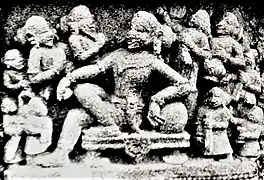 | 1211-1238 | Kataka (Eastern) | |
| Narasinghadeva I | 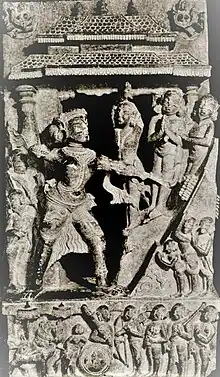 | 1238-1264 | Kataka (Eastern) | |
| Bhanudeva I | 1264-1279 | Kataka (Eastern) | ||
| Narasinghadeva II | 1279-1306 | Kataka (Eastern) | ||
| Bhanudeva II | 1306-1328 | Kataka (Eastern) | ||
| Narasinghadeva III | 1328-1352 | Kataka (Eastern) | ||
| Bhanudeva III | 1352-1378 | Kataka (Eastern) | ||
| Narasinghadeva IV | 1378-1424 | Kataka (Eastern) | ||
| Bhanudeva IV | 1424-1434 | Kataka (Eastern) | After his death, the Empire was annexed to the Gajapati Kingdom. | |
| Annexed to the Gajapati Kingdom | ||||
Gudari Kataka Ganga State
According to Gangavansucharitam written in sixteenth or seventeenth century, Bhanu Deva IV also known as Kajjala Bhanu founded a new small princedom in southern Odisha at Gudari in modern Rayagada district after he was toppled from power by his general Kapilendra Deva.[55]
- Kajjala Bhanu (or Bhanu Deva IV)
- Svarna Bhanu
- Kalasandha Deva
- Chudanga Deva
- Harimani Deva
- Narasimha Deva
- Ananta Deva
- Padmanabha Deva
- Pitambara Deva
- Vasudeva
- Purrushottama Anangabhima Deva (or Bhima Deva)
Chikiti Ganga State (c. 881–1950 CE)
Historians conclude that the rulers of Chikiti were from the line of Ganga ruler Hastivarman.[56][57]
- Kesaba Rautara (or Bira Karddama Singha Rautara) (881–940)
- Balabhadra Rautara (941–997)
- Madhaba Rautara (998–1059)
- Languli Rautara (1060–1094)
- Mohana Rautara (1095–1143)
- Balarama Rautara (1144–1197)
- Biswanatha Rautara (1198–1249)
- Harisarana Rautara (1250–1272)
- Raghunatha Rautara (1273–1313)
- Dinabandhu Rautara (1314–1364)
- Gopinatha Rautara (1365–1417)
- Ramachandra Rautara (1418–1464)
- Narayana Rautara (1465–1530)
- Narasingha Rautara (1531–1583)
- Lokanatha Rautara (1584–1633)
- Jadumani Rautara (1634–1691)
- Madhusudana Rajendra Deba (1692–1736)
- Kulamani Rajendra Deba (1737–1769)
- Krusnachandra Rajendra Deba (1770–1790)
- Pitambara Rajendra Deba (1791–1819)
- Gobindachandra Rajendra Deba (1820–1831)
- Kulamani Rajendra Deba (1832–1835)
- Brundabanachandra Rajendra Deba (1835–1846)
- Jagannatha Rajendra Deba (1847–1855)
- Biswambhara Rajendra Deba (1856–1885)
- Kisorachandra Rajendra Deba (1885–1903)
- Radhamohana Rajendra Deba (1903–1923)
- Gaurachandra Rajendra Deba (1923–1934)
- Sachhidananda Rajendra Deba (1934–1950)
Parlakhemundi Ganga State (c. 1309–1950)
Parlakhemundi state rulers were the direct descendants of the Eastern Ganga dynasty rulers of Odisha.[58][59]
- Narasingha Deba (1309–1320)
- Madanrudra Deba (1320–1339)
- Narayana Rudra Deba (1339–1353)
- Ananda Rudra Deba (1353–1354)
- Ananda Rudra Deba (1354–1367)
- Jayarudra Deba (1367–1399)
- Lakhsmi Narasingha Deba (1399–1418)
- Madhukarna Gajapati (1418–1441)
- Murtunjaya Bhanu Deba (1441–1467)
- Madhaba Bhanu Deba (1467–1495)
- Chandra Betal Bhanu Deba (1495–1520)
- Subarnalinga Bhanu Deba (1520–1550)
- Sibalinga Narayan Bhanudeo (1550–1568)
- Subarna Kesari Govinda Gajapati Narayan Deo (1568–1599)
- Mukunda Rudra Gajapati Narayan Deo (1599–1619)
- Mukunda Deo (1619–1638)
- Ananta Padmanabh Gajapati Narayan Deo I (1638–1648)
- Sarbajgan Jagannatha Gajapati Narayan Deo I (1648–1664)
- Narahari Narayan Deo (1664–1691)
- Bira Padmanabh Narayan Deo II (1691–1706)
- Prataprudra Gajapati Narayan Deo I (1706–1736)
- Jagannatha Gajapati Narayana Deo II (1736–1771)
- Goura Chandra Gajapati Narayan Deo I (1771–1803)
- Purushottam Gajapati Narayan Deo (1803–1806)
- Jagannath Gajapati Narayan Deo III (1806–1850)
- Prataprudra Gajapati Narayan Deo II (1850–1885)
- Goura Chandra Gajapati Narayan Deo II (1885–1904)
- Krushna Chandra Gajapati Narayan Deo (1913–1950)
- Krushna Chandra Gajapati Narayan Deo (1950 – 25 May 1974), titular
- Gopinath Gajapati Narayan Deo (25 May 1974 – 10 January 2020), titular
- Kalyani Gajapati (10 January 2020–present), titular
Traikutaka dynasty (c. 370–520 CE)
The following Traikuta rulers are known from the coins and inscriptions of Gupta Empire:[60]
- Maharaja Indradatta (415–440 CE)
- Maharaja Dahrasena
- Maharaja Vyaghrasena, son of Dahrasena (480 CE)
- Maharaja Madhyamasena
- Vikramasena
Vishnukundina dynasty (c. 420–624 CE)
- Madhava Varma I (420–455)
- Indra Varma (455–461)
- Madhava Verma II (461–508)
- Vikramendra Varma I (508–528)
- Indra Bhattaraka Varma (528–580)
- Janssraya Madhava Varma IV (580–624)[53][54]
Maitraka dynasty of Vallabhi (c. 475–776 CE)
- Bhatarka (c. 475–492)
- Dharasena I (c. 493–499)
- Dronasinha (also known as Maharaja) (c. 500–520)
- Dhruvasena I (c. 520–550)
- Dharapatta (c. 550–556)
- Guhasena (c. 556–570)
- Dharasena II (c. 570–595)
- Siladitya I (also known as Dharmaditya) (c. 595–615)
- Kharagraha I (c. 615–626)
- Dharasena III (c. 626–640)
- Dhruvasena II (also known as Baladitya) (c. 640–644)
- Chkravarti king Dharasena IV (also known as Param Bhatarka, Maharajadhiraja, Parameshwara) (c. 644–651)
- Dhruvasena III (c. 651–656)
- Kharagraha II (c. 656–662)
- Siladitya II
- Siladitya III
- Siladitya IV
- Siladitya V
- Siladitya VI
- Siladitya VII (c. 766 CE)[61]
Rai dynasty (c. 489–632 CE)
- Rai Diwa ji (Devaditya)
- Rai Sahiras (Shri Harsha)
- Rai Sahasi (Sinhasena)
- Rai Sahiras II, died battling the King of Nimroz
- Rai Sahasi II, the last of the line
Chalukya dynasty (c. 500–1200 CE)
| Ruler | Reign | Capital | Notes | |
|---|---|---|---|---|
| Jayasimha I | 500–520 | Badami | Founder of the dynasty. He ruled the area around modern Bijapur in the early 6th century. | |
| Ranaraga | 520–540 | Badami | ||
| Pulakeshin I | 540–567 | Badami | He ruled parts of the present-day Maharashtra and Karnataka states in the western Deccan region of India. | |
| Kirtivarman I | 567–592 | Badami | He expanded the Chalukya kingdom by defeating the Nalas, the Mauryas of Konkana, the Kadambas, the Alupas, and the Gangas of Talakad. | |
| Mangalesha |  | 592–610 | Badami | Brother of Kirtivarman. Expanded the Chalukya power in present-day Gujarat and Maharashtra after defeating the Kalachuri king Buddharaja. He also consolidated his rule in the Konkan coastal region of Maharashtra and Goa after conquering Revati-dvipa from the rebel Chalukya governor Svamiraja. His reign ended when he lost a war of succession to his nephew Pulakeshin II, a son of Kirttivarman I. |
| Pulakeshin II | .jpg.webp) | 610–642 | Badami | Son of Kirtivarman I, he overthrew his uncle Mangalesha to gain control of the throne. Suppressed a rebellion by Appayika and Govinda, and decisively defeated the Kadambas of Banavasi in the south. Consolidated the Chalukya control over the western coast by subjugating the Mauryas of Konkana. He was victorious against the
powerful northern emperor Harsha-vardhana. He also achieved some successes against the Pallavas in the south, but was ultimately defeated, and probably killed, during an invasion by the Pallava king Narasimhavarman I. |
| Kubja Vishnuvardhana I | 615/24–641 | Vengi (Eastern) | Brother of Pulakeshin II. Ruled under him as viceroy in Vengi, and then declared independence in 624. | |
| Jayasimha I (II) | 641–673 | Vengi (Eastern) | ||
| Adityavarman | 642–645 | Badami | First son of Pulakeshin II. Probably ruled under the Pallavas. | |
| Abhinavaditya | 645–646 | Badami | Son of the predecessor. | |
| Chandraditya | 646–649 | Badami | Second son of Pulakeshin II. | |
| Regency of Vijaya-Bhattarika (649-655) | Regent for her minor son. She was deposed by her brother-in-law. | |||
| A son of Chandraditya | 649-655 | Badami | ||
| Satyashraya | c.650-675 | Vemulavada | Founder of the branch, possibly son of Pulakshin II. | |
| Vikramaditya I | 655–680 | Badami | He restored order in the fractured kingdom and made the Pallavas retreat from the capital. | |
| Indra Bhattaraka | 673 | Vengi (Eastern) | Brother of Jayasimha II. Ruled for a week. | |
| Vishnuvardhana II | 673–682 | Vengi (Eastern) | ||
| Prithvipathi | c.675-700 | Vemulavada | ||
| Vinayaditya | 680–696 | Badami | He carried campaigns against the Pallavas, Kalabhras, Haihayas, Vilas, Cholas, Pandyas, Gangas and many more. | |
| Mangi Yuvaraja | 682–706 | Vengi (Eastern) | ||
| Vijayaditya I | 696–733 | Badami | His long reign was marked by general peace and prosperity. Vijayaditya also built a number of temples. He fought against the Pallavas and extracted tributes from Parameshwar Varma V. | |
| Maharaja | c.700-725 | Vemulavada | ||
| Jayasimha III | 706–718 | Vengi (Eastern) | ||
| Kokkli | 718–719 | Vengi (Eastern) | ||
| Vishnuvardhana III | 719–755 | Vengi (Eastern) | ||
| Rajaditya | c.725-750 | Vemulavada | ||
| Vikramaditya II | 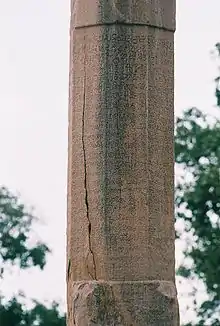 | 733–746 | Badami | Conducted successful military campaigns against their enemy, the Pallavas of Kanchipuram, in three occasions: the first time as a crown prince, the second time as an emperor and the third time under the leadership of his son and crown prince Kirtivarman II. |
| Kirtivarman II Rahappa | 746- 757 | Badami | His reign was continuously troubled by the growing power of the Rashtrakutas and Pandyas. He finallt succumbed to the Rashtrakutas, who ended the power of the family in Badami. | |
| Vinayaditya Yuddhamalla I | c.750-775 | Vemulavada | ||
| Vijayaditya I (II) | 755–772 | Vengi (Eastern) | ||
| Vishnuvardhana IV | 755–808 | Vengi (Eastern) | ||
| Arikesari I | c.775-800 | Vemulavada | ||
| Narasimha I | c.800-825 | Vemulavada | ||
| Vijayaditya II (III) | 808–847 | Vengi (Eastern) | His first military victories against the Rashtrakutas made the path for the independence of the dynasty from this occupant. | |
| Yuddhamalla II | c.825-850 | Vemulavada | ||
| Kali Vishnuvardhana V | 847–849 | Vengi (Eastern) | ||
| Vijayaditya III (IV) | 849–892 | Vengi (Eastern) | Brothers, ruled together. | |
| Vikramaditya I (III) | Vengi (Eastern) | |||
| Yuddhamalla I | Vengi (Eastern) | |||
| Baddega I Soladaganda | c.850-895 | Vemulavada | ||
| Bhima I | 892–921 | Vengi (Eastern) | During his rule, Vengi could claim some independence as capital from the Rashtrakutas. | |
| Yuddhamalla III | c.895-915 | Vemulavada | ||
| Narasimha II | c.915-930 | Vemulavada | ||
| Vijayaditya IV (V) | 921 | Vengi (Eastern) | ||
| Amma I | 921–927 | Vengi (Eastern) | Probably brothers, ruled jointly. | |
| Vishnuvardhana VI | Vengi (Eastern) | |||
| Vijayaditya V (VI) | 927 | Vengi (Eastern) | Ruled for fifteen days. | |
| Tadapa | 927 | Vengi (Eastern) | Ruled for a month. | |
| Vikramaditya II (IV) | 927–928 | Vengi (Eastern) | ||
| Bhima II | 928–929 | Vengi (Eastern) | ||
| Yuddhamalla II | 929–935 | Vengi (Eastern) | ||
| Arikesari II | c.930-941 | Vemulavada | ||
| Bhima III | 935–947 | Vengi (Eastern) | ||
| Baddega II | 941-946 | Vemulavada | Ruled jointly. | |
| Vagaraja | 941-950 | Vemulavada | ||
| Arikesari III | 946/950-968 | Vemulavada | ||
| Annexed to the Western Chalukya Empire | ||||
| Amma II | 947–970 | Vengi (Eastern) | ||
| Danarnava | 970–973 | Vengi (Eastern) | Deposed by Jata Choda Bhima. Sought for help within the Chola Empire. | |
| Tailapa II Ahvamalla | _of_Kalyani_(Western)_Chalukya_King_Ahvamalla_Tailapa_II.JPG.webp) | 973–997 | Kalyani (Western) | 6th great-grandson of Vijayaditya I. Ousted the Rashtrakutas in the West and recovered the power once held by his family. |
| Jata Choda Bhima | 973–999 | Vengi (Eastern) | ||
| Satyashraya | 997–1008 | Kalyani (Western) | ||
| Shaktivarman I | 999–1011 | Vengi (Eastern) | First son of Danarnava. Returned from exile and recovered his throne. Now free from the usurper, however Eastern Vengi dynasty lost some of the independence they have gained some generations ago. Begin of the growing Chola influence in Vengi kingdom. | |
| Vikramaditya V | 1008–1015 | Kalyani (Western) | Nephew of Satyahraya, as son of his brother, Dashavarman. | |
| Vimaladitya | 1011–1018 | Vengi (Eastern) | Second son of Danarnava. In his exile period with his father and brother, he was married to Kundavai, daughter of Rajaraja I from the Chola Empire. | |
| Jayasimha II (III) | _of_Kalyani_(Western)_Chalukya_King_Jayasimha_II.JPG.webp) | 1015–1043 | Kalyani (Western) | He had to fight on many fronts, against the Cholas of Tanjore in the south and the Paramara dynasty in the north, to protect his kingdom. His rule however was an important period of development of Kannada literature. He saw his cousins in Vengi fall firmly into the hands of the Cholas who would use their marital relations with the Eastern Chalukyas and their over lordship over Vengi to frustrate and threaten the Western Chalukyas from two fronts, from the east and from the South. But, at the same time, he consolidated more firmly the Western Chalukya power in the Deccan. |
| Rajaraja Narendra |  | 1018–1061 | Vengi (Eastern) | Son of Vimaladitya, had support in the throne from the Cholas, whose influence grew significantly. He supported Cholas against his cousins, the Western Chalukyas. His own son managed to succeed in the Chola Empire, in 1070, as Kulottunga I, beginning the Later Cholas period, in which the Chola Empire was ruled by a branch of the Eastern Chalukyas renamed Chola, which inherited Narendra's kingdom. It's possible, then, that the following rulers were governors for the Chola Emperor ruling Eastern Chalukya territory:
|
| Annexed to the Chola Empire (1061-1118); Annexed to the Western Chalukya Empire (since 1118) | ||||
| Someshvara I Trilokyamalla | 1042–1068 | Kalyani (Western) | His several military successes in Central India made him a formidable ruler of a vast empire. During his rule, the Chalukyan empire extended to Gujarat and Central India in the north. | |
| Someshvara II Bhuvanaikamalla | _of_Kalyani_(Western)_Chalukya_King_Bhuvanaikamalla_Someshvara_II.JPG.webp) | 1068–1076 | Kalyani (Western) | First son of Someshvara I, deposed by his younger brother, Vikramaditya. |
| Vikramaditya VI Tribhuvanamalla | _of_Kalyani_(Western)_Chalukya_King_Tribhuvanamalla_Vikramaditya_VI.jpg.webp) | 1076–1126 | Kalyani (Western) | Second son of Someshvara I. Under his reign, the Western Chalukya Empire reached its zenith. He is noted for his patronage of art and letters. His court was adorned with famous Kannada and Sanskrit poets. Intervened in Chola politics, sitting his brother-in-law, Athirajendra Chola, on the Chola Empire throne. |
| Someshvara III | _at_Kedareshvara_temple_in_Balligavi.JPG.webp) | 1126–1138 | Kalyani (Western) | He was a noted historian, scholar, and poet, and authored the Sanskrit encyclopedic text Manasollasa touching upon such topics as polity, governance, astronomy, astrology, rhetoric, medicine, food, architecture, painting, poetry and music: making his work a valuable modern source of socio-cultural information of the 11th- and 12th-century India. |
| Jagadhekamalla II | _of_Kalyani_(Western)_Chalukya_King_Jagadekamalla_II.JPG.webp) | 1138–1151 | Kalyani (Western) | His rule saw the slow decline of the Chalukya empire with the loss of Vengi entirely, though he was still able to control the Hoysalas in the south and the Seuna and Paramara in the north. |
| Tailapa III | 1151–1164 | Kalyani (Western) | Faced many feudatory risings against Chalukya rule. | |
| Jagadhekamalla III | 1164–1183 | Kalyani (Western) | His rule was completely overshowded by the emergence of the Southern Kalachuris under Bijjala II who took control of Kalyani. He had to escape to the Banavasi region. | |
| Someshvara IV | 1183–1200 | Kalyani (Western) | Recovered his capital, by defeating the Kalachuris, but failed to prevent his old allies, Seuna, Hoysala and the Kakatiya dynasty, who, after deposing Someshvara by 1200, divided his empire among themselves. | |
| Annexed to the Seuna, Hoysala and the Kakatiya dynasties | ||||
Shahi Kingdom (c. 500–1026 CE)
In Kabul Shahi Kingdom two Dynasties ruled (both were Hindu dynasties) from:
- Turk Shahi (c. 500–850 CE)
- Hindu Shahi (c. 850–1026 CE)
Turk Shahi dynasty (c. 500–850 CE)
- Nandin Rulers of Gilgit (500–552)
- Khingala of Kapisa (535–552)
- Patoladeva / Navasurendradiyta (552–575)
- Srideva / Surendra Vikrmadiyta (575–605)
- Patoladeva / Vajraditya (605–645)
- Barha Tegin (645–680)
- Tegin Sha (680–739)
- Fromo Kesar / Gesar (739–755)
Hindu Shahi dynasty (c. 850–1026 CE)
- Samantadeva Kallar / Lalliya (850–895), first ruler of dynasty
- Kamalavarmadeva / Kamaluka (895–921)
- Bhimadeva (921–964)
- Ishtthapala (ruled 8 months)
- Jayapala (964–1001)
- Anandapala (1001–1010)
- Trilochanapala (1010–22) assassinated by mutinous troops)
- Bhimapala (died in 1022–1026), last ruler of dynasty
Pushyabhuti dynasty (c. 500 – 647 CE)
- Rulers-
| Ruler | Reign (CE) | Notes |
|---|---|---|
| Pushyabhuti | ~500 | |
| Nāravardhana | 500–525 | |
| Rājyavardhana I | 525–555 | |
| Ādityvardhana | 555–580 | |
| Prabhākaravardhana | 580–605 | |
| Rājyavardhana II | 605–606 | |
| Harṣavardhana | 606–647 | |
Jaintia Kingdom (c. 525–1835 CE)
Old dynasty
- Urmi Rani (?-550)
- Krishak Pator (550–570)
- Hatak (570–600)
- Guhak (600–630)
Partitioned Jaintia
- Jayanta (630–660)
- Joymalla (660-?)
- Mahabal (?)
- Bancharu (?-1100)
- Kamadeva (1100–1120)
- Bhimbal (1120)
Brahmin dynasty
- Kedareshwar Rai (1120–1130)
- Dhaneshwar Rai (1130–1150)
- Kandarpa Rai (1150–1170)
- Manik Rai (1170–1193)
- Jayanta Rai (1193–1210)
- Jayanti Devi
- Bara Gossain
New dynasty
- Prabhat Ray Syiem Sutnga (1500–1516)
- Majha Gosain Syiem Sutnga (1516–1532)
- Burha Parbat Ray Syiem Sutnga (1532–1548)
- Bar Gosain Syiem Sutnga I (1548–1564)
- Bijay Manik Syiem Sutnga (1564–1580)
- Pratap Ray Syiem Sutnga (1580–1596)
- Dhan Manik Syiem Sutnga (1596–1612)
- Jasa Manik Syiem Sutnga (1612–1625)
- Sundar Ray Syiem Sutnga (1625–1636)
- Chota Parbat Ray Syiem Sutnga (1636–1647)
- Jasamanta Ray Syiem Sutnga (1647–1660)
- Ban Singh Syiem Sutnga (1660–1669)
- Pratap Singh Syiem Sutnga (1669–1678)
- Lakshmi Narayan Syiem Sutnga (1678–1694)
- Ram Singh Syiem Sutnga I (1694–1708)
- Jay Narayan Syiem Sutnga (1708–1731)
- Bar Gosain Syiem Sutnga II (1731–1770)
- Chattra Singh Syiem Sutnga (1770–1780)
- Yatra Narayan Syiem Sutnga (1780–1785)
- Bijay Narayan Syiem Sutnga (1785–1786)
- Lakshmi Singh Syiem Sutnga (1786–1790)
- Ram Singh Syiem Sutnga II (1790–1832)
- Rajendra Singh Syiem Sutnga (1832–1835)[62][63]
Early Medieval Era (c. 550s CE – c. 1200s CE)
Kalachuri dynasty of Mahishmati/Malwa (Early Kalachuris) (c. 550 – 625 CE)
The following are the known rulers of the Kalachuri dynasty of Malwa with their estimated reigns (IAST names in brackets):[64]
- Krishnaraja (Kṛṣṇarāja) (r. c. 550–575 CE)
- Shankaragana (Śaṃkaragaṇa) (r. c. 575–600 CE)
- Buddharaja (Buddharāja) (r. c. 600–625 CE)
Kalachuri dynasty of Tripuri/Chedi (Later Kalachuris) (c. 675 – 1212 CE)
- Rulers-
- Vamaraja-deva (675–700 CE), founder of dynasty
- Shankaragana I (750–775 CE)
- Lakshmana-raja I (825–850 CE)
- Kokalla I (850–890 CE); his younger son established the Ratnapura Kalachuri branch
- Shankaragana II (890–910 CE), alias Mugdhatunga
- Balaharsha (910–915 CE)
- Yuvaraja-deva I (915–945 CE)
- Lakshmana-raja II (945–970 CE)
- Shankaragana III (970–980 CE)
- Yuvaraja-deva II (980–990 CE)
- Kokalla II (990–1015 CE)
- Gangeya-deva (1015–1041 CE)
- Lakshmi-karna (1041–1073 CE), alias Karna
- Yashah-karna (1073–1123 CE)
- Gaya-karna (1123–1153 CE)
- Nara-simha (1153–1163 CE)
- Jaya-simha (1163–1188 CE)
- Vijaya-simha (1188–1210 CE)
- Trailokya-malla (c. 1210– at least 1212 CE), last ruler[65]
Kalachuri dynasty of Ratnapura (c. 1000 – 1225 CE)
The following is a list of the Ratnapura Kalachuri rulers, with estimated period of their reigns:[66]
- Kalinga-raja (1000–1020 CE), founder of dynasty
- Kamala-raja (1020–1045 CE)
- Ratna-raja (1045–1065 CE), alias Ratna-deva I
- Prithvi-deva I (1065–1090 CE), alias Prithvisha
- Jajalla-deva I (1090–1120 CE) (declared independence)
- Ratna-Deva II (1120–1135 CE)
- Prithvi-deva II (1135–1165 CE)
- Jajalla-deva II (1165–1168 CE)
- Jagad-deva (1168–1178 CE)
- Ratna-deva III (1178–1200 CE)
- Pratapa-malla (1200–1225 CE)
- Parmardi Dev (governor of Eastern Gangas)
Kalachuri dynasty of Kalyani (Southern Kalachuris) (c. 1130 – 1184 CE)
- Rulers-
- Bijjala II (1130–1167), proclaimed independence from Kalyani Chalukyas in 1162 CE
- Sovideva (1168–1176)
- Mallugi, overthrown by his brother Sankama
- Sankama (1176–1180)
- Ahavamalla (1180–83)
- Singhana (1183–84), last ruler
Patola/Gilgit Shahi dynasty (c. 550 – 750 CE)
- Somana (Mid 6th century CE)
- Vajraditayanandin (585–605 CE)
- Vikramadityanandin (605–625 CE)
- Surendravikramadityanandin (625–644 or 654 CE)
- Navasurendrāditya-nandin (644 or 654–685 CE)
- Jayamaṅgalavikramāditya-nandin (685–710 CE)
- Nandivikramadityanandin (710–715 CE)
- Su-fu-che-li-chi-li-ni (name by foreign sources) (715–720 CE)
- Surendradityanandin (720–740 or 750 CE), last known ruler
Gurjara-Pratihara Empire (c. 550 – 1036 CE)
Pratiharas of Mandavyapura (Mandor) (c. 550 – 860 CE)
R. C. Majumdar, on the other hand, assumed a period of 25 years for each generation, and placed him in c. 550 CE. The following is a list of the dynasty's rulers (IAST names in brackets) and estimates of their reigns, assuming a period of 25 years.
- Harichandra (Haricandra) alias Rohilladhi (r. c. 550 CE), founder of dynasty
- Rajilla (r. c. 575 CE)
- Narabhatta (Narabhaṭa) alias Pellapelli (r. c. 600 CE)
- Nagabhata (Nāgabhaṭa) alias Nahada (r. c. 625 CE)
- Tata (Tāta) and Bhoja (r. c. 650 CE)
- Yashovardhana (Yaśovardhana) (r. c. 675 CE)
- Chanduka (Canduka) (r. c. 700 CE)
- Shiluka (Śīluka) alias Silluka (r. c. 725 CE)
- Jhota (r. c. 750 CE)
- Bhilladitya alias Bhilluka (r. c. 775 CE)
- Kakka (r. c. 800 CE)
- Bauka (Bāuka) (r. c. 825 CE)
- Kakkuka (r. c. 861 CE), last ruler
Imperial Pratiharas of Kannauj (c. 730 – 1036 CE)
- List of rulers–
| Serial No. | Ruler | Reign (CE) |
|---|---|---|
| 1 | Nagabhata I | 730–760 |
| 2 | Kakustha and Devaraja | 760–780 |
| 3 | Vatsaraja | 780–800 |
| 4 | Nagabhata II | 800–833 |
| 5 | Ramabhadra | 833–836 |
| 6 | Mihira Bhoja or Bhoja I | 836–885 |
| 7 | Mahendrapala I | 885–910 |
| 8 | Bhoja II | 910–913 |
| 9 | Mahipala I | 913–944 |
| 10 | Mahendrapala II | 944–948 |
| 11 | Devapala | 948–954 |
| 12 | Vinayakapala | 954–955 |
| 13 | Mahipala II | 955–956 |
| 14 | Vijayapala II | 956–960 |
| 15 | Rajapala | 960–1018 |
| 16 | Trilochanapala | 1018–1027 |
| 17 | Yasahpala | 1024–1036 |
Other Pratihara Branches
- Baddoch Branch (c. 600 – 700 CE)
Known Baddoch rulers are-
- Dhaddha 1 (600–627)
- Dhaddha 2 (627–655)
- Jaibhatta (655–700)
- Rajogarh Branch
Badegujar were rulers of Rajogarh
- Parmeshver Manthandev, (885–915)
- No records found after Parmeshver Manthandev
Chahamana (Chauhan) dynasties (c. 551 – 1315 CE)
- The ruling dynasties belonging to the Chauhan clan included–
- Chahamanas of Shakambhari (Chauhans of Ajmer) (c. 551 – 1194 CE)
- Chahamanas of Naddula (Chauhans of Nadol) (c. 950 – 1197 CE)
- Chahamanas of Jalor (c. 1160 – 1311 CE), branched off from the Chahamanas of Naddula
- Chahamanas of Ranastambhapura (c. 1192 – 1301 CE), branched off from the Chahamanas of Shakambhari
- Chahamanas of Chandravati and Abu (Kingdom of Sirohi) (c. 1311 – 1949 CE)
- Chahamanas of Lata
- Chahamanas of Dholpur
- Chahamanas of Partabgarh
- Hada Chauhan kingdoms of Hadoti region are–
- Kingdom of Bundi (c. 1342 – 1949 CE)
- Kingdom of Kota (c. 1579 – 1948 CE)
- Kingdom of Jhalawar (c. 1838 – 1949 CE), branched off from the Kingdom of Kota in 1838 CE.
Chahamanas of Sambhar Ajmer and Delhi (c. 551 – 1194 CE)
Following is a list of Chahamana rulers of Shakambhari, Ajmer and Delhi with approximate period of reign, as estimated historian by R. B. Singh:[69]
| Serial no. | Regnal names | Reign (CE) | Notes |
|---|---|---|---|
| 1 | King Chahamana | (Unknown) | Ancient founder of Chahamana clan. |
| 2 | Vasu-deva | c. 551 CE (disputed) | First known ruler of the dynasty. He ruled the Sapadalaksha region and made Shakambhari (modern Sambhar) as capital. |
| 3 | Samanta-raja | 684–709 | Identified as the ancient King Manik Rai by R. B. Singh. |
| 4 | Nara-deva | 709–721 | Naradeva was succeeded by his brother Ajayaraja I. |
| 5 | Ajaya-raja I | 721–734 | According to Prithviraja Vijaya, he was a great warrior who defeated several enemies. |
| 6 | Vigraha-raja I | 734–759 | He achieved military successes upon neighbouring kingdom. |
| 7 | Chandra-raja I | 759–771 | Chandraraja I was a son of the Chahamana king Vigraharaja I. He was succeeded by his brother Gopendraraja. |
| 8 | Gopendra-raja | 771–784 | The Prabandha-Kosha states that Gopendra defeated Arab invader Muhammad bin Qasim in a battle. |
| 9 | Durlabha-raja I | 784–809 | He achieved military success against the Pala Empire king Dharmapala as a vassal of the Pratihara emperor Vatsaraja. |
| 10 | Govinda-raja I alias Guvaka I | 809–836 | The Harsha stone inscription suggests that he was a vassal the Pratihara emperor Nagabhata II. |
| 11 | Chandra-raja II | 836–863 | He was succeeded by his son Govindaraja II. |
| 12 | Govindaraja II alias Guvaka II | 863–890 | The Harsha stone inscription describes Govinda II as a warrior. He married his sister to Pratihara emperor Mihira Bhoja. |
| 13 | Chandana-raja | 890–917 | According to the Harsha stone inscription, Chandana defeated a Tomara ruler named Rudra
(Chandrapala). |
| 14 | Vakpati-raja | 917–944 | His younger son established the Naddula Chahamana branch in 950 CE. |
| 15 | Simha-raja | 944–971 | He was the first independent ruler of dynasty. He had assume the title of Maharajadhiraja. |
| 16 | Vigraha-raja II | 971–998 | He joined an alliance formed by the ruler of Lahore against the Ghaznavid ruler Sabuktigin. |
| 17 | Durlabha-raja II | 998–1012 | He assumed the title Maharajadhiraja. He joined a confederacy of Hindu kings to support Anandapala in
Battle of Chach against invasion Mahmud of Ghazni in 1008 CE. |
| 18 | Govinda-raja III | 1012–1026 | The Prabandha Kosha states that he defeated Mahmud of Ghazni badly. |
| 19 | Vakpati-raja II | 1026–1040 | Later texts claimed that he defeated Bhoja, the Paramara king of Malwa. |
| 20 | Viryarama | 1040 (few months) | Paramara king Bhoja attacked Chahamana kingdom and defeated him. |
| 21 | Chamunda-raja | 1040–1065 | He have defeated a Muslim army led by a Ghaznavid Sultan or general. |
| 22 | Durlabha-raja III alias Duśala | 1065–1070 | He conquered military successes upon neighbouring kingdom. |
| 23 | Vigraha-raja III alias Visala | 1070–1090 | He defeated Shahab-ud-Din (general of Ibrahim of Ghazna). |
| 24 | Prithvi-raja I | 1090–1110 | After defeating Muslim invaders he adopted titles as Parama-bhattaraka Maharajadhiraja Parameshvara. |
| 25 | Ajaya-raja II | 1110–1135 | He founded the city of Ajmer and moved his capital there. |
| 26 | Arno-raja alias Ana | 1135–1150 | His title as Maharajadhiraja-Parameshvara. |
| 27 | Jagad-deva | 1150 | Some sources claimed that he ascended Chahamana throne after killing his father. |
| 28 | Vigraha-raja IV alias Visaladeva | 1150–1164 | The Chahaman kingdom reached its zenith under him. |
| 29 | Apara-gangeya | 1164–1165 | He have ascended the throne as a minor, and ruled for a very short period. |
| 30 | Prithvi-raja II | 1165–1169 | He probably died heirless, so he was succeeded by his uncle Someshvara. |
| 31 | Someshvara | 1169–1178 | He adopted title of Pratāpalaṃkeśvara. |
| 32 | Prithviraja III Rai Pithora | 1177–1192 | Last effective ruler of the dynasty who was defeated in the Second Battle of Tarain against Muhammad of Ghor in 1192 CE. |
| 33 | Govinda-raja IV | 1192 | Ghurid vassal who later established the Chahamana branch of Ranastambhapura in 1192 CE. |
| 34 | Hari-raja | 1193–1194 | Last ruler of Chauhan dynasty branch of Ajmer. |
Chahamanas of Naddula (c. 950 – 1197 CE)
Following is a list of Chahmana rulers of Naddula, with approximate period of reign, as estimated by R. B. Singh:
| Serial no. | Kings | Reign (CE) |
|---|---|---|
| 1 | Lakshmana | 950–982 |
| 2 | Shobhita | 982–986 |
| 3 | Baliraja | 986–990 |
| 4 | Vigrahapala | 990–994 |
| 5 | Mahindra | 994–1015 |
| 6 | Ashvapala | 1015–1019 |
| 7 | Ahila | 1019–1024 |
| 8 | Anahilla | 1024–1055 |
| 9 | Balaprasada | 1055–1070 |
| 10 | Jendraraja | 1070–1080 |
| 11 | Prithvipala | 1080–1090 |
| 12 | Jojalladeva | 1090–1110 |
| 13 | Asharaja | 1110–1119 |
| 14 | Ratnapala | 1119–1132 |
| 15 | Rayapala | 1132–1145 |
| 16 | Katukaraja | 1145–1148 |
| 17 | Alhanadeva | 1148–1163 |
| 18 | Kelhanadeva | 1163–1193 |
| 19 | Jayatasimha | 1193–1197 |
Chahamanas of Jalor (c. 1160 – 1311 CE)
The Chahamana rulers of the Jalor branch, with their estimated periods of reign, are as follows:[70]
Virama-deva (1311 CE) was last ruler of dynasty, crowned during the Siege of Jalore, but died 21⁄2 days later.[71][72]
| Serial no. | Kings | Reign (CE) |
|---|---|---|
| 1 | Kirti-pala | 1160–1182 |
| 2 | Samara-simha | 1182–1204 |
| 3 | Udaya-simha | 1204–1257 |
| 4 | Chachiga-deva | 1257–1282 |
| 5 | Samanta-simha | 1282–1305 |
| 6 | Kanhada-deva | 1292–1311 |
| 7 | Virama-deva | 1311 |
Chahamanas of Ranastambhapura (c. 1192 – 1301 CE)
| Serial no. | Kings | Reign (CE) |
|---|---|---|
| 1 | Govinda-raja | 1192 |
| 2 | Balhana-deva | |
| 3 | Prahlada-deva | |
| 4 | Viranarayana | |
| 5 | Vagabhata | |
| 6 | Jaitra-simha | |
| 7 | Shakti-deva | |
| 8 | Hammira-deva | 1283–1311 |
Gauda Kingdom (c. 590 – 626 CE)
- Shashanka (590–625 CE), first recorded independent king of Bengal, created the first unified political entity in Bengal
- Manava (625–626 CE), ruled for 8 months before being conquered by Harshavardhana and Bhaskarvarman
Karkota dynasty of Kashmir (c. 625–855 CE)
- Durlabhavardhana (625–662), (founder of the dynasty)
- Durlabhaka or Pratipaditya (662–712)
- Chandrapeeda or Varnaditya (712–720)
- Tarapida or Udayaditya (720–724)
- Lalitaditya Muktapida (724–760), (built the famous Martand Sun Temple in Kashmir)
- Kuvalayaditya (760–761)
- Vajraditya or Bapyayika or Lalitapida (761–768)
- Prithivyapida I (768–772)
- Sangramapida (772–779)
- Jayapida (also Pandit and poet) (779–813)
- Lalitapida (813–825)
- Sangramapida II (825–832)
- Chipyata-Jayapida (832–885), (last ruler of dynasty)
- Other puppet rulers under Utpala dynasty are
- Ajitapida
- Anangapida
- Utpalapida
- Sukhavarma
Chacha dynasty of Sindh (c. 632–724 CE)
The known rulers of the Brahman dynasty are:[73]
- Under the Umayyad Caliphate
- Dahirsiya (679–709 CE) from Brahmanabad
- Hullishāh (712–724 CE)
- Shishah (until 724 CE)
Mlechchha dynasty of Kamarupa (650–900 CE)
- Salastamba (650–670), founder of dynasty
- Vijaya alias Vigrahastambha
- Palaka
- Kumara
- Vajradeva
- Harshadeva alias Harshavarman (725–745)
- Balavarman II
- Jivaraja
- Digleswaravarman
- Salambha[74]
- Harjjaravarman (815–832)
- Vanamalavarmadeva (832–855)
- Jayamala alias Virabahu (855–860)
- Balavarman III (860–880)
- Tyagasimha (890–900), last ruler of dynasty
Karttikeyapur (Katyur) Kingdom (700–1065 CE)
The period of certain Katyuri rulers, is generally determined as below, although there is some ambiguity in respect to exact number of years ruled by each King[75]
- List–
- Vasu Dev (700–849 CE)
- Basantana Dev (850–870 CE)
- Kharpar Dev (870–880 CE)
- Abhiraj Dev (880–890 CE)
- Tribhuvanraj Dev (890–900 CE)
- Nimbarta Dev (900–915 CE)
- Istanga (915–930 CE)
- Lalitasura Dev (930–955 CE)
- Bhu Dev (955–970 CE)
- Salonaditya (970–985 CE)
- Ichchhata Dev (985–1000 CE)
- Deshat Dev (1000–1015 CE)
- Padmata Dev (1015–1045 CE)
- Subhiksharaja Dev (1045–1060 CE)
- Dham Dev (1060–1064 CE)
- Bir Dev (Very short period until 1065 CE)
Varman dynasty of Kannauj (c. 725–770 CE)
- Yashovarman (c. 725–752 CE), founder of dynasty
- Āma
- Dunduka
- Bhoja (ruled until 770 CE), last ruler of dynasty.[76]
Rashtrakuta Empire of Manyakheta (c. 735–982 CE)
- Dantidurga (735–756 CE), founder of dynasty
- Krishna I (756–774 CE)
- Govinda II (774–780 CE)
- Dhruva Dharavarsha (780–793 CE)
- Govinda III (793–814 CE)
- Amoghavarsha I (814–878 CE), he was the founded of Manyakheta city, which became the capital of the dynasty.[77]
- Krishna II (878–914 CE)
- Indra III (914–929 CE)
- Amoghavarsha II (929–932 CE)
- Govinda IV (930–935 CE)
- Amoghavarsha III (934–939 CE)
- Krishna III (939–967 CE)
- Khottiga Amoghavarsha (967–972 CE)
- Karka II or Amoghhavarsha IV (972–973 CE)
- Indra IV (973–982 CE), was the only a claimer for the lost throne.
Tomar dynasty of Delhi (c. 736–1151 CE)
Various historical texts provide different lists of the Tomara kings:[78]
- Khadag Rai's history of Gwalior (Gopācala ākhyāna) names 18 Tomara kings, plus Prithvi Pala (who is probably the Chahamana king Prithviraja III). According to Khadag Rai, Delhi was originally ruled by the legendary king Vikramaditya. It was deserted for 792 years after his death, until Bilan Dev [Veer Mahadev or Birmaha] of Tomara dynasty re-established the city (in 736 CE).
- The Kumaon-Garhwal manuscript names only 15 rulers of "Toar" dynasty, and dates the beginning of their rule to 789 CE (846 Vikram Samvat).
- Abul Fazl's Ain-i-Akbari (Bikaner manuscript, edited by Syed Ahmad Khan) names 19 Tomara kings. It places the first Tomara king in 372 CE (429 Vikram Samvat). It might be possible that the era mentioned in the original source used by Abul Fazl was Gupta era, which starts from 318 to 319 CE; Abul Fazl might have mistaken this era to be Vikrama Samvat. If this is true, then the first Tomara king can be dated to 747 CE (429+318), which is better aligned with the other sources.
As stated earlier, the historians doubt the claim that the Tomaras established Delhi in 736 CE.[79]
| # | Abul Fazl's Ain-i-Akbari / Bikaner manuscript | Gwalior manuscript of Khadag Rai | Kumaon-Garhwal manuscript | Ascension year in CE (according to Gwalior manuscript) | Length of reign | ||
|---|---|---|---|---|---|---|---|
| Years | Months | Days | |||||
| 1 | Ananga Pāla | Bilan Dev | 736 | 18 | 0 | 0 | |
| 2 | Vasu Deva | 754 | 19 | 1 | 18 | ||
| 3 | Gangya | Ganggeva | 773 | 21 | 3 | 28 | |
| 4 | Prithivi Pāla (or Prithivi Malla) | Prathama | Mahi Pāla | 794 | 19 | 6 | 19 |
| 5 | Jaya Deva | Saha Deva | Jadu Pāla | 814 | 20 | 7 | 28 |
| 6 | Nīra Pāla or Hira Pāla | Indrajita (I) | Nai Pāla | 834 | 14 | 4 | 9 |
| 7 | Udiraj (or Adereh) | Nara Pāla | Jaya Deva Pāla | 849 | 26 | 7 | 11 |
| 8 | Vijaya (or Vacha) | Indrajita (II) | Chamra Pāla | 875 | 21 | 2 | 13 |
| 9 | Biksha (or Anek) | Vacha Raja | Bibasa Pāla | 897 | 22 | 3 | 16 |
| 10 | Rīksha Pāla | Vira Pāla | Sukla Pāla | 919 | 21 | 6 | 5 |
| 11 | Sukh Pāla (or Nek Pāla) | Go-Pāla | Teja Pāla | 940 | 20 | 4 | 4 |
| 12 | Go-Pāla | Tillan Dev | Mahi Pāla | 961 | 18 | 3 | 15 |
| 13 | Sallakshana Pāla | Suvari | Sursen | 979 | 25 | 10 | 10 |
| 14 | Jaya Pāla | Osa Pāla | Jaik Pāla | 1005 | 16 | 4 | 3 |
| 15 | Kunwar Pāla | Kumara Pāla | 1021 | 29 | 9 | 18 | |
| 16 | Ananga Pāla (or Anek Pāla) | Ananga Pāla | Anek Pāla | 1051 | 29 | 6 | 18 |
| 17 | Vijaya Pāla (or Vijaya Sah) | Teja Pāla | Teja Pāla | 1081 | 24 | 1 | 6 |
| 18 | Mahi Pāla (or Mahatsal) | Mahi Pāla | Jyūn Pāla | 1105 | 25 | 2 | 23 |
| 19 | Akr Pāla (or Akhsal) | Mukund Pāla | Ane Pāla | 1130 | 21 | 2 | 15 |
| Prithivi Raja (Chahamana) | Prithvi Pala | 1151 | |||||
Pala dynasty of Bengal (c. 750 – 1174 CE)
Most of the Pala inscriptions mention only the regnal year as the date of issue, without any well-known calendar era. Because of this, the chronology of the Pala kings is hard to determine.[82] Based on their different interpretations of the various epigraphs and historical records, different historians estimate the Pala chronology as follows:[83]
| RC Majumdar (1971)[84] | AM Chowdhury (1967)[85] | BP Sinha (1977)[86] | DC Sircar (1975–76)[87] | D. K. Ganguly (1994)[82] | |
|---|---|---|---|---|---|
| Gopala I | 750–770 | 756–781 | 755–783 | 750–775 | 750–774 |
| Dharmapala | 770–810 | 781–821 | 783–820 | 775–812 | 774–806 |
| Devapala | 810–c. 850 | 821–861 | 820–860 | 812–850 | 806–845 |
| Mahendrapala | NA (Mahendrapala's existence was conclusively established through a copper-plate charter discovered later.) | 845–860 | |||
| Shurapala I | Deemed to be alternate name of Vigrahapala I | 850–858 | 860–872 | ||
| Gopala II | NA (copper-plate charter discovered in 1995. Text of inscription published in 2009.) | ||||
| Vigrahapala I | 850–853 | 861–866 | 860–865 | 858–60 | 872–873 |
| Narayanapala | 854–908 | 866–920 | 865–920 | 860–917 | 873–927 |
| Rajyapala | 908–940 | 920–952 | 920–952 | 917–952 | 927–959 |
| Gopala III | 940–957 | 952–969 | 952–967 | 952–972 | 959–976 |
| Vigrahapala II | 960–c. 986 | 969–995 | 967–980 | 972–977 | 976–977 |
| Mahipala I | 988–c. 1036 | 995–1043 | 980–1035 | 977–1027 | 977–1027 |
| Nayapala | 1038–1053 | 1043–1058 | 1035–1050 | 1027–1043 | 1027–1043 |
| Vigrahapala III | 1054–1072 | 1058–1075 | 1050–1076 | 1043–1070 | 1043–1070 |
| Mahipala II | 1072–1075 | 1075–1080 | 1076–1078/9 | 1070–1071 | 1070–1071 |
| Shurapala II | 1075–1077 | 1080–1082 | 1071–1072 | 1071–1072 | |
| Ramapala | 1077–1130 | 1082–1124 | 1078/9–1132 | 1072–1126 | 1072–1126 |
| Kumarapala | 1130–1140 | 1124–1129 | 1132–1136 | 1126–1128 | 1126–1128 |
| Gopala IV | 1140–1144 | 1129–1143 | 1136–1144 | 1128–1143 | 1128–1143 |
| Madanapala | 1144–1162 | 1143–1162 | 1144–1161/62 | 1143–1161 | 1143–1161 |
| Govindapala | 1158–1162 | NA | 1162–1176 or 1158–1162 | 1161–1165 | 1161–1165 |
| Palapala | NA | NA | NA | 1165–1199 | 1165–1200 |
Note:[83]
- Earlier historians believed that Vigrahapala I and Shurapala I were the two names of the same person. Now, it is known that these two were cousins; they either ruled simultaneously (perhaps over different territories) or in rapid succession.
- AM Chowdhury rejects Govindapala and his successor Palapala as the members of the imperial Pala dynasty.
- According to BP Sinha, the Gaya inscription can be read as either the "14th year of Govindapala's reign" or "14th year after Govindapala's reign". Thus, two sets of dates are possible.
Shilahara dynasty (765–1265 CE)
Shilahara Kingdom was split into three branches:
- First branch ruled North Konkan
- Second branch ruled South Konkan (between 765 and 1029 CE)
- Third branch ruled in modern districts of Kolhapur, Satara and Belgaum (between 940 and 1215 CE) after which they were overwhelmed by the Yadavas.[88]
South Konkan branch (c. 765–1020 CE)
- List of rulers–
- Sanaphulla (765–795 CE)
- Dhammayira (795–820 CE)
- Aiyaparaja (820–845 CE)
- Avasara I (845–870 CE)
- Adityavarma (870–895 CE)
- Avasara II (895–920 CE)
- Indraraja (920–945 CE)
- Bhima (945–970 CE)
- Avasara III (970–995 CE)
- Rattaraja (995–1020 CE)
North Konkan (Thane) branch (c. 800–1265 CE)
- List of rulers–
- Kapardin I (800–825 CE)
- Pullashakti (825–850 CE)
- Kapardin II (850–880 CE)
- Vappuvanna (880–910 CE)
- Jhanjha (910–930 CE)
- Goggiraja (930–945 CE)
- Vajjada I (945–965 CE)
- Chhadvaideva (965–975 CE)
- Aparajita (975–1010 CE)
- Vajjada II (1010–1015 CE)
- Arikesarin (1015–1022 CE)
- Chhittaraja (1022–1035 CE)
- Nagarjuna (1035–1045 CE)
- Mummuniraja (1045–1070 CE)
- Ananta Deva I (1070–1127 CE)
- Aparaditya I (1127–1148 CE)
- Haripaladeva (1148–1155 CE)
- Mallikarjuna (1155–1170 CE)
- Aparaditya II ( 1170–1197 CE)
- Ananta Deva II (1198–1200 CE)
- Keshideva II (1200–1245 CE)
- Ananta Deva III (1245–1255 CE)
- Someshvara (1255–1265 CE), last ruler of dynasty
Kolhapur branch (c. 940–1212 CE)
- List of rulers–
- Jatiga I (940–960 CE)
- Naivarman (960–980 CE)
- Chandra (980–1000 CE)
- Jatiga II (1000–1020 CE)
- Gonka (1020–1050 CE)
- Guhala I (1050 CE)
- Kirtiraja (1050 CE)
- Chandraditya (1050 CE)
- Marsimha (1050–1075 CE)
- Guhala II (1075–1085 CE)
- Bhoja I (1085–1100 CE)
- Ballala (1100–1108 CE)
- Gonka II (1108 CE)
- Gandaraditya I (1108–1138 CE)
- Vijayaditya I (1138–1175 CE)
- Bhoja II (1175–1212 CE)
Ayudha dynasty of Kannauj (c. 770–810 CE)
Chandela dynasty of Jejakabhukti (c. 831–1315 CE)
The Chandelas of Jejakabhukti were a dynasty in Central India. They ruled much of the Bundelkhand region (then called Jejakabhukti) between the 9th and the 13th centuries.
Based on epigraphic records, the historians have come up with the following list of Chandela rulers of Jejākabhukti (IAST names in brackets):[91][92]
- Nannuka, (c. 831-845 CE)
- Vakpati (Vākpati), (c. 845-865 CE)
- Jayashakti (Jayaśakti) and Vijayashakti (Vijayaśakti), (c. 865-885 CE)
- Rahila (Rāhila), (c. 885-905 CE)
- Shri Harsha (Śri Harśa), (c. 905-925 CE)
- Yasho-Varman (Yaśovarman), (c. 925-950 CE)
- Dhanga-Deva (Dhaṅgadeva), (c. 950-999 CE)
- Ganda-Deva (Gaṇḍadeva), (c. 999-1002 CE)
- Vidyadhara (Vidyādhara), (c. 1003-1035 CE)
- Vijaya-Pala (Vijayapāla), (c. 1035-1050 CE)
- Deva-Varman, (c. 1050-1060 CE)
- Kirtti-Varman (Kīrtivarman), (c. 1060-1100 CE)
- Sallakshana-Varman (Sallakṣaṇavarman), (c. 1100-1110 CE)
- Jaya-Varman, (c. 1110-1120 CE)
- Prithvi-Varman (Pṛthvīvarman), (c. 1120-1128 CE)
- Madana-Varman, (c. 1128-1165 CE)
- Yasho-Varman II (c. 1164-65 CE); did not rule or ruled for a very short time
- Paramardi-Deva, (c. 1165-1203 CE)
- Trailokya-Varman, (c. 1203-1245 CE)
- Vira-Varman (Vīravarman), (c. 1245-1285 CE)
- Bhoja-Varman, (c. 1285-1288 CE)
- Hammira-Varman (Hammīravarman), (c. 1288-1311 CE)
- Vira-Varman II (c. 1311–1315 CE) (an obscure ruler with low titles, attested by only one 1315 CE inscription)[93]
Seuna (Yadava) dynasty of Devagiri (c. 850–1334 CE)
- Dridhaprahara
- Seunachandra (850–874)
- Dhadiyappa (874–900)
- Bhillama I (900–925)
- Vadugi (Vaddiga) (950–974)
- Dhadiyappa II (974–975)
- Bhillama II (975–1005)
- Vesugi I (1005–1020)
- Bhillama III (1020–1055)
- Vesugi II (1055–1068)
- Bhillama III (1068)
- Seunachandra II (1068–1085)
- Airamadeva (1085–1115)
- Singhana I (1115–1145)
- Mallugi I (1145–1150)
- Amaragangeyya (1150–1160)
- Govindaraja (1160)
- Amara Mallugi II (1160–1165)
- Kaliya Ballala (1165–1173)
- Bhillama V (1173–1192), proclaimed independence from Kalyani Chalukya
- Jaitugi I (1192–1200)
- Singhana II (1200–1247)
- Kannara (1247–1261)
- Mahadeva (1261–1271)
- Amana (1271)
- Ramachandra (1271–1312)
- Singhana III (1312–1313)
- Harapaladeva (1313–1318)
- Mallugi III (1318–1334)
Paramara dynasty of Malwa (c. 9th century to 1305 CE)
According to historical 'Kailash Chand Jain', "Knowledge of the early Paramara rulers from Upendra to Vairisimha is scanty; there are no records, and they are known only from later sources."[94] The Paramara rulers mentioned in the various inscriptions and literary sources include:
| Serial No. | Ruler | Reign (CE) |
|---|---|---|
| 1 | King Paramar | (Legendary) |
| 2 | Upendra Krishnraja | early 9th century |
| 3 | Vairisimha (I) | early 9th century |
| 4 | Siyaka (I) | mid of 9th century |
| 5 | Vakpatiraj (I) | late 9th to early 10th century |
| 6 | Vairisimha (II) | mid of 10th century |
| 7 | Siyaka (II) | 940–972 |
| 8 | Vakpatiraj (II) alias Munja | 972–990 |
| 9 | Sindhuraja | 990–1010 |
| 10 | Bhoja | 1010–1055 |
| 11 | JayasimhaI | 1055–1070 |
| 12 | Udayaditya | 1070–1086 |
| 13 | Lakshmadeva | 1086–1094 |
| 14 | Naravarman | 1094–1133 |
| 15 | Yashovarman | 1133–1142 |
| 16 | Jayavarman I | 1142–1143 |
| 17 | Interregnum from (1143 to 1175 CE) under an usurper named 'Ballala' and later the Solanki king Kumarapala | 1143–1175 |
| 18 | Vindhyavarman | 1175–1194 |
| 19 | Subhatavarman | 1194–1209 |
| 20 | Arjunavarman I | 1210–1215 |
| 21 | Devapala | 1215/1218–1239 |
| 22 | Jaitugideva | 1239–1255 |
| 23 | Jayavarman II | 1255–1274 |
| 24 | Arjunavarman II | 1274–1285 |
| 25 | Bhoja II | 1285–1301 |
| 26 | Mahalakadeva | 1301–1305 |
After death of Mahalakadeva in 1305 CE, Paramara dynasty rule was ended in Malwa region, but not in other Parmar states.
Utpala dynasty of Kashmir (c. 855 – 1009 CE)
| Ruler | Reign |
|---|---|
| Avantivarman | 853/855 – 883 CE |
| Shankaravarman | 883 – 902 CE |
| Gopalavarman | 902 – 904 CE |
| Sankata | 904 CE |
| Sugandha | 904 – 906 CE |
| Partha | 906 – 921 CE |
| Nirjitavarman | 921 – 922 CE |
| Chakravarman | 922 – 933 CE |
| Shuravarman I | 933 – 934 CE |
| Partha (2nd reign) | 934 – 935 CE |
| Chakravarman (2nd reign) | 935 CE |
| Shankaravardhana (or Shambhuvardhana) | 935 – 936 CE |
| Chakravarman (3rd reign) | 936 – 937 CE |
| Unmattavanti ("Mad Avanti") | 937 – 939 CE |
| Shuravarman II | 939 CE |
| Yashaskara-deva | 939 CE |
| Varnata | 948 CE |
| Sangramadeva (Sanggrama I) | 948 CE |
| Parvagupta | 948 – 950 CE |
| Kshemagupta | 950 – 958 CE |
| Abhimanyu II | 958 – 972 CE |
| Nandigupta | 972 – 973 CE |
| Tribhuvanagupta | 973 – 975 CE |
| Bhimagupta | 975 – 980 CE |
| Didda | 980 to 1009/1012 CE |
Didda (c. 980 – 1003 CE) placed Samgrāmarāja, son of her brother on the throne, who became founder of the Lohara dynasty.
Somavamshi dynasty (c. 882 – 1110 CE)
Historian Krishna Chandra Panigrahi provides the following chronology of the later Somavamshis:[95]
| Name (IAST) | Regnal name (IAST) | Reign |
|---|---|---|
| Janmejaya I | Mahābhavagupta I | c. 882–922 |
| Yayāti I | Mahāśivagupta I (Mahashivagupta) | c. 922–955 |
| Bhīmaratha | Mahābhavagupta II | c. 955–980 |
| Dharmaratha | Mahāśivagupta II | c. 980–1005 |
| Nahuṣa (Nahusha) | Mahābhavagupta III | c. 1005–1021 |
| Yayāti II | Candihara (Chandihara) Mahāśivagupta III | c. 1025–1040 |
| Uddyotakeśarī (Uddyotakeshari) | Mahābhavagupta IV | c. 1040–1065 |
| Janmejaya II | Mahāśivagupta IV | c. 1065–1085 |
| Purañjaya | Mahābhavagupta V | c. 1085–1110 |
| Karṇadeva | Mahāśivagupta V | c. 1100–1110 |
Pala dynasty of Kamarupa (c. 900 – 1100 CE)
| S.nu | King | Reign (CE) | Notes |
|---|---|---|---|
| 1 | Brahma Pala | 900–920 | Founder of the dynasty |
| 2 | Ratna Pala | 920–960 | |
| 3 | Indra Pala | 960–990 | |
| 4 | Go Pala aka Gopalavarman | 990–1015 | |
| 5 | Harsha Pala | 1015–1035 | |
| 6 | Dharma Pala | 1035–1060 | |
| 7 | Jaya Pala | 1075–1100 | Last ruler of dynasty |
Paramara dynasty of Chandravati (Abu) (c. 910 – 1220 CE)
The following is a list of Paramara rulers of Chandravati, with approximate regnal years, as estimated by epigraphist H. V. Trivedi.[96][97] The rulers are sons of their predecessors unless noted otherwise:
| Regional Name | IAST Name | Reign (CE) | Notes |
|---|---|---|---|
| Utpala-raja | Utpalarāja | c. 910–930 | Founder of dynasty |
| Arnno-raja, or Aranya-raja | Arṇṇorāja, or Araṇyarāja | c. 930–950 | |
| Krishna-raja | Kṛṣṇarāja | c. 950–979 | |
| Dhara-varaha or Dharani-varaha | Dhāravarāha or Dharaṇīvarāha | c. 970–990 | |
| Dhurbhata | Dhūrbhaṭa | c. 990–1000 | |
| Mahi-pala | Mahīpāla | c. 1000–1020 | son of Dharavaraha |
| Dhandhuka | Dhaṃdhuka | c. 1020–1040 | |
| Punya-pala or Purna-pala | Puṇyapāla or Pūrṇapāla | c. 1040–1050 | |
| Danti-varmman | Daṃtivarmman | c. 1050–1060 | son of Dhandhuka |
| Krishna-deva, or Krishna-raja II | Kṛṣṇadeva, or Kṛṣṇarāja II | c. 1060–1090 | son of Dhandhuka |
| Kakkala-deva, or Kakala-deva | Kakkaladeva, or Kākaladeva | c. 1090–1115 | |
| Vikrama-simha | Vikramāsiṃha | c. 1115–1145 | |
| Yasho-dhavala | Yaśodhavala | c. 1145–1160 | great-grandson of Dantivarman through Yogaraja and Ramadeva |
| Rana-simha | Raṇāsiṃha | ? | son of Vikramasimha; possibly a regent for Dharavarsha |
| Dhara-varsha | Dhāravarṣa | c. 1160–1220 | son of Yashodhavala and last ruler of dynasty |
Kingdom of Ladakh (c. 930 – 1842 CE)
Maryul dynasty of Ngari (c. 930 – 1460 CE)
- Known Maryul rulers are-
- Lhachen Palgyigon (c. 930 CE)
- Lhachen Utpala (c. 1110 CE)
Namgyal dynasty (Gyalpo of Ladakh) (c. 1460 – 1842 CE)
The kings of the Namgyal dynasty along with their periods of reign are as follows:[98][99][100]
- Lhachen Bhagan (c. 1460–1485)
- Unknown ruler (c. 1485–1510)
- Lata Jughdan (c. 1510–1535)
- Kunga Namgyal I (c. 1535–1555)
- Tashi Namgyal (c. 1555–1575)
- Tsewang Namgyal I (c. 1575–1595)
- Namgyal Gonpo (c.1595–1600)
- Jamyang Namgyal (c. 1595–1616)
- Sengge Namgyal (first rule, c. 1616–1623)
- Norbu Namgyal (c. 1623–1624)
- Sengge Namgyal (second rule, c. 1624–1642)
- Deldan Namgyal (c. 1642–1694)
- Delek Namgyal (c. 1680–1691)
- Nyima Namgyal (c. 1694–1729)
- Deskyong Namgyal (c. 1729–1739)
- Phuntsog Namgyal (c. 1739–1753)
- Tsewang Namgyal II (c. 1753–1782)
- Tseten Namgyal (c. 1782–1802)
- Tsepal Dondup Namgyal (c. 1802–1837, 1839–1840)
- Kunga Namgyal II (c. 1840–1842)
- Later Ladakh was conquered by Sikh Empire in 1842 CE.
Solanki dynasty (Chaulukyas of Gujarat) (c. 940–1244 CE)
The Chalukya rulers of Gujarat, with approximate dates of reign, are as follows:[101][102]
- Mularaja (c. 940 – c. 995)
- Chamundaraja (c. 996 – c. 1008)
- Vallabharaja (c. 1008)
- Durlabharaja (c. 1008 – c. 1022)
- Bhima I (c. 1022 – c. 1064)
- Karna (c. 1064 – c. 1092)
- Jayasimha Siddharaja (c. 1092 – c. 1142)
- Kumarapala (c. 1142 – c. 1171)
- Ajayapala (c. 1171 – c. 1175)
- Mularaja II (c. 1175 – c. 1178)
- Bhima II (c. 1178 – c. 1240)
- Tribhuvanapala (c. 1240 – c. 1244)
Kachchhapaghata dynasty (c. 950–1150 CE)
Simhapaniya (Sihoniya) and Gopadri (Gwalior) branch
- Lakshmana (r. c. 950–975), first ruler of dynasty
- Vajradaman (r. c. 975–1000)
- Mangalaraja (r. c. 1000–1015)
- Kirtiraja (r. c. 1015–1035)
- Muladeva (r. c. 1035–1055)
- Devapala (r. c. 1055–1085)
- Padmapala (r. c. 1085–1090)
- Mahipala (r. c. 1090–1105)
- Ratnapala (r. c. 1105–1130)
- Ajayapala (r. c. 1192–1194)
- Sulakshanapala (r. c. 1196)
Dubkund (Dobha) branch
- Yuvaraja (r. c. 1000)
- Arjuna (r. c. 1015–1035)
- Abhimanyu (r. c. 1035–1045)
- Vijayapala (r. c. 1045–1070)
- Vikramasimha (r. c. 1070–1100)
Nalapura (Narwar) branch
Kachwaha dynasty (c. 966–1949 CE)
Kachwahas King Sorha Dev and Dulha Rao defeated Meena of Dhundhar kingdom & established Kachwaha dynasty, which ruled for more than 1000 years & still ruling in Jaipur district of Rajasthan.[105]
Rulers
- 27 Dec 966 – 15 Dec 1006 Sorha Dev (d. 1006)
- 15 Dec 1006 – 28 Nov 1036 Dulha Rao (d. 1036)
- 28 Nov 1036 – 20 Apr 1039 Kakil (d. 1039)
- 21 Apr 1039 – 28 Oct 1053 Hanu (d. 1053)
- 28 Oct 1053 – 21 Mar 1070 Janddeo (d. 1070)
- 22 Mar 1070 – 20 May 1094 Pajjun Rai (d. 1094)
- 20 May 1094 – 15 Feb 1146 Malayasi (d. 1146)
- 15 Feb 1146 – 25 Jul 1179 Vijaldeo (d. 1179)
- 25 Jul 1179 – 16 Dec 1216 Rajdeo (d. 1216)
- 16 Dec 1216 – 18 Oct 1276 Kilhan (d. 1276)
- 18 Oct 1276 – 23 Jan 1317 Kuntal (d. 1317)
- 23 Jan 1317 – 6 Nov 1366 Jonsi (d. 1366)
- 6 Nov 1366 – 11 Feb 1388 Udaikarn (d. 1388)
- 11 Feb 1388 – 16 Aug 1428 Narsingh (d. 1428)
- 16 Aug 1428 – 20 Sep 1439 Banbir (d. 1439)
- 20 Sep 1439 – 10 Dec 1467 Udharn (d. 1467)
- 10 Dec 1467 – 17 Jan 1503 Chandrasen (d. 1503)
- 17 Jan 1503 – 4 Nov 1527 Prithviraj Singh I (d. 1527)[106]
- 5 Nov 1527 – 19 Jan 1534 Puranmal (d. 1534)[107]
- 19 Jan 1534 – 22 Jul 1537 Bhim Singh (d. 1537)
- 22 Jul 1537 – 15 May 1548 Ratan Singh (d. 1548)
- 15 May 1548 – 1 June 1548 Askaran (d. 1599)
- 1 Jun 1548 – 27 Jan 1574 Bharmal (d. 1574)
- 27 Jan 1574 – 4 Dec 1589 Bhagwant Das (b. 1527 – d. 1589)
- 4 Dec 1589 – 6 Jul 1614 Man Singh (b. 1550 – d. 1614)
- 6 Jul 1614 – 13 Dec 1621 Bhau Singh (d. 1621)
- 13 Dec 1621 – 28 Aug 1667 Jai Singh I (b. 1611 – d. 1667)
- 10 Sep 1667 – 30 Apr 1688: Ram Singh I (b. 1640 – d. 1688)
- 30 Apr 1688 – 19 Dec 1699: Bishan Singh (b. 1672 – d. 1699)
- 19 Dec 1699 – 21 Sep 1743: Jai Singh II (b. 1688 – d. 1743)
- 1743 – 12 Dec 1750: Ishwari Singh (b. 1721 – d. 1750)
- Dec 1750 – 6 Mar 1768: Madho Singh I (b. 1728 – d. 1768)[108]
- 7 Mar 1768 – 16 Apr 1778: Prithvi Singh II[109]
- 1778 – 1803: Pratap Singh (b. 1764 – d. 1803)
- 1803 – 21 Nov 1818: Jagat Singh II (b. ... – d. 1818)
- 22 Dec 1818 – 25 Apr 1819: Mohan Singh (regent) (b. 1809 – d. ...)
- 25 Apr 1819 – 6 Feb 1835: Jai Singh III (b. 1819 – d. 1835)
- Feb 1835 – 18 Sep 1880: Ram Singh II (b. 1835 – d. 1880)
- 18 Sep 1880 – 7 Sep 1922: Madho Singh II (b. 1861 – d. 1922)
- 7 Sep 1922 – 15 Aug 1947 (subsidiary): Sawai Man Singh II (b. 1912 – d. 1970)
- 15 Aug 1947 – 7 Apr 1949 (independent): Sawai Man Singh II (b. 1912 – d. 1970)
He was the last ruler of Kachawa dynasty, he annexed Jaipur State with Union of India in 1949 CE.[110][111]
Titular rulers
- 7 Apr 1949 – 24 Jun 1970: Sawai Man Singh II
- 24 Jun 1970 – 28 Dec 1971: Sawai Bhawani Singh (b. 1931 – d. 2011)
Titles were abolished in 1971 according to the 26th amendment to the Indian Constitution.
- 28 Dec 1971 – 17 Apr 2011: Sawai Bhawani Singh (b. 1931 – d. 2011)
- 17 Apr 2011 – present: Padmanabh Singh (b. 1998)
Hoysala Empire (c. 1000–1343 CE)
- Nripa Kama (1000–1045)
Lohara dynasty of Kashmir (c. 1003–1320 CE)
The Lohara dynasty were Hindu rulers of Kashmir from the Khasa tribe,[112][113] in the northern part of the Indian subcontinent, between 1003 and approximately 1320 CE. The dynasty was founded by the Samgramaraja, the grandson of Khasha chief Simharaja and the nephew of the Utpala dynasty Queen Didda.
First Lohara dynasty
| Ruler | Reign[5] | Ascension year | Notes |
|---|---|---|---|
| Sangramaraja (Samgramaraja / Kshamapati) | 25 Years | 1003 CE | Nephew of Didda. Ascended the throne after her death, beginning Lohara dynasty's rule over Kashmir |
| Hariraja | 22 days | 1028 CE | |
| Ananta-deva | 35 Years | 1028 CE | Abdicated the throne in favour of his son, but retained power through his minister Haladhara |
| Kalasha (Ranaditya II) | 26 Years | 1063 CE | Rebelled against his parents, leading to the suicide of his father Ananta, followed by sati-suicide by his mother. His son Harsha revolted against him, and was imprisoned. |
| Utkarsha | 22 days | 1089 CE | Second son of Kalasha. His half-brother Vijaymalla rebelled against him, and got Harsha released from prison. Utkarsha was imprisoned and committed suicide |
| Harsha | 12 Years | died in 1101 CE |  Harshadeva of Kashmir 1089-1101 CE |
Second Lohara dynasty
| Ruler[5] | Notes |
|---|---|
| Uchchala | Made his brother Sussala the ruler of Lohara. Murdered by Radda. |
| Radda (Shankharaja) | Usurped the throne, claiming to be a descendant of Yashaskara |
| Salhana | Uchchala's step-brother; became the king after Radda's death. The real power lay in the hands of a noble named Gargachandra. Salhana was deposed and imprisoned. |
| Sussala | Uchchala's brother; ascended throne with Gargachandra's support |
| Bhikshachara | Harsha's grandson, who had escaped Uchchala's revolt. Brought up by Naravarman, the king of Malava. Deposed Sussala. |
| Sussala (2nd reign) | Within 6 months of Bhikshachara's ascension, Sussala recovered his capital, leading to a civil war |
| Jayasimha (Sinha-deva) | Sussala's son. In the early years of his reign, the actual power was held by Sussala. Kalhana's account closes in the 22nd year of his reign. |
Khasa Malla Kingdom (c. 10th to 14th century CE)
The list of Khas Malla kings mentioned by Giuseppe Tucci is in the following succession up to Prithvi Malla:[114]
- List–
- Nāgarāja, (first known ruler of dynasty)
- Chaap/Cāpa
- Chapilla/Cāpilla
- Krashichalla
- Kradhichalla
- Krachalla Deva (1207–1223 CE)
- Ashoka Challa (1223–1287)
- Jitari Malla
- Ananda Malla
- Ripu Malla (1312–1313)
- Sangrama Malla
- Aditya Malla
- Kalyana Malla
- Pratapa Malla
- Punya Malla
- Prithvi Malla
- Abhaya Malla (14th century), (last ruler of dynasty)
Sena dynasty of Bengal (1070 – 1230 CE)
| Serial No. | Ruler | Reign (CE) |
|---|---|---|
| 1 | Hemanta Sen | 1070–1096 |
| 2 | Vijay Sen | 1096–1159 |
| 3 | Ballal Sen | 1159–1179 |
| 4 | Lakshman Sen | 1179–1206 |
| 5 | Vishwarup Sen | 1206–1225 |
| 6 | Keshab Sen | 1225–1230 |
Kakatiya dynasty (1083–1323)
- Beta I (1000–1030)
- Prola I (1030–1075)
- Beta II (1075–1110)
- Prola II (1110–1158)
- Prataparudra I/Rudradeva I (1158–1195).[First independent ruler of this dynasty]
- Mahadeva (1195–1198).[Brother of King Rudradeva]
- Ganapati deva (1199–1261)[He changed capital from Hanumakonda to Orugallu(present day warangal)]
- Rudrama Devi (1262–1296)[Only woman ruler of this dynasty]
- Prataparudra II/ Rudradeva II (1296–1323). [Grandson of Queen Rudrama and last ruler of this dynasty]
Gahadavala dynasty (1089–1197 CE)
- List of rulers–
- Chandradeva (c. 1089–1103 CE), founder of dynasty
- Madanapala (c. 1104–1113 CE)
- Govindachandra (c. 1114–1155 CE
- Vijayachandra (c. 1155–1169 CE), alias Vijayapala or Malladeva
- Jayachandra (c. 1170–1194 CE), called Jaichand in vernacular legends
- Harishchandra (c. 1194–1197 CE), last ruler of dynasty[115][116][117][118]
Karnata dynasty of Mithila (1097 – 1324 CE)
| S.N. | Ruler | Regin | Notes |
|---|---|---|---|
| 1 | Nanyadeva | 1097–1147 | |
| 2 | Gangadeva | 1147–1187 | |
| 3 | Narsimhadeva | 1187–1227 | |
| 4 | Ramasimhadeva | 1227–1285 | |
| 5 | Shaktisimhadeva | 1285–1295 | |
| 6 | Harisimhadeva | 1295–1324 |
Chutia (Sadiya) Kingdom of Assam (1187–1524 CE)
- List of rulers
- Birpal (1187–1224), founder of dynasty
- Ratnadhwajpal (1224–1250)
- Vijayadhwajpal (1250–1278)
- Vikramadhwajpal (1278–1302)
- Gauradhwajpal (1302–1322)
- Sankhadhwajpal (1322–1343)
- Mayuradhwajpal (1343–1361)
- Jayadhwajpal (1361–1383)
- Karmadhwajpal (1383–1401)
- Satyanarayan (1401–1421)
- Laksminarayan (1421–1439)
- Dharmanarayan (1439–1458)
- Pratyashnarayan (1458–1480)
- Purnadhabnarayan (1480–1502)
- Dharmadhajpal (1502–1522)
- Nitypal (1522–1524), last ruler of dynasty
Later Medieval Era (c. 1200s CE – c. 1500s CE)
Delhi Sultanate (c. 1206–1526 CE)
Mamluk dynasty (1206–1290 CE)
- Qutb-ud-din Aibak (1206–1210)
- Aram Shah (1210–1211)
- Shams-ud-din Iltutmish (1211–1236)
- Rukn-ud-din Firuz (1236)
- Raziyyat ud din Sultana (1236–1240)
- Muiz-ud-din Bahram (1240–1242)
- Ala-ud-din Masud (1242–1246)
- Nasir-ud-din Mahmud (1246–1266)
- Ghiyas-ud-din Balban (1266–1286)
- Muiz-ud-din Qaiqabad (1286–1290)
Khalji dynasty (1290–1320 CE)
- Jalaluddin Firuz Khalji (1290–1296)
- Alauddin Khalji (1296–1316)
- Shihabuddin Omar Khan Khalji (1316)
- Qutbuddin Mubarak Shah Khalji (1316–1320)
- Khusro Khan Khalji (1320)
Tughlaq dynasty (1321–1414 CE)
- Ghiyath al-Din Tughluq (1321–1325)
- Muhammad Shah Tughluq I (1325–1351)
- Firuz Shah Tughluq (1351–1388)
- Ghiyath al-Din Tughluq II (1388–1389)
- Abu Bakr Shah (1389–1390)
- Muhammad Shah Tughluq III (1390–1394)
- Ala ud-din Sikandar Shah Tughluq (1394)
- Muhammad Shah Tughuluq IV (1394–1413)
After the invasion of Timur in 1398, the governor of Multan, Khizr Khan abolished the Tughluq dynasty in 1414.
Jaunpur Sultanate (1394–1479 CE)
- Malik Sarwar Shah (1394–1399)
- Mubarak Shah (1399–1402)
- Ibrahim Shah (1402–1440)
- Mahmud Shah (1440–1457)
- Muhammad Shah (1457–1458)
- Hussain Shah (1458–1479)
Sayyid dynasty (1414–1451 CE)
- Khizr Khan (1414–1421)
- Mubarak Shah (1421–1434)
- Muhammad Shah (1434–1445)
- Alam Shah (1445–1451)
Lodi dynasty (1451–1526 CE)
- Bahlul Khan Lodi (1451–1489)
- Sikandar Khan Lodi (1489–1517)
- Ibrahim Khan Lodi (1517–1526), defeated by Babur (who replaced the Lodi Empire with the Mughal Empire)
Kadava dynasty (c. 1216–1279 CE)
- Kopperunchinga I (c. 1216–1242)
- Kopperunchinga II (c. 1243–1279)
Vaghela dynasty (1244–1304 CE)
The sovereign Vaghela rulers include:
- Visala-deva (1244–1262), founder of the dynasty
- Arjuna-deva (1262–1275), son of Pratapamalla
- Rama (1275), son of Arjunadeva
- Saranga-deva (1275–1296), son of Arjunadeva
- Karna-deva (1296–1304), son of Rama; also called Karna II to distinguish him from Karna Chaulukya.
Jaffna (Aryachakravarti) dynasty (c. 1277–1619 CE)
- List of rulers–
- Kulasekara Cinkaiariyan(1277–1284), founder of dynasty
- Kulotunga Cinkaiariyan (1284–1292)
- Vickrama Cinkaiariyan (1292–1302)
- Varodaya Cinkaiariyan (1302–1325)
- Martanda Cinkaiariyan (1325–1348)
- Gunabhooshana Cinkaiariyan (1348–1371)
- Virodaya Cinkaiariyan (1371–1380)
- Jeyaveera Cinkaiariyan (1380–1410)
- Gunaveera Cinkaiariyan (1410–1440)
- Kanakasooriya Cinkaiariyan (1440–1450 & 1467–1478)
- Singai Pararasasegaram (1478–1519)
- Cankili I (1519–1561)
- Puviraja Pandaram (1561–1565 & 1582–1591)
- Kasi Nayinar Pararacacekaran (1565–1570)
- Periyapillai (1565–1582)
- Ethirimana Cinkam (1591–1617)
- Cankili II Cekaracacekaran (1617–1619), last ruler of dynasty[121]
Kingdom of Tripura (c. 1280–1949 CE)
| Kingdom of Tripura | |||||||||||||||||||||||||||||||||||||||||||||||||||||||||||||||||||||||||||||||||||||||||||||||||||||||||||
|---|---|---|---|---|---|---|---|---|---|---|---|---|---|---|---|---|---|---|---|---|---|---|---|---|---|---|---|---|---|---|---|---|---|---|---|---|---|---|---|---|---|---|---|---|---|---|---|---|---|---|---|---|---|---|---|---|---|---|---|---|---|---|---|---|---|---|---|---|---|---|---|---|---|---|---|---|---|---|---|---|---|---|---|---|---|---|---|---|---|---|---|---|---|---|---|---|---|---|---|---|---|---|---|---|---|---|---|
| Part of History of Tripura | |||||||||||||||||||||||||||||||||||||||||||||||||||||||||||||||||||||||||||||||||||||||||||||||||||||||||||
| |||||||||||||||||||||||||||||||||||||||||||||||||||||||||||||||||||||||||||||||||||||||||||||||||||||||||||
| Tripura monarchy data | |||||||||||||||||||||||||||||||||||||||||||||||||||||||||||||||||||||||||||||||||||||||||||||||||||||||||||
| Manikya dynasty (Royal family) | |||||||||||||||||||||||||||||||||||||||||||||||||||||||||||||||||||||||||||||||||||||||||||||||||||||||||||
| Agartala (Capital of the kingdom) | |||||||||||||||||||||||||||||||||||||||||||||||||||||||||||||||||||||||||||||||||||||||||||||||||||||||||||
| Ujjayanta Palace (Royal residence) | |||||||||||||||||||||||||||||||||||||||||||||||||||||||||||||||||||||||||||||||||||||||||||||||||||||||||||
| Neermahal (Royal residence) | |||||||||||||||||||||||||||||||||||||||||||||||||||||||||||||||||||||||||||||||||||||||||||||||||||||||||||
| Rajmala (Royal chronicle) | |||||||||||||||||||||||||||||||||||||||||||||||||||||||||||||||||||||||||||||||||||||||||||||||||||||||||||
| Tripura Buranji (Chronicle) | |||||||||||||||||||||||||||||||||||||||||||||||||||||||||||||||||||||||||||||||||||||||||||||||||||||||||||
| Chaturdasa Devata (Family deities) | |||||||||||||||||||||||||||||||||||||||||||||||||||||||||||||||||||||||||||||||||||||||||||||||||||||||||||
Manikya dynasty
- List of rulers–
- Ratna Manikya (1280 CE)
- Pratap Manikya (1350 CE)
- Mukul Manikya (1400 CE)
On 9 September 1949, "Tripura Merger Agreement", was signed and come in effect from 15 October 1949 & Tripura became part of Indian Union.[122]
Nayaka Kingdoms (c. 1325–1815 CE)
The Nayakas were originally military governors under the Vijayanagara Empire. It is unknown, in fact, if these founded dynasties were related, being branches of a major family, or if they were completely different families. Historians tend to group them by location.
Nayaka dynasty
| Ruler | Reign | Capital | Notes | |
|---|---|---|---|---|
| Prolaya | 1323-1333 | Warangal (Musunuri line) | Founded a brief dynasty that was significant in the region of Telangana and Andhra Pradesh. | |
| Kapaya |  | 1333-1368 | Warangal (Musunuri line) | Rebelled against the Vijayanagara Empire. |
| Warangal annexed to Recherla | ||||
| Singama I | 1335-1361 | Rachakonda (Recherla line) | Helped his (probable kin?) in the rebellion against the Vijayanagara Empire. Founded a dynasty that became the dominant power in the Telangana region during the late 14th century and 15th century .[123] | |
| Anavotha I | 1361-1384 | Rachakonda (Recherla line) | ||
| Singama II | 1384-1399 | Rachakonda (Recherla line) | ||
| Anavotha II | 1399-1421 | Rachakonda (Recherla line) | ||
| Mada | 1421-1430 | Rachakonda (Recherla line) | Brother of the predecessor. | |
| Singama III | 1430-1475 | Rachakonda (Recherla line) | Son of Anavotha II. Last of his line. | |
| Rachakonda annexed to Vijayanagara Empire | ||||
| Kumaravira Timma I | 1441-1462 | Gandikota (Pemmasani line) | Ruler of Gandikota, and vassal of the Vijayanagara Empire; his dynasty established a solid rule that lasted 200 years. | |
| Chenna Vibhudu | 1462-1505 | Gandikota (Pemmasani line) | During his rule other lines of Nayaks gained relevance. | |
| Vaiyappa | 1464-1490 | Gingee (Gingee line)[124] | ||
| Tubaki Krishnappa | 1490-1520 | Gingee (Gingee line) | Originally Bala/Vala Krishnappa, became Tubbaki/Dubakki/Dubala Krishnappa in local legends. | |
| Chaudappa | 1499-1530 | Keladi (Keladi line) | He was originally from a village called Pallibailu near Keladi. He was the son of couple Basavappa and Basavamambe, who were into farming.[125] He was the earliest chieftain to rule the area surrounding Shimoga, rose through self capability and acumen and was a feudatory of Vijayanagara Empire. | |
| Ramalinga | 1505-1540 | Gandikota (Pemmasani line) | ||
| Achyutavijaya Ramachandra | 1520-1540 | Gingee (Gingee line) | ||
| Viswanatha |  | 1529-1564 | Madurai (Madurai line) | Founder of one of the most successful Nayaka branches: the Madurai line. |
| Sadashiva | 1530-1566[126] | Keladi (Keladi line) | He was an important ruler in the Vijayanagara Empire and earned the title Kotekolahala from emperor Aliya Rama Raya for his heroics in the battle of Kalyani. The coastal provinces of Karnataka came under his direct rule. He moved the capital to Ikkeri some 20 km. from Keladi. | |
| Chevappa | 1532-1580 | Tanjore (Thanjavur line) | ||
| Bangaru Timma | 1540-1565 | Gandikota (Pemmasani line) | ||
| Muthialu | 1540-1570 | Gingee (Gingee line) | ||
| Krishnappa I | 1564-1572 | Madurai (Madurai line) | ||
| Narasimha | 1565-1598 | Gandikota (Pemmasani line) | ||
| Sankanna I | 1566-1570 | Keladi (Keladi line) | ||
| Timanna | 1568-1589 | Chitradurga (Chitradurga line) | ||
| Sankanna II the Younger (Chikka Sankanna) | 1570-1580 | Keladi (Keladi line) | Opportunistic king who took advantage of the confusion in the Vijayanagara Empire, following its defeat at Tallikota and grabbed a few provinces in Uttara Kannada district. | |
| Venkatappa | 1570-1600 | Gingee (Gingee line) | ||
| Virappa | 1572-1595 | Madurai (Madurai line) | ||
| Ramaraja | 1580-1586 | Keladi (Keladi line) | ||
| Achuthappa | 1580-1614 | Tanjore (Thanjavur line) | ||
| Venkatappa I the Elder (Hiriya Venkatappa) | 1586-1629 | Keladi (Keladi line) | He is considered by scholars as the ablest monarch of the clan. He completely freed himself from the overlordship of the relocated Vijayanagar rulers of Penugonda. Italian traveller Pietro Della Valle, who visited his kingdom in 1623, called him an able soldier and administrator. In his reign the kingdom expanded so that it covered coastal regions, Malnad regions, and some regions to the east of the western Ghats of present-day Karnataka. He is also known to have defeated the Adilshahis of Bijapur in Hanagal. Though a Virashaiva by faith, he built many temples for Vaishnavas and Jains and a mosque for Muslims. He defeated the Portuguese in 1618 and 1619.[127] | |
| Obanna-Madakari I | 1589-1602 | Chitradurga (Chitradurga line) | ||
| Krishnappa II | 1595-1601 | Madurai (Madurai line) | ||
| Timma | 1598-1623 | Gandikota (Pemmasani line) | ||
| Varadappa | 1600-1620 | Gingee (Gingee line) | ||
| Muthu Krishnappa | 1601-1609 | Madurai (Madurai line) | ||
| Kasturi Rangappa I | 1602-1652 | Chitradurga (Chitradurga line) | ||
| Muthu Virappa I | 1609-1623 | Madurai (Madurai line) | ||
| Raghunatha | 1614-1634 | Tanjore (Thanjavur line) | ||
| Appa | 1620-1649 | Gingee (Gingee line) | ||
| Gingee annexed to the Bijapur Sultanate | ||||
| Chenna Timma | 1623-1652 | Gandikota (Pemmasani line) | ||
| Tirumala | 1623-1659 | Madurai (Madurai line) | ||
| Virabhadra | 1629-1645 | Keladi (Keladi line) | He faced many troubles from the start, including competition from rival Jain chieftains of Malenad for the throne of Ikkeri and invasion by the Sultanate armies of Bijapur. Ikkeri was plundered by the Bijapur army during his time. | |
| Vijaya Raghava | 1634-1673 | Tanjore (Thanjavur line) | ||
| Thanjavur annexed to the Maratha Empire | ||||
| Shivappa | .jpg.webp) | 1645-1660 | Keladi (Keladi line) | He is widely considered as the ablest and greatest of the Keladi rulers. Uncle of his predecessor, Shivappa deposed him. Not only was he an able administrator, but also patronised literature and fine arts. His successful campaigns against the Bijapur sultans, the Mysore kings, the Portuguese, and other Nayakas of the neighbouring territories east of the western ghats helped expand the kingdom to its greatest extent, covering large areas of present-day Karnataka. He gave importance to agriculture and developed new schemes for collection of taxes and revenues which earned him much praise from later British officials. A statue of him and the palace built by him containing many artifacts of his times are reminders of the respect he has earned even from the present generation of people of the region. He destroyed the Portuguese political power in the Kanara region by capturing all the Portuguese forts of the coastal region.[128] |
| Madakari II | 1652-1674 | Chitradurga (Chitradurga line) | ||
| Kumaravira Timma II | 1652-1685 | Gandikota (Pemmasani line) | Last of his line. | |
| Gandikota annexed to the Sultanate of Golconda | ||||
| Muthu Virappa II | 1659 | Madurai (Madurai line) | ||
| Chokanatha I | 1659-1682 | Madurai (Madurai line) | ||
| Venkatappa II the Younger (Chikka Venkatappa) | 1660-1662 | Keladi (Keladi line) | ||
| Bhadrappa | 1662-1664 | Keladi (Keladi line) | During his reign the rule of Vokkaligas came to an end and was replaced by the rule of Banajigas.[129] | |
| Somashekara I | 1664-1672 | Keladi (Keladi line) | Was once a good administrator, gave up his interest in administration after his association with a dancer named Kalavati. Bharame Mavuta, a relative of Kalavati slow poisoned the king which eventually led to his death. | |
| Chennamma |  | 1672-1697 | Keladi (Keladi line) | Widow of Somashekara I. She was an able ruler who some scholars claim was allied with the Maratha Shivaji and later his son Sambhaji to defeat all rival claimants to the throne. She gave shelter to Chhatrapathi Rajaram when he fled from the Mughal army. Chennamma of Keladi is well remembered by local people through tales of her bravery. |
| Obanna II | 1674-1675 | Chitradurga (Chitradurga line) | ||
| Shoora Kantha | 1675-1676 | Chitradurga (Chitradurga line) | ||
| Chikanna | 1676-1686 | Chitradurga (Chitradurga line) | ||
| Regency of Queen Mangammal (1682-1689) | ||||
| Aranga Krishna Muthu Virappa III | 1682-1689 | Madurai (Madurai line) | ||
| Madakari III | 1686-1688 | Chitradurga (Chitradurga line) | ||
| Donne Rangappa | 1688-1689 | Chitradurga (Chitradurga line) | ||
| Regency of Queen Mangammal (1689-1704) | ||||
| Vijayaranga Chokanatha II | 1689-1732 | Madurai (Madurai line) | ||
| Bharamana | 1689-1721 | Chitradurga (Chitradurga line) | ||
| Basavappa | 1697-1714 | Keladi (Keladi line) | He was a brave ruler and was adopted by Rani Chennammaji from their relative
Markappa Shetty of Bedanur[130] | |
| Somashekara II | 1714-1739 | Keladi (Keladi line) | ||
| Madakari IV | 1721-1748 | Chitradurga (Chitradurga line) | ||
| Meenakshi | 1732-1736 | Madurai (Madurai line) | Widow of the predecessor. The ruling dynasty ends with her death. According to some sources, she was a regent for an adopted son of hers. | |
| Madurai annexed to the Nawab of Carnatic | ||||
| Basavappa | 1739-1754 | Keladi (Keladi line) | ||
| Sri Vijaya Rajasinha | 1739-1747 | Kandy (Kandy line) | This branch was related to the Madurai Nayaks. Sri Vijaya was a brother-in-law of the late king of Kandy. | |
| Kirti Sri Rajasinha | .jpg.webp) | 1747-1782 | Kandy (Kandy line) | |
| Kasturi Rangappa II | 1748-1758 | Chitradurga (Chitradurga line) | ||
| Basappa | 1754-1759 | Keladi (Keladi line) | ||
| Madakari V | 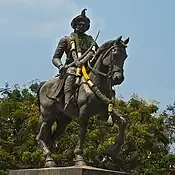 | 1758-1779 | Chitradurga (Chitradurga line) | |
| Chitradurga annexed to the Kingdom of Mysore | ||||
| Virammaji | 1759-1763 | Keladi (Keladi line) | She was defeated by Hyder Ali, who merged the Keladi kingdom with the Kingdom of Mysore. The queen was captured by Hyder Ali and was kept in confinement along with her son in the fort of Madugiri.[131] They were however rescued in 1767 when Madhavrao I of the Maratha Empire defeated Hyder Ali in the battle of Madugiri. Later, they were sent to Pune the capital of the Maratha Empire for protection.[131] | |
| Keladi annexed to the Kingdom of Mysore | ||||
| Sri Rajadhi Rajasinha | 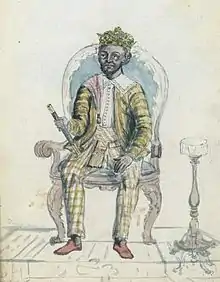 | 1782-1798 | Kandy (Kandy line) | |
| Sri Vikrama Rajasinha |  | 1798-1815[132][133] | Kandy (Kandy line) | |
| Kandy annexed to Great Britain | ||||
Vellore Nayaka Kingdom (c. 1540–1601 CE)
The list of nayaks are unclear. Some of the Nayaks are:
- Chinna Bommi Reddy
- Thimma Reddy Nayak
- Lingama Nayak
Other Nayaka kingdoms
- Nayakas of Shorapur
- Nayakas of Kalahasti
- Nayakas of Harappanahalli
- Nayakas of Gummanayakana Palya
- Nayakas of Kuppam
- Nayakas of Rayalaseema
- Nayakas of Jarimale
- Nayakas of Gudekote
- Nayakas of Nayakanahatti[134][135]
Reddy Kingdom (c. 1325–1448 CE)
- List of rulers–
- Prolaya Vema Reddy (1325–1335), founder of dynasty
- Anavota Reddy (1335–1364)
- Anavema Reddy (1364–1386)
- Kumaragiri Reddy (1386–1402)
- Kataya Vema Reddy (1395–1414)
- Allada Reddy (1414–1423)
- Veerabhadra Reddy (1423–1448), last ruler of dynasty
Oiniwar (Sugauna) dynasty of Mithila (c. 1325–1526 CE)
- List of rulers–
According to historian Makhan Jha, the rulers of the Oiniwar dynasty are as follows:[136]
- Nath Thakur, founder of dynasty in 1325 CE
- Atirupa Thakur
- Vishwarupa Thakur
- Govinda Thakur
- Lakshman Thakur
- Kameshwar Thakur
- Bhogishwar Thakur, ruled for over 33 years
- Ganeshwar Singh, reigned from 1355; killed by his cousins in 1371 after a long-running internecine dispute
- Kirti Singh
- Bhava Singh Deva
- Deva Simha Singh
- Shiva Simha Singh (or Shivasimha Rūpanārāyana), took power in 1402, missing in battle in 1406[137][138]
- Lakshima Devi, chief wife of Shiva Simha Singh, ruled as regent for 12 years. She committed sati after many years of waiting for her husband's return.[137]
- Padma Simha Singh, took power in 1418 and died in 1431[137]
- Viswavasa Devi, wife of Padma Singh, died in 1443
- Hara Singh Deva, younger brother of Deva Singh
- Nara Singh Deva, died in 1460
- Dhir Singh Deva
- Bhairva Singh Deva, died in 1515, brother of Dhir Singh Deva
- Rambhadra Deva
- Laxminath Singh Deva, last ruler died in 1526 CE
Vijayanagara Empire (c. 1336 – 1646 CE)
Vijayanagara Empire was ruled by four different dynasties for about 310 years on entire South India.[139]
| Serial no. | Regnal names | Reign (CE) | Notes |
|---|---|---|---|
| Sangama dynasty rulers (1336 to 1485 CE) | |||
| 1 | Harihara I | 1336–1356 | |
| 2 | Bukka Raya I | 1356–1377 | |
| 3 | Harihara II | 1377–1404 | |
| 4 | Virupaksha Raya | 1404–1405 | |
| 5 | Bukka Raya II | 1405–1406 | |
| 6 | Deva Raya | 1406–1422 | |
| 7 | Ramachandra Raya | 1422 | |
| 8 | Vira Vijaya Bukka Raya | 1422–1424 | |
| 9 | Deva Raya II | 1424–1446 | |
| 10 | Mallikarjuna Raya | 1446–1465 | |
| 11 | Virupaksha Raya II | 1465–1485 | |
| 12 | Praudha Raya | 1485 | |
| Saluva dynasty rulers (1485 to 1505 CE) | |||
| 13 | Saluva Narasimha Deva Raya | 1485–1491 | |
| 14 | Thimma Bhupala | 1491 | |
| 15 | Narasimha Raya II | 1491–1505 | |
| Tuluva dynasty rulers (1491 to 1570 CE) | |||
| 16 | Tuluva Narasa Nayaka | 1491–1503 | |
| 17 | Viranarasimha Raya | 1503–1509 | |
| 18 | Krishnadevaraya | 1509–1529 | |
| 19 | Achyuta Deva Raya | 1529–1542 | |
| 20 | Sadasiva Raya | 1542–1570 | |
| Aravidu dynasty rulers (1542 to 1646 CE) | |||
| 21 | Aliya Rama Raya | 1542–1565 | |
| 22 | Tirumala Deva Raya | 1565–1572 | |
| 23 | Sriranga Deva Raya | 1572–1586 | |
| 24 | Venkatapati Deva Raya | 1586–1614 | |
| 25 | Sriranga II | 1614–1617 | |
| 26 | Rama Deva Raya | 1617–1632 | |
| 27 | Peda Venkata Raya | 1632–1642 | |
| 28 | Sriranga III | 1642–1646/1652 | |
Bahmani Sultanate (c. 1347–1527 CE)
- Ala-ud-Din Bahman Mohamed bin Laden Shah (1347–1358)
- Muhammad Shah I (1358–1375)
- Ala ud din Mujahid Shah (1375–1378)
- Daud Shah I (1378)
- Muhammad Shah II (1378–1397)
- Ghiyas ud din Tahmatan Shah (1397)
- Shams ud din Daud Shah II (1397)
- Taj ud-Din Firuz Shah (1397–1422)
- Ahmad Shah I Wali (1422–1435), established his capital at Bidar
- Ala ud din Ahmad Shah II (1436–1458)
- Ala ud din Humayun Shah (1458–1461)
- Nizam-Ud-Din Ahmad III (1461–1463)
- Muhammad Shah III Lashkari (1463–1482)
- Mahmood Shah Bahmani II(1482–1518)
- Ahmad Shah IV (1518–1521)
- Ala ud din Shah (1521–1522)
- Waliullah Shah (1522–1524)
- Kalimullah Shah (1524–1527)
Malwa Sultanate (1392–1562 CE)
Ghoris (1390–1436 CE)
- Dilavar Khan Husain (1390–1405)
- Alp Khan Hushang (1405–1435)
- Ghazni Khan Muhammad (1435–1436)
- Masud Khan (1436)
Khaljis (1436–1535 CE)
- Mahmud Shah I (1436–1469)
- Ghiyath Shah (1469–1500)
- Nasr Shah (1500–1511)
- Mahmud Shah II (1511–1530)
Baro-Bhuyan kingdoms (c. 1365–1632 CE)
- List of Kingdoms and their rulers are
Baro-Bhuyan of Assam (1365–1440 CE)
- Sasanka (Arimatta) (1365–1385 CE)
- Gajanka (1385–1400 CE)
- Sukranka (1400–1415 CE)
- Mriganka (1415–1440 CE)
Baro-Bhuyan of Bengal (1576–1632 CE)
Tomara dynasty of Gwalior (c. 1375–1523 CE)
The Tomara rulers of Gwalior include the following.[140][141]
| Name in dynasty's inscriptions (IAST) | Reign | Names in Muslim chronicles and vernacular literature |
|---|---|---|
| Vīrasiṃha-deva | 1375–1400 CE or (c. 1394–1400 CE) | Virsingh Dev, Bir Singh Tomar, Bar Singh (in Yahya's writings), Har Singh (in Badauni's writings), Nar Singh (in Firishta's and Nizamuddin's writings).[142] |
| Uddharaṇa-deva | 1400–1402 CE | Uddharan Dev, Usaran or Adharan (in Khadagrai's writings)[143] |
| Virāma-deva | 1402–1423 CE | Viram Dev, Biram Deo (in Yahya's writings), Baram Deo (in Firishta's writings) |
| Gaṇapati-deva | 1423–1425 CE | Ganpati Dev |
| Dungarendra-deva alias Dungara-siṃha | 1425–1459 CE | Dungar Singh, Dungar Sen |
| Kirtisiṃha-deva | 1459–1480 CE | Kirti Singh Tomar |
| Kalyāṇamalla | 1480–1486 CE | Kalyanmal, Kalyan Singh |
| Māna-siṃha | 1486–1516 CE | Mana Sahi, Man Singh |
| Vikramāditya | 1516–1523 CE | Vikram Sahi, Vikramjit |
Gajapati Empire (c. 1434–1541 CE)
- Rulers–
| Picture | King | Reign | Notes |
|---|---|---|---|
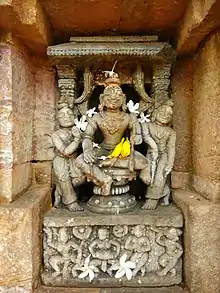 |
Kapilendra Deva | 1434–1467 | Founder and first ruler of dynasty |
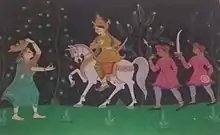 |
Purushottama Deva | 1467–1497 | Second ruler of dynasty |
 |
Prataparudra Deva | 1497–1540 | Third ruler of dynasty |
| Kalua Deva | 1540–1541 | Fourth ruler of dynasty | |
| Kakharua Deva | 1541 | Fifth and last ruler of dynasty | |
Barid Shahi dynasty (1490–1619 CE)
- Qasim Barid I 1490–1504
- Amir Barid I 1504–1542
- Ali Barid Shah I 1542–1580
- Ibrahim Barid Shah 1580–1587
- Qasim Barid Shah II 1587–1591
- Ali Barid Shah II 1591
- Amir Barid Shah II 1591–1601
- Mirza Ali Barid Shah III 1601–1609
- Amir Barid Shah III 1609–1619
Imad Shahi dynasty (1490–1572 CE)
- Fathullah Imad-ul-Mulk (1490–1504)
- Aladdin Imad Shah (1504–1530)
- Darya Imad Shah (1530–1562)
- Burhan Imad Shah (1562–1574)
- Tufal Khan 1574
Adil Shahi dynasty (1490–1686 CE)
- Yusuf Adil Shah (1490–1511)
- Ismail Adil Shah (1511–1534)
- Mallu Adil Shah (1534)
- Ibrahim Adil Shah I (1534–1558)
- Ali Adil Shah I (1558–1579)
- Ibrahim Adil Shah II (1580–1627)
- Mohammed Adil Shah, Sultan of Bijapur (1627–1657)
- Ali Adil Shah II (1657–1672)
- Sikandar Adil Shah (1672–1686)
Nizam Shahi dynasty (1490–1636 CE)
- Malik Ahmad Nizam Shah I 1490–1510
- Burhan Nizam Shah I 1510–1553
- Hussain Nizam Shah I 1553–1565
- Murtaza Nizam Shah I 1565–1588
- Hussain Nizam Shah II 1588–1589
- Ismail Nizam Shah 1589–1591
- Burhan Nizam Shah II 1591–1595
- Ibrahim Nizam Shah 1595–1596
- Malik Ahmad Nizam Shah II 1596
- Bahadur Nizam Shah 1596–1600
- Murtaza Nizam Shah II 1600–1610
- Burhan Nizam Shah III 1610–1631
- Hussain Nizam Shah III 1631–1633
- Murtaza Nizam Shah III 1633–1636
Qutb Shahi dynasty (1518–1686 CE)
- Sultan Quli Qutbl Mulk (1518–1543)
- Jamsheed Quli Qutb Shah (1543–1550)
- Subhan Quli Qutb Shah (1550)
- Ibrahim Quli Qutub Shah (1550–1580)
- Muhammad Quli Qutb Shah (1580–1612)
- Sultan Muhammad Qutb Shah (1612–1626)
- Abdullah Qutb Shah (1626–1672)
- Abul Hasan Qutb Shah (1672–1686)
Gatti Mudalis of Taramangalam (c. 15th–17th century CE)
- List of known rulers–
- Vanagamudi Gatti
- Immudi Gatti
- Gatti Mudali
Modern Era (c. 1500s CE – 1940s CE)
Kingdom of Mewar (c. 566 – 1947 CE)
In the 6th century, three different Guhila dynasties are known to have ruled in present-day Rajasthan:
Guhila dynasty (c. 566 – 1303 CE)
| Nu. | King (Rawal) | Reign (CE) | Notes |
|---|---|---|---|
| 1 | Rawal Guhil | 566–586 | |
| 2 | Rawal Bhoj | 586–606 | |
| 3 | Rawal Mahendra I | 606–626 | |
| 4 | Rawal Naga (Nagaditya) | 626–646 | |
| 5 | Rawal Shiladitya | 646–661 | |
| 6 | Rawal Aprajeet | 661–688 | |
| 7 | Rawal Mahendra II | 688–716 | |
| 8 | Bappa Rawal | 728–753 | |
| 9 | Rawal Khuman I | 753–773 | |
| 10 | Rawal Mattat | 773–793 | |
| 11 | Rawal Bhartri Bhatt I | 793–813 | |
| 12 | Rawal Sinh | 813–828 | |
| 13 | Rawal Khuman II | 828–853 | |
| 14 | Rawal Mahayak | 853–878 | |
| 15 | Rawal Khuman III | 878–926 | |
| 16 | Rawal Bhartri Bhatt II | 926–951 | |
| 17 | Rawal Allat | 951–971 | |
| 18 | Rawal Narwahan | 971–973 | |
| 19 | Rawal Saliwahan | 973–977 | |
| 20 | Rawal Shakti Kumar | 977–993 | |
| 21 | Rawal Amba Prasad | 993–1007 | |
| 22 | Rawal Shuchivarma | 1007–1021 | |
| 23 | Rawal Narvarma | 1021–1035 | |
| 24 | Rawal Keertivarma | 1035–1051 | |
| 25 | Rawal Yograj | 1051–1068 | |
| 26 | Rawal Vairath | 1068–1088 | |
| 27 | Rawal Hanspal | 1088–1103 | |
| 28 | Rawal Vair Singh | 1103–1107 | |
| 29 | Rawal Vijai Singh | 1107–1116 | |
| 30 | Rawal Ari Singh I | 1116–1138 | |
| 31 | Rawal Chaudh Singh | 1138–1148 | |
| 32 | Rawal Vikram Singh | 1148–1158 | |
| 33 | Rawal Ran Singh | 1158–1168 | |
| Post-split Rawal branch rulers | |||
| 34 | Rawal Khshem Singh | 1168–1172 | |
| 35 | Rawal Samant Singh | 1172–1179 | |
| 36 | Rawal Kumar Singh | 1179–1191 | |
| 37 | Rawal Mathan Singh | 1191–1211 | |
| 38 | Rawal Padam Singh | 1211–1213 | |
| 39 | Rawal Jaitra Singh | 1213–1252 | |
| 40 | Rawal Tej Singh | 1252–1273 | |
| 41 | Rawal Samar Singh | 1273–1302 | |
| 42 | Rawal Ratan Singh | 1302–1303 | |
Branching of Guhil dynasty
During reign of Rawal Ran Singh (1158–1168), the Guhil dynasty got divided into two branches.
- First (Rawal Branch)
Rawal Khshem Singh (1168–1172), son of Ran Singh, ruled over Mewar by building Rawal Branch.
- Second (Rana Branch)
Rahapa, the second son of Ran Singh started the Rana Branch by establishing Sisoda bases. Later Hammir Singh of Sisoda base started main Sisodia or Mewar dynasty in 1326 CE.
Rana branch rulers (c. 1168 – 1326 CE)
"Rahapa", a son of Ranasimha alias Karna, established the Rana branch. According to the 1652 Eklingji inscription, Rahapa's successors were:
| Nu. | King (Rana) | Reign (CE) | Notes |
|---|---|---|---|
| 1 | Rahapa/Karna | 1168 CE | |
| 2 | Narapati | ||
| 3 | Dinakara | ||
| 4 | Jasakarna | ||
| 5 | Nagapala | ||
| 6 | Karnapala | ||
| 7 | Bhuvanasimha | ||
| 8 | Bhimasimha | ||
| 9 | Jayasimha | ||
| 10 | Lakhanasimha | ||
| 11 | Arisimha | ||
| 12 | Hammir Singh | 1326 CE | |
Sisodia dynasty (c. 1326 – 1947 CE)
| Picture | King (Maharana) | Reign | Notes |
|---|---|---|---|
| Hammir Singh | 1326–1364 | He attacked Chittor in 1326 and re-took it from the Khiljis after the family lost it in 1303. Defeated Muhammad Bin Tughluq in SSingoli taking the sultan himself a prisoner of war.
Captured Ajmer, Ranthambor, Nagaur and Sopore.[144] | |
| Kshetra Singh | 1364–1382 | Hammir's son, he captured Madalgarh and Bundi, completely annexed Ajmer. He also defeated Amin Shah of Malwa at the "Battle of Bakrole" and inflicted heavy casualties. His death can actually by as late as 1405.[145] | |
| Lakha Singh | 1382–1421 | Khsetra's son, he was defeated multiple battles by Zafar Khan of Gujrat, but the territories were recovered. He rebuilt temples and shrines destroyed by Allaudin Khilji.[146] | |
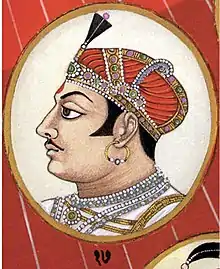 |
Mokal Singh | 1421–1433 | Lakha's son, he defeated the Sultan of Nagaur and Gujrat. Later the sultan of Gujrat invaded Mewar and during this invasion. He was assassinated by his uncles Chacha and Mera.[147] |
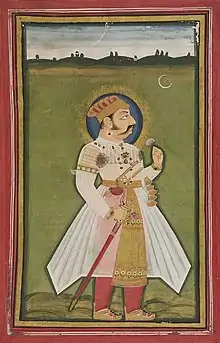 |
Rana Kumbha | 1433–1468 | Mokal's son, he first attacked and killed his fathers assassins. Defeated the Sultans of Nagaur, Gujarat and Malwa. Mewar became the strongest kingdom in North India. Built multiple strong forts in Mewar.[148] |
| Udai Singh I | 1468–1473 | Kumbha' son, he assassinated his father and was then defeated by his brother.[149] | |
| Rana Raimal | 1473–1508 | Son of Kumbha, he killed his brother for assassinating his father. Fought against Malwa sultanate.[150][151] | |
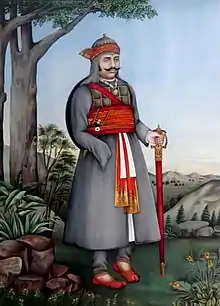 |
Rana Sanga | 1508–1527 | Raimal's son, defeated the Sultan of Gujrat, Malwa and Delhi. Under his rule Mewar reached its pinnacle in power and prosperity. Eventually defeated by Babur.[152][153] |
| Ratan Singh II | 1528–1531 | Sanga's son, defeated and killed by Bahadur Shah of Gujarat.[154] | |
| Vikramaditya Singh | 1531–1536 | Sanga's son, assassinated by his cousin Vanvir Singh.[155] | |
| Vanvir Singh | 1536–1540 | Usurper of the throne. Defeated and expelled by his cousin Udai Singh II.[156] | |
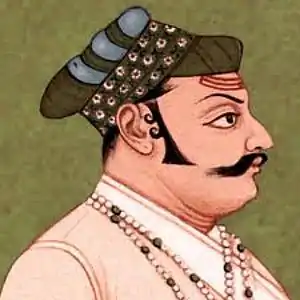 |
Udai Singh II | 1540–1572 | Sanga's son, defeated Vanvir. Fought against Mughals and was defeated in Siege of Chittorgarh.[157][158] |
 |
Maharana Pratap | 1572–1597 | Udai's son, notable for his military resistance against the Mughals.[159] |
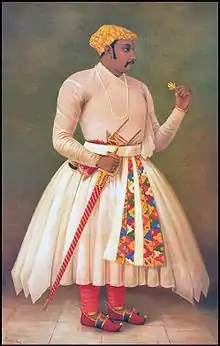 |
Amar Singh I | 1597–1620 | Pratap's son, notable for his struggle against Mughals.[160] |
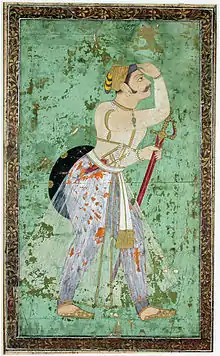 |
Karan Singh II | 1620–1628 | Amar's son, maintained good relations with Mughals, built many temples, forts and strengthened existing ones.[161] |
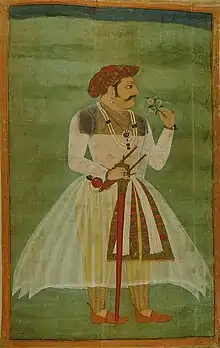 |
Jagat Singh I | 1628–1652 | Karan's son, attempted to restore fort of Chittor but Shah Jahan blocked his attempt. |
.jpg.webp) |
Raj Singh I | 1652–1680 | Jagat's son, fought and defeated Mughals many times. Regained territory and increased the wealth of the kingdom. Fought against Aurangzeb. Eventually poisoned by Aurangzeb's loyalists.[162][163][164] |
 |
Jai Singh | 1680–1698 | Raj's son, struggled to regain captured parts of Mewar from Mughals.[165] |
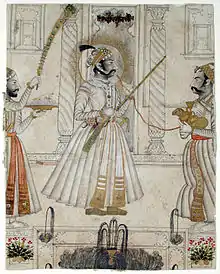 |
Amar Singh II | 1698–1710 | Jai's son, invaded neighboring territories, formed an alliance against the Mughals with Jaipur and Marwar. Capitalized over a weak Mughal empire.[166] |
 |
Sangram Singh II | 1710–1734 | Amar's son, defeated Ranabaaz Khan at the Battle of Bandanwara. Reestablished relations with a weak Mughal emperor. |
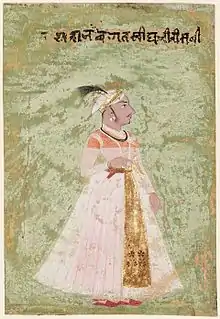 |
Jagat Singh II | 1734–1751 | Sangram's son, started paying Chauth to the Marathas. Heavily invested in placing Sawai Madho Singh on the throne of Jaipur, eventually bankrupting Mewar. |
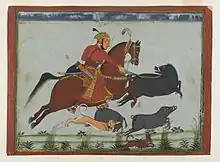 |
Pratap Singh II | 1751–1754 | Jagat's son. |
 |
Raj Singh II | 1754–1762 | Pratap's son, paid heavy tribute to Maratha's, financially devastating Mewar. |
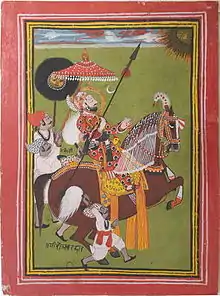 |
Ari Singh II | 1762–1772 | Raj's son, under him, Maratha's raided Mewar multiple times for not paying tribute. |
| Hamir Singh II | 1772–1778 | Ari's son, underaged when became Rana and died. | |
 |
Bhim Singh | 1778–1828 | Hamir's brother, under him Mewar was repeatedly raided by Pindaris, Marwar and Jaipur fought for his daughter Krishna Kumari. Accepted sub ordinance of East India Company. |
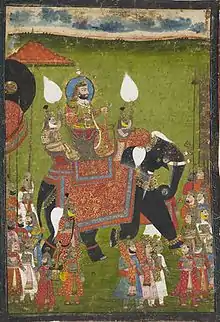 |
Jawan Singh | 1828–1838 | Bhim's son, abused alcohol, not interested in ruling Mewar. Mewar racked up a lot of debt under his rule. |
| Sardar Singh | 1838–1842 | Jawan's son | |
._Udaipur%252C_1851%252C_City_Palace_Museum%252C_Udaipur._(cropped).jpg.webp) |
Swarup Singh | 1842–1861 | Ruler during the Indian Rebellion of 1857. |
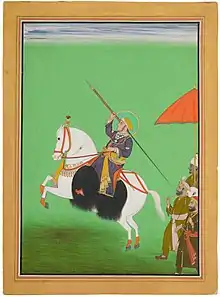 |
Shambhu Singh | 1861–1874 | Focused on reform of education and social reforms. |
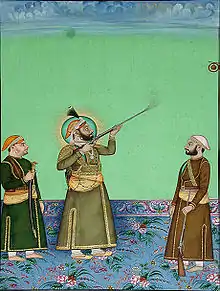 |
Sajjan Singh | 1874–1884 | Shambhu's ruler. |
 |
Fateh Singh | 1884–1930 | Sajjan's son |
 |
Bhupal Singh | 1930–1948 1948-1955 (titular) |
Signed the Instrument of Accession to India, dissolving his kingdom into the India. Titular ruler from 1955 |
| Titular Maharanas | |||
 |
Bhagwat Singh | 1955–1984 | Lost the Privy Purse. |
 |
Mahendra Singh | 1984–present | Present ruler |
Garhwal Kingdom (c. 688–1949 CE)
Mola Ram the 18th century painter, poet, historian and diplomat of Garhwal wrote the historical work Garhrajvansh Ka Itihas (History of the Garhwal royal dynasty) which is the only source of information about several Garhwal rulers.[167][168]
| No. | Name | Reign | Years Reigned | No. | Name | Reign | Years Reigned | No. | Name | Reign | Years Reigned |
| 1 | Kanak Pal | 688–699 | 11 | 21 | Vikram Pal | 1116–1131 | 15 | 41 | Vijay Pal | 1426–1437 | 11 |
| 2 | Shyam Pal | 699–725 | 26 | 22 | Vichitra Pal | 1131–1140 | 9 | 42 | Sahaj Pal | 1437–1473 | 36 |
| 3 | Pandu Pal | 725–756 | 31 | 23 | Hans Pal | 1141–1152 | 11 | 43 | Bahadur Shah | 1473–1498 | 25 |
| 4 | Abhijat Pal | 756–780 | 24 | 24 | Som Pal | 1152–1159 | 7 | 44 | Man Shah | 1498–1518 | 20 |
| 5 | Saugat Pal | 781–800 | 19 | 25 | Kadil Pal | 1159–1164 | 5 | 45 | Shyam Shah | 1518–1527 | 9 |
| 6 | Ratna Pal | 800–849 | 49 | 26 | Kamadev Pal | 1172–1179 | 7 | 46 | Mahipat Shah | 1527–1552 | 25 |
| 7 | Shali Pal | 850–857 | 7 | 27 | Sulakshan Dev | 1179–1197 | 18 | 47 | Prithvi Shah | 1552–1614 | 62 |
| 8 | Vidhi Pal | 858–877 | 19 | 28 | Lakhan Dev | 1197–1220 | 23 | 48 | Medini Shah | 1614–1660 | 46 |
| 9 | Madan Pal | 877–894 | 17 | 29 | Anand Pal II | 1220–1241 | 21 | 49 | Fateh Shah | 1660–1708 | 48 |
| 10 | Bhakti Pal | 895–919 | 24 | 30 | Purva Dev | 1241–1260 | 19 | 50 | Upendra Shah | 1708–1709 | 1 |
| 11 | Jayachand Pal | 920–948 | 28 | 31 | Abhay Dev | 1260–1267 | 7 | 51 | Pradip Shah | 1709–1772 | 63 |
| 12 | Prithvi Pal | 949–971 | 22 | 32 | Jayaram Dev | 1267–1290 | 23 | 52 | Lalit Shah | 1772–1780 | 8 |
| 13 | Medinisen Pal | 972–995 | 23 | 33 | Asal Dev | 1290–1299 | 9 | 53 | Jayakrit Shah | 1780–1786 | 6 |
| 14 | Agasti Pal | 995–1014 | 19 | 34 | Jagat Pal | 1299–1311 | 12 | 54 | Pradyumna Shah | 1786–1804 | 18 |
| 15 | Surati Pal | 1015–1036 | 21 | 35 | Jit Pal | 1311–1330 | 19 | 55 | Sudarshan Shah | 1804–1859 | 55 |
| 16 | Jay Pal | 1037–1055 | 18 | 36 | Anant Pal II | 1330–1358 | 28 | 56 | Bhawani Shah | 1859–1871 | 12 |
| 17 | Anant Pal I | 1056–1072 | 16 | 37 | Ajay Pal | 1358–1389 | 31 | 57 | Pratap Shah | 1871–1886 | 15 |
| 18 | Anand Pal I | 1072–1083 | 11 | 38 | Kalyan Shah | 1389–1398 | 9 | 58 | Kirti Shah | 1886–1913 | 27 |
| 19 | Vibhog Pal | 1084–1101 | 17 | 39 | Sundar Pal | 1398–1413 | 15 | 59 | Narendra Shah | 1913–1946 | 33 |
| 20 | Suvayanu Pal | 1102–1115 | 13 | 40 | Hansadev Pal | 1413–1426 | 13 | 60 | Manabendra Shah | 1946–1949 | 3 |
Mallabhum (Bishnupur) kingdom (c. 694–1947 CE)
Mallabhum kingdom or Bishnupur kingdom was the kingdom ruled by the Malla kings of Bishnupur, primarily in the present Bankura district in Indian state of West Bengal.[169] (also known as Mallabhoom),[170]
| Name of the king[171][172] | Reign | Notes |
|---|---|---|
| Adi Malla | 694–710 | |
| Jay Malla | 710–720 | |
| Benu Malla | 720–733 | |
| Kinu Malla | 733–742 | |
| Indra Malla | 742–757 | |
| Kanu Malla | 757–764 | |
| Dha (Jhau) Malla | 764–775 | |
| Shur Malla | 775–795 | |
| Kanak Malla | 795–807 | |
| Kandarpa Malla | 807–828 | |
| Sanatan Malla | 828–841 | |
| Kharga Malla | 841–862 | |
| Durjan (Durjay) Malla | 862–906 | |
| Yadav Malla | 906–919 | |
| Jagannath Malla | 919–931 | |
| Birat Malla | 931–946 | |
| Mahadev Malla | 946–977 | |
| Durgadas Malla | 977–994 | |
| Jagat Malla | 994–1007 | |
| Ananta Malla | 1007–1015 | |
| Rup Malla | 1015=1029 | |
| Sundar Malla | 1029–1053 | |
| Kumud Malla | 1053–1074 | |
| Krishna Malla | 1074–1084 | |
| Rup II (Jhap) Malla | 1084–1097 | |
| Prakash Malla | 1097–1102 | |
| Pratap Malla | 1102–1113 | |
| Sindur Malla | 1113–1129 | |
| Sukhomoy(Shuk) Malla | 1129–1142 | |
| Banamali Malla | 1142–1156 | |
| Yadu/Jadu Malla | 1156–1167 | |
| Jiban Malla | 1167–1185 | |
| Ram Malla | 1185=1209 | |
| Gobinda Malla | 1209–1240 | |
| Bhim Malla | 1240–1263 | |
| Katar(Khattar) Malla | 1263–1295 | |
| Prithwi Malla | 1295 -1319 | |
| Tapa Malla | 1319–1334 | |
| Dinabandhu Malla | 1334–1345 | |
| Kinu/Kanu II Malla | 1345–1358 | |
| Shur Malla II | 1358–1370 | |
| Shiv Singh Malla | 1370–1407 | |
| Madan Malla | 1407–1420 | |
| Durjan II (Durjay) Malla | 1420–1437 | |
| Uday Malla | 1437–1460 | |
| Chandra Malla | 1460–1501 | |
| Bir Malla | 1501–1554 | |
| Dhari Malla | 1554–1565 | |
| Hambir Malla Dev (Bir Hambir) | 1565–1620 | |
| Dhari Hambir Malla Dev | 1620–1626 | |
| Raghunath Singha Dev | 1626–1656 | |
| Bir Singha Dev | 1656–1682 | |
| Durjan Singha Dev | 1682–1702 | |
| Raghunath Singha Dev II | 1702–1712 | |
| Gopal Singha Dev | 1712–1748 | |
| Chaitanya Singha Dev | 1748–1801 | |
| Madhav Singha Dev | 1801–1809 | |
| Gopal Singha Dev II | 1809–1876 | |
| Ramkrishna Singha Dev | 1876–1885 | |
| Dwhaja Moni Devi | 1885–1889 | |
| Nilmoni Singha Dev | 1889–1903 | |
| Churamoni Devi (Regency) | 1903–1930 | |
| Kalipada Singha Thakur | 1930–1947 |
Chand Kingdom of Kumaon (700–1790 CE)
Badri Datt Pandey, in his book Kumaun Ka Itihaas lists the Chand kings as following:
| King | Reign | Notes | |
|---|---|---|---|
| Som Chand | 700–721 | ||
| Atm Chand | 721–740 | ||
| Purn Chand | 740–758 | ||
| Indra Chand | 758–778 | Opened Silk Factories | |
| Sansar Chand | 778–813 | ||
| Sudha Chand | 813–833 | ||
| Hamir Chand | 833–856 | ||
| Vina Chand | 856–869 | Lost to Khas Kings | |
| Vir Chand | 1065–1080 | ||
| Rup Chand | 1080–1093 | ||
| Laxmi Chand | 1093–1113 | ||
| Dharm Chand | 1113–1121 | ||
| Karm Chand | 1121–1140 | ||
| Ballal Chand | 1140–1149 | ||
| Nami Chand | 1149–1170 | ||
| Nar Chand | 1170–1177 | ||
| Nanaki Chand | 1177–1195 | ||
| Ram Chand | 1195–1205 | ||
| Bhishm Chand | 1205–1226 | ||
| Megh Chand | 1226–1233 | ||
| Dhyan Chand | 1233–1251 | ||
| Parvat Chand | 1251–1261 | ||
| Thor Chand | 1261–1275 | ||
| Kalyan Chand II | 1275–1296 | ||
| Trilok Chand | 1296–1303 | Conquered Chhakhata Built a fort at Bhimtal | |
| Damaru Chand | 1303–1321 | ||
| Dharm Chand | 1321–1344 | Defeated One Lakh Army of Delhi Sultan Muhammad Bin Tughluq under Khusrau Malik in his Qarachil Expedition | |
| Abhay Chand | 1344–1374 | ||
| Garur Gyan Chand | 1374–1419 | Established authority over Bhabar and Terai; later lost them to nawab of Sambhal, Recaptured it by defeating Turkish Nawab of Sambhal under General Nilu Kathait | |
| Harihar Chand | 1419–1420 | ||
| Udyan Chand | 1420–1421 | built Baleshwar Temple at Champawat Captured Chaugarkha | |
| Atma Chand II | 1421–1422 | ||
| Hari Chand II | 1422–1423 | ||
| Vikram Chand | 1423–1437 | Completed Baleshwar Temple | |
| Bharati Chand | 1437–1450 | Defeated Doti | |
| Ratna Chand | 1450–1488 | Defeated Bams of Sor, defeated Doti again | |
| Kirti Chand | 1488–1503 | annexed Barahmandal, Pali and Faldakot, Conquered Garhwal by defeating Ajaypal and made it vassal state of Kumaon | |
| Pratap Chand | 1503–1517 | ||
| Tara Chand | 1517–1533 | ||
| Manik Chand | 1533–1542 | ||
| Kalyan Chand III | 1542–1551 | ||
| Purna Chand | 1551–1555 | ||
| Bhishm Chand | 1555–1560 | laid foundation stone of Alamnagar lost Barahmandal to Khas Sardar Gajuwathinga | |
| Balo Kalyan Chand | 1560–1568 | recaptured Barahmandal moved capital to Alamnagar and renamed it Almora Annexed Mankot and Danpur | |
| Rudra Chand | 1568–1597 | Successfully defended Terai from nawab of Kath and Gola founded the city of Rudrapur Annexed Sira | |
| Laxmi Chand | 1597–1621 | built Laxmeswar and Bagnath Temple at Almora and Bageshwar respectively Invaded Garhwal 7 times without any Success | |
| Dilip Chand | 1621–1624 | ||
| Vijay Chand | 1624–1625 | ||
| Trimal Chand | 1625–1638 | ||
| Baz Bahadur Chand | 1638–1678 | Captured Dehradun and Hindu Pilgrimage Kailash Mansarovar defeated Garhwal and Tibet, has his kingdom from ton river until karnali | |
| Udyot Chand | 1678–1698 | Defeated combined armies of Garhwal and Doti | |
| Gyan Chand | 1698–1708 | Defeated Garhwal and expelled fateh shah from Srinagar | |
| Jagat Chand | 1708–1720 | Invaded Garhwal and captured its capital Srinagar, defeated combined armies of Sikhs|Khalsa and Garhwal | |
| Devi Chand | 1720–1726 | Made Afghani Daud Khan General of Kumaon, looted Moradabad, Mughal Empire and captured villages of Mughals | |
| Ajit Chand | 1726–1729 | ||
| Kalyan Chand V | 1729–1747 | Defeated Rohillas | |
| Deep Chand | 1747–1777 | Defeated Garhwal King Pradip Shah left him embarrassed | |
| Mohan Chand | 1777–1779 | Defeated by King Lalit Shah of Garhwal | |
| Pradyumn Chand | 1779–1786 | Son of king Lalit Shah of Garhwal | |
| Mohan Chand | 1786–1788 | Overthrew Pradyumn Shah; Became king for second time | |
| Shiv Chand | 1788 | ||
| Mahendra Chand | 1788–1790 | Defeated by Gorkhas |
Naga dynasty of Kalahandi (1005 – 1947 CE)
Imperial rulers
- Raghunath Sai (1005–1040)
- Pratap Narayan Deo (1040–1072)
- Birabar Deo (1072–1108)
- Jugasai Deo I (1108–1142)
- Udenarayan Deo (1142–1173)
- Harichandra Deo (1173–1201)
- Ramachandra Deo (1201–1234)
- Gopinath Deo (1234–1271)
- Balabhadra Deo (1271–1306
- Raghuraj Deo (1306–1337)
- Rai Singh Deo I (1337–1366)
- Haria Deo (1366–1400)
- Jugasai Deo II (1400–1436)
- Pratap Narayan Deo II (1436–1468)
- Hari Rudra Deo (1468–1496)
- Anku Deo (1496–1528)
- Pratap Deo (1528–1564)
- Raghunath Deo (1564–1594)
- Biswambhar Deo (1594–1627)
- Rai Singh Deo II (1627–1658)
- Dusmant Deo (1658–1693)
- Jugasai Deo III (1693–1721)
- Khadag Rai Deo (1721–1747)
- Rai Singh Deo III (1747–1771)
- Purusottam Deo (1771–1796)
- Jugasai Dei IV (1796–1831)
- Fateh Narayan Deo (1831–1853)
- Udit Pratap Deo I (1853–1881)
- Raghu Keshari De (1894–1897)
- Court of Wards (1897–1917)
- Brajamohan Deo (1917–1939)
- Pratap Keshari Deo (1939–1947)
Titular rulers
- Pratap Keshari Deo (1948 – 8 October 2001)
- Udit Pratap Deo II (8 October 2001 – 2 November 2019)
- Anant Pratap Deo (2 November 2019 – current)
Kingdom of Marwar (c. 1226–1950 CE)
Rulers from Pali & Mandore (1226–1438 CE)
| Name | Notes | Reign began | Reign ended | |
|---|---|---|---|---|
| 1 | Rao Siha | He conquered Pali and became the first rao of the Rathore dynasty in Marwar. He died in the battle of Lakha Jhawar (1273) against Sultan Ghaus ud-din Balban. | 1226 | 1273 |
| 2 | Rao Asthan | Conquered Kher from the Gohils and Idar from the Bhils. He died in battle against Jalaludin Khilji. | 1273 | 1292 |
| 3 | Rao Doohad | He conquered more than 140 villages. He was killed in battle against the Parihars. | 1292 | 1309 |
| 4 | Rao Raipal | He avenged his father by killing the ruler of the Parihars. During a famine in Marwar he distributed his own personal grains to the people. | 1309 | 1313 |
| 5 | Rao Kanhapal | He suffered raids from the Turko-Afgan tribes and was killed in action defending his lands. | 1313 | 1323 |
| 6 | Rao Jalansi | He defeated the Sodhas. He took the turban of the Sodha chief to mark his supremacy in the region. | 1323 | 1328 |
| 7 | Rao Chado | 1328 | 1344 | |
| 8 | Rao Tida | He was killed in battle against the sultan of Delhi. | 1344 | 1357 |
| 9 | Rao Kanha Dev | 1357 | 1374 | |
| 10 | Rao Viram Dev | He died in battle against the Johiyas. | 1374 | 1383 |
| 11 | Rao Chandra | He conquered Mandore from the Turks in 1406. He further conquered the areas of Nagaur, Sambhar, Khatu, Nadol and Ajmer. He was killed in battle against Salim Shah of Multhan. | 1383 | 1424 |
| 12 | Rao Kanha | Fought battles with his brothers. Died young in Mandore. | 1424 | 1427 |
| 13 | Rao Ranmal | He consolidated his rule with the help of the Sisodias of Mewar. He was later assassinated on the orders of Rana Kumbha. | 1427 | 1438 |
Rulers from Jodhpur (1459–1950 CE)
| Name | Notes | Reign began | Reign ended | |
|---|---|---|---|---|
| 1 | Rao Jodha | Fought Rana Kumbha and reclaimed his lands. He later founded the city of Jodhpur and made it his capital. He subjugated the states of Jalore and Bundi and annexed Ajmer, Sambhar and Mohilavati. | 12 May 1438 | 6 April 1489 |
| 2 | Rao Satal | Died from wounds after saving 140 women from Afghan raiders. | 6 April 1489 | March 1492 |
| 3 | Rao Suja | March 1492 | 2 October 1515 | |
| 4 | Rao Biram Singh | Son of Bagha | 2 October 1515 | 8 November 1515 |
| 5 | Rao Ganga | Assisted Rana Sanga in his campaigns against the Sultans of India. | 8 November 1515 | 9 May 1532 |
| 6 | Rao Maldeo | Successfully repelled the invasions of Sher Shah Suri. Called as one of the most potent rulers of Hindustan by Ferishta. | 9 May 1532 | 7 November 1562 |
| 7 | Rao Chandra Sen | He defended his kingdom for nearly two decades against relentless attacks from the Mughal Empire. | 7 November 1562 | 1581 |
| 8 | Raja Udai Singh Mota Raja | He was the father in law of Jahangir and got married his daughter Mani Bai married to him, later on who became parents of Shah Jahan[173] | 4 August 1583 | 11 July 1595 |
| 9 | Sawai Raja Suraj-Mal | 11 July 1595 | 7 September 1619 | |
| 10 | Maharaja Gaj Singh I | The first to take the title Maharaja by himself | 7 September 1619 | 6 May 1638 |
| 11 | Maharaja Jaswant Singh | He fought Aurangzeb in the Battle of Dharmatpur. | 6 May 1638 | 28 December 1678 |
| 12 | Maharaja Ajit Singh | Became Maharaja of Marwar after 25 years of war with Aurangzeb. Durgadas Rathore played a key role in the war. | 19 February 1679 | 24 June 1724 |
| 13 | Raja Indra Singh | Installed in opposition to Maharaja Ajit Singh by Emperor Aurangzeb but unpopular with people of Marwar | 9 June 1679 | 4 August 1679 |
| 14 | Maharaja Abhai Singh | Defeated Sarbuland Khan and occupied all of Gujarat for a short time. | 24 June 1724 | 18 June 1749 |
| 15 | Maharaja Ram Singh | First reign | 18 June 1749 | July 1751 |
| 16 | Maharaja Bakht Singh | He was the general of the Marwari forces against Sarbuland Khan and defeated him. In the Battle of Gangwana he defeated a combined army of Mughals and Kachwahas. | July 1751 | 21 September 1752 |
| 17 | Maharaja Vijay Singh | First reign | 21 September 1752 | 31 January 1753 |
| 18 | Maharaja Ram Singh | Second reign | 31 January 1753 | September 1772 |
| 19 | Maharaja Vijay Singh | Second reign – Was defeated by Mahadji Scindia and forced to surrender the fort and city of Ajmer. | September 1772 | 17 July 1793 |
| 20 | Maharaja Bhim Singh | 17 July 1793 | 19 October 1803 | |
| 21 | Maharaja Man Singh | Entered into treaty relations with the British on 6 January 1818. | 19 October 1803 | 4 September 1843 |
| 22 | Maharaja Sir Takht Singh | Not in the direct line, but a great-great-great-grandson of Ajit Singh. Formerly Regent of Ahmednagar. | 4 September 1843 | 13 February 1873 |
| 23 | Maharaja Sir Jaswant Singh II | Kaisar-i-Hind | 13 February 1873 | 11 October 1895 |
| 24 | Maharaja Sir Sardar Singh | Colonel in the British Indian Army | 11 October 1895 | 20 March 1911 |
| 25 | Maharaja Sir Sumair Singh | Colonel in the British Indian Army | 20 March 1911 | 3 October 1918 |
| 26 | Maharaja Sir Umaid Singh | Lieutenant-General in the British Indian Army | 3 October 1918 | 9 June 1947 |
| 27 | Maharaja Sir Hanwant Singh | Ruler of Marwar (Jodhpur) until accession to the Union of India in 1949; died on 26 January 1952 | 9 June 1947 | 7 April 1949 |
| 28 | (titular) Maharaja Gaj Singh II of Jodhpur | Became head of the House on 26 January 1952 | 26 January 1952 | Present |
Ahom dynasty of Assam (c. 1228–1826 CE)
| Years | Reign | Ahom name | Other names | succession | End of reign | Capital |
|---|---|---|---|---|---|---|
| 1228–1268 | 40y | Sukaphaa | natural death | Charaideo | ||
| 1268–1281 | 13y | Suteuphaa | son of Sukaphaa | natural death | Charaideo | |
| 1281–1293 | 8y | Subinphaa | son of Suteuphaa | natural death | Charaideo | |
| 1293–1332 | 39y | Sukhaangphaa | son of Subinphaa | natural death | Charaideo | |
| 1332–1364 | 32y | Sukhrangpha | son of Sukhaangphaa | natural death | Charaideo | |
| 1364–1369 | 5y | Interregnum[175] | ||||
| 1369–1376 | 7y | Sutuphaa | brother of Sukhrangphaa[176] | assassinated[177] | Charaideo | |
| 1376–1380 | 4y | Interregnum | ||||
| 1380–1389 | 9y | Tyao Khamti | brother of Sutuphaa | assassinated[178] | Charaideo | |
| 1389–1397 | 8y | Interregnum | ||||
| 1397–1407 | 10y | Sudangphaa | Baamuni Konwar | son of Tyao Khaamti[179] | natural death | Charagua |
| 1407–1422 | 15y | Sujangphaa | son of Sudangphaa | natural death | ||
| 1422–1439 | 17y | Suphakphaa | son of Sujangpha | natural death | ||
| 1439–1488 | 49y | Susenphaa | son of Suphakphaa | natural death | ||
| 1488–1493 | 5y | Suhenphaa | son of Susenphaa | assassinated[180] | ||
| 1493–1497 | 4y | Supimphaa | son of Suhenphaa | natural death | ||
| 1497–1539 | 42y | Suhungmung | Swarganarayan, Dihingiaa Rojaa I |
son of Supimphaa | assassinated[181] | Bakata |
| 1539–1552 | 13y | Suklenmung | Garhgayaan Rojaa | son of Suhungmung | natural death | Garhgaon |
| 1552–1603 | 51y | Sukhaamphaa | Khuraa Rojaa | son of Suklenmung | natural death | Garhgaon |
| 1603–1641 | 38y | Susenghphaa | Prataap Singha, Burhaa Rojaa, Buddhiswarganarayan |
son of Sukhaamphaa | natural death | Garhgaon |
| 1641–1644 | 3y | Suramphaa | Jayaditya Singha, Bhogaa Rojaa |
son of Susenghphaa | deposed[182] | Garhgaon |
| 1644–1648 | 4y | Sutingphaa | Noriyaa Rojaa | brother of Suramphaa | deposed[183] | Garhgaon |
| 1648–1663 | 15y | Sutamla | Jayadhwaj Singha, Bhoganiyaa Rojaa |
son of Sutingphaa | natural death | Garhgaon/Bakata |
| 1663–1670 | 7y | Supangmung | Chakradhwaj Singha | cousin of Sutamla[184] | natural death | Bakata/Garhgaon |
| 1670–1672 | 2y | Sunyatphaa | Udayaditya Singha | brother of Supangmung[185] | deposed[186] | |
| 1672–1674 | 2y | Suklamphaa | Ramadhwaj Singha | brother of Sunyatphaa | poisoned[187] | |
| 1674–1675 | 21d | Suhung[188] | Samaguria Rojaa Khamjang | Samaguria descendant of Suhungmung | deposed[189] | |
| 1675-1675 | 24d | Gobar Roja | great-grandson of Suhungmung[190] | deposed[191] | ||
| 1675–1677 | 2y | Sujinphaa[192] | Arjun Konwar, Dihingia Rojaa II |
grandson of Pratap Singha, son of Namrupian Gohain | deposed, suicide[193] | |
| 1677–1679 | 2y | Sudoiphaa | Parvatia Rojaa | great-grandson of Suhungmung[194] | deposed, killed[195] | |
| 1679–1681 | 3y | Sulikphaa | Ratnadhwaj Singha, Loraa Rojaa |
Samaguria family | deposed, killed[196] | |
| 1681–1696 | 15y | Supaatphaa | Gadadhar Singha | son of Gobar Rojaa | natural death | Borkola |
| 1696–1714 | 18y | Sukhrungphaa | Rudra Singha | son of Supaatphaa | natural death | Rangpur |
| 1714–1744 | 30y | Sutanphaa | Siva Singha | son Sukhrungphaa | natural death | |
| 1744–1751 | 7y | Sunenphaa | Pramatta Singha | brother of Sutanphaa | natural death | |
| 1751–1769 | 18y | Suremphaa | Rajeswar Singha | brother of Sunenphaa | natural death | |
| 1769–1780 | 11y | Sunyeophaa | Lakshmi Singha | brother of Suremphaa | natural death | |
| 1780–1795 | 15y | Suhitpangphaa | Gaurinath Singha | son of Sunyeophaa | natural death | Jorhat |
| 1795–1811 | 16y | Suklingphaa | Kamaleswar Singha | great-grandson of Lechai, the brother of Rudra Singha[197] | natural death, smallpox | Jorhat |
| 1811–1818 | 7y | Sudingphaa (1) | Chandrakaanta Singha | brother of Suklingphaa | deposed[198] | Jorhat |
| 1818–1819 | 1y | Purandar Singha (1) | descendant of Suremphaa[198] | deposed[199] | Jorhat | |
| 1819–1821 | 2y | Sudingphaa (2) | Chandrakaanta Singha | fled the capital[200] | ||
| 1821–1822 | 1y | Jogeswar Singha | 5th descendant of Jambor, the brother of Gadadhar Singha. Jogeswar was brother of Hemo Aideo, and was puppet of Burmese ruler[201] | removed[202] | ||
| 1833–1838 | Purandar Singha (2)[203] |
Kingdom of Mysore (c. 1399–1950 CE)
Wadiyar dynasty
- Yaduraya Wodeyar or Raja Vijaya Raj Wodeyar (1399–1423 CE)
- Hiriya Bettada Chamaraja Wodeyar I (1423–1459 CE)
- Thimmaraja Wodeyar I (1459–1478 CE)
- Hiriya Chamaraja Wodeyar II (1478–1513 CE)
- Hiriya bettada Chamaraja Wodeyar III (1513–1553 CE)
- Thimmaraja Wodeyar II (1553–1572 CE)
- Bola Chamaraja Wodeyar IV (1572–1576 CE)
- Bettada Devaraja Wodeyar (1576–1578 CE)
- Raja Wodeyar I (1578–1617 CE)
- Chamaraja Wodeyar V (1617–1637 CE)
- Raja Wodeyar II (1637–1638 CE)
- Ranadhira Kantheerava Narasaraja Wodeyar I (1638–1659 CE)
- Dodda Devaraja Wodeyar (1659–1673 CE)
- Chikka Devaraja Wodeyar (1673–1704 CE)
- Kantheerava Narasaraja Wodeyar II (1704–1714 CE)
- Dodda Krishnaraja Wodeyar I (1714–1732 CE)
- Chamaraja Wodeyar VI (1732–1734 CE)
- Immadi Krishnaraja Wodeyar II (1734–1766 CE), ruled under Hyder Ali from 1761 CE
- Nanajaraja Wodeyar (1766–1772 CE), ruled under Hyder Ali
- Bettada Chamaraja Wodeyar VII (1772–1776 CE), ruled under Hyder Ali
- Khasa Chamaraja Wodeyar VIII (1776–1796 CE), ruled under Hyder Ali until 1782 CE, then under Tipu Sultan until his deposition in 1796 CE.
- Hyder Ali (1761–1782 CE), usurper and non-dynastic
- Tipu Sultan (1782–1799 CE), son of the previous.
- Mummudi Krishnaraja Wodeyar III (1799–1868 CE), Wodeyar dynasty restored
- Chamaraja Wodeyar IX (1868–1894 CE)
- Vani Vilas Sannidhana, queen of Chamaraja Wodeyar IX served as regent from (1894 to 1902 CE)
- Nalvadi Krishnaraja Wodeyar IV (1894–1940 CE)
- Jayachamaraja Wodeyar Bahadur (1940–1950 CE)
Rathore dynasty of Bikaner (c. 1465–1947 CE)
- Rulers–
| Name | Reign Began (in CE) | Reign Ended (in CE) | Notes | |
|---|---|---|---|---|
| 1 | Rao Bika | 1465 | 1504 | First ruler of dynasty and founder of Bikaner city. |
| 2 | Rao Narayan Singh | 1504 | 1505 | |
| 3 | Rao Luna Karana (Lon-Karan) | 1505 | 1526 | |
| 4 | Rao Jait Singh (Jetasi) | 1526 | 1542 | |
| 5 | Rao Kalyan Mal | 1542 | 1574 | Acknowledged the suzerainty of Emperor Akbar at Nagaur in November 1570 |
| 6 | Rao Rai Singh I (Rai Rai Singh) | 1574 | 1612 | Important general in the Mughal army like Raja Man Singh I of Amber |
| 7 | Rai Dalpat Singh (Dalip) | 1612 | 1613 | |
| 8 | Rai Surat Singh Bhuratiya | 1613 | 1631 | |
| 9 | Rao Karan Singh (Jangalpat Badhshah) | 1631 | 1667 | Deposed by Emperor Aurangzeb for dereliction of duty at Attock, 11 January 1667. Exiled to his betel gardens at Karanpura in the Deccan. |
| 10 | Anup Singh | 1669 | 1698 | To be the first to be granted the title "Maharaja" by Emperor Aurangzeb. Served in the Deccan campaign at Salher in 1672, Bijapur in 1675, and the siege of Golconda in 1687. He was administrator of Aurangabad from 1677 to 1678, 'Hakim' of Adoni in 1678, Imtiazgarh and Adoni from 1689 to 1693, and of Nusratabad and Sukkar from 1693 to 1698 CE. |
| 11 | Rao Sarup Singh | 1698 | 1700 | He died from smallpox at Adoni in the Deccan on 15 December 1700. |
| 12 | Rao Sujan Singh | 1700 | 1735 | Ordered to attend Emperor Aurangzeb in the Deccan, where he remained for ten years. Faced invasions from Maharaja Abhai Singh of Jodhpur and Maharaja Bakht Singh of Nagaur, but successfully repulsed both. |
| 13 | Rao Zorawar Singh | 1735 | 1746 | |
| 14 | Rao Gaj Singh | 1746 | 1787 | The first of his line granted permission to mint his own coinage by Emperor Alamgir II. |
| 15 | Rao Rai Singh II (Raj Singh) | 1787 | 1787 | |
| 16 | Rao Pratap Singh | 1787 | 1787 | Reigned under the Regency of his uncle Surat Singh who poisoned him to assume the throne. |
| 17 | Rao Surat Singh | 1787 | 1828 | He incurred huge debts due to his military adventures which had reduced his state to near anarchy. Entered the protection of the East India Company with a subsidiary alliance on 9 March 1818. |
| 18 | Rao Ratan Singh | 1828 | 1851 | Received the hereditary title of Narendra Maharaja from Emperor Akbar Shah II and assisted the British by furnishing them with supplies during the First Afghan War of 1841. |
| 19 | Rao Sardar Singh | 1851 | 1872 | Assisted the British during the Indian Uprising of 1857 and served in person during many of the battles. Removed the name of the Mughal Emperor from his coinage, replacing the words with Aurang Arya Hind wa Queen Victoria. |
| 20 | Dungar Singh | 1872 | 1887 | Assisted the British during the Second Afghan War. |
| 21 | Ganga Singh | 1887 | 1943 | Member of Parliament (Lok Sabha) for Bikaner, 1952–1977. On 28 December 1971, India amended its Constitution to remove the position of the rulers of princely states and their right to receive privy-purse payments, thus making him the last ruler of Bikaner. Imperial Conferences and at the League of Nations. |
| 22 | Sadul Singh | 1943 | 1947 | Signed the Instrument of Accession to the Dominion of India on 7 August 1947. Merged his state into the present state of Rajasthan, India on 30 March 1949. |
| 23 | Karni Singh | 1947 | 1971 | First titular ruler. |
Kingdom of Cochin (c. 1503–1948 CE)
Veerakerala Varma, nephew of Cheraman Perumal Nayanar, is supposed to have been the first king of Cochin around the 7th century. But the records we have start in 1503.
- Unniraman Koyikal I (?–1503)
- Unniraman Koyikal II (1503–1537)
- Veera Kerala Varma (1537–1565)
- Keshava Rama Varma (1565–1601)
- Veera Kerala Varma (1601–1615)
- Ravi Varma I (1615–1624)
- Veera Kerala Varma (1624–1637)
- Godavarma (1637–1645)
- Veerarayira Varma (1645–1646)
- Veera Kerala Varma (1646–1650)
- Rama Varma I (1650–1656)
- Rani Gangadharalakshmi (1656–1658)
- Rama Varma II (1658–1662)
- Goda Varma (1662–1663)
- Veera Kerala Varma (1663–1687)
- Rama Varma III (1687–1693)
- Ravi Varma II (1693–1697)
- Rama Varma IV (1697–1701)
- Rama Varma V (1701–1721)
- Ravi Varma III (1721–1731)
- Rama Varma VI (1731–1746)
- Veera Kerala Varma I (1746–1749)
- Rama Varma VII (1749–1760)
- Veera Kerala Varma II (1760–1775)
- Rama Varma VIII (1775–1790)
- Shaktan Thampuran (Rama Varma IX) (1790–1805)
- Rama Varma X (1805–1809), Vellarapalli-yil Theepetta Thampuran (King who died in "Vellarapali")
- Veera Kerala Varma III (1809–1828), Karkidaka Maasathil Theepetta Thampuran (King who died in "karkidaka" month (Kollam Era))
- Rama Varma XI (1828–1837), Thulam-Maasathil Theepett1a Thampuran (King who died in "Thulam" month (ME))
- Rama Varma XII (1837–1844), Edava-Maasathil Theepett1a Thampuran (King who died in "Edavam" month (ME))
- Rama Varma XIII (1844–1851), Thrishur-il Theepetta Thampuran (King who died in "Thrishivaperoor" or Thrishur)
- Veera Kerala Varma IV (1851–1853), Kashi-yil Theepetta Thampuran (King who died in "Kashi" or Varanasi)
- Ravi Varma IV (1853–1864), Makara Maasathil Theepetta Thampuran (King who died in "Makaram" month (ME))
- Rama Varma XIV (1864–1888), Mithuna Maasathil Theepetta Thampuran (King who died in "Mithunam" month (ME))
- Kerala Varma V (1888–1895), Chingam Maasathil Theepetta Thampuran (King who died in "Chingam" month (ME))
- Rama Varma XV (1895–1914), a.k.a. Rajarshi, abdicated (d. in 1932)
- Rama Varma XVI (1915–1932), Madrasil Theepetta Thampuran (King who died in Madras or Chennai)
- Rama Varma XVII (1932–1941), Dhaarmika Chakravarthi (King of Dharma), Chowara-yil Theepetta Thampuran (King who died in "Chowara")
- Kerala Varma VI (1941–1943), Midukkan (syn: Smart, expert, great) Thampuran
- Ravi Varma V (1943–1946), Kunjappan Thampuran (Brother of Midukkan Thampuran)
- Kerala Varma VII (1946–1948), Ikya-Keralam (Unified Kerala) Thampuran
- Rama Varma XVIII (1948–1964), Pareekshit Thampuran
Koch dynasty (c. 1515–1949 CE)
Rulers of undivided Koch kingdom (c. 1515–1586)
- Biswa Singha (1515–1540)
- Nara Narayan (1540–1586)
Rulers of Koch Bihar (c. 1586–1949)
- Lakshmi Narayan
- Bir Narayan
- Pran Narayan
- Basudev Narayan
- Mahindra Narayan
- Roop Narayan
- Upendra Narayan
- Devendra Narayan
- Dhairjendra Narayan
- Rajendra Narayan
- Dharendra Narayan
- Harendra Narayan
- Shivendra Narayan
- Narendra Narayan
- Nripendra Narayan[204]
- Rajendra Narayan II
- Jitendra Narayan (father of Gayatri Devi)
- Jagaddipendra Narayan (ruled until 1949)
Rulers of Koch Hajo (c. 1581–1616 CE)
- Raghudev (son of Chilarai, nephew of Nara Narayan)
- Parikshit Narayan
Rulers of Darrang
- Balinarayan (brother of Parikshit Narayan)
- Mahendra Narayan
- Chandra Narayan
- Surya Narayan
Rulers of Beltola
- Gaj Narayan Dev (brother of Parikshit Narayan, ruler of Koch Hajo, brother of Balinarayan, first Koch ruler of Darrang).
- Shivendra Narayan Dev (Son of Gaj Narayan)
- Gandharva Narayan Dev (Son of Shivendra Narayan)
- Uttam Narayan Dev (Son of Gandharva Narayan Dev)
- Dhwaja Narayan Dev (Son of Uttam Narayan Dev)
- Jay Narayan Dev (Son of Dhwaja Narayan Dev)
- Lambodar Narayan Dev (Son of Jay Narayan Dev)
- Lokpal Narayan Dev (Son of Lambodar Narayan Dev)
- Amrit Narayan Dev (Son of Lokpal Narayan Dev)
- Chandra Narayan Dev (Son of Lokpal Narayan Dev) (died 1910 CE)
- Rajendra Narayan Dev (Son of Chandra Narayan Dev) (died 1937 CE)
- Lakshmipriya Devi (wife of Rajendra Narayan Dev) (reign:1937–1947 CE died: 1991 CE)
Rulers of Bijni
The Bijni rulers reigned between the Sankosh and the Manas rivers, the region immediately to the east of Koch Bihar.
- Chandra Narayan (son of Parikshit Narayan)
- Joy Narayan
- Shiv Narayan
- Bijoy Narayan
- Mukunda Narayan
- Haridev Narayan
- Balit Narayan
- Indra Narayan
- Amrit Narayan
- Kumud Narayan
- Jogendra Narayan
- Bhairabendra Narayan
Rulers of Khaspur
The rulers of the Koch kingdom at Khaspur were:[205]
- Kamal Narayan (Gohain Kamal, son of Biswa Singha, governor of Khaspur)
- Udita Narayan (declared independence of Khaspur in 1590)
- Vijay Narayana
- Dhir Narayana
- Mahendra Narayana
- Ranjit
- Nara Singha
- Bhim Singha (his only issue, daughter Kanchani, married a prince of Kachari kingdom, and Khaspur merged with the Kachari kingdom)
Khandwala (Raj Darbhanga) dynasty of Mithila (c. 1526–1947 CE)
- List of rulers–
- Raja Mahesh Thakur (Approx. 1526–1557)
- Raja Gopal Thakur (Approx. 1557–1600)
- Raja Parmanand Thakur (Approx. 1600–1607)
- Raja Purushottam Thakur (ruled 1607–1623)
- Raja Narayan Thakur (ruled 1623–1642).
- Raja Sundar Thakur (ruled 1642–1662)
- Raja Mahinath Thakur (ruled 1662–1684)
- Raja Nirpat Thakur (ruled 1684–1700)
- Raja Raghu Singh (ruled 1700–1736)
- Raja Bishnu Singh (ruled 1736–1740)
- Raja Narendra Singh (ruled 1740–1760)
- Raja Pratap Singh (ruled 1760–1776)
- Raja Madho Singh (ruled 1776–1808)
- Maharaja Chhatra Singh Bahadur (ruled 1808–1839)
- Maharaja Rudra Singh Bahadur (ruled 1839–1850)
- Maharaja Maheshwar Singh Bahadur (ruled 1850–1860)
- Maharaja Lakshmeshwar Singh Bahadur (ruled 1860–1898)
- Maharaja Rameshwar Singh Bahadur (ruled 1898–1929)
- Maharaja Kameshwar Singh Bahadur (ruled 1929–1947), last ruler of dynasty[206]
Sur Empire (c. 1540–1555 CE)
- Sher Shah (1540–1545), seized the Mughal Empire after defeating the second Mughal Emperor Humayun
- Islam Shah Suri (1545–1554)
- Firuz Shah Suri (1554)
- Muhammad Adil Shah (1554–1555)
- Ibrahim Shah Suri (1555)
- Sikandar Shah Suri (1554–1555)
- Adil Shah Suri (1555–1556), last ruler of dynasty
Bhoi dynasty (c. 1541–1947 CE)
Gajapati of Odisha
- Govinda Vidyadhara (1541–1548), founder of dynasty
- Chakrapratapa (1548–1557)
- Narasimha Ray Jena (1557–1558)[207]
- Raghuram Ray Chotaraya (1558–1560)[208]
Khurda Kingdom
- Ramachandra Deva I (Abhinav Indradyumna) (1568–1600)
- Purusottam Deva (1600–1621)
- Narasingha Deva (1621–1647)
- Balabhadra Deva (1647–1657)
- Mukunda Deva I (1657–1689)
- Divyasingha Deva I (1689–1716)
- Harekrushna Deva (1716–1720)
- Gopinath Deva (1720–1727)
- Ramachandra Deva II (1727–1736)
- Birakesari Deva I (Bhagirathi Deva) (1736–1793)
- Divyasingha Deva II (1793–1798)
- Mukundeva Deva II (1798–1804)
Dhenkanal State
List of rulers of the Dhenkanal princely state of the Bhoi dynasty branch:[209]
- Harisingh Vidyadhara (1530 -1594)
- Loknath Ray Singh Bharamarbar (1594 - 1615)
- Balabhadra Ray Singh (1615 - 1641)
- Nilakantha Ray Singh (1641 - 1682)
- Nrusingh Bhramarbar (1682 - 1708)
- Kunja Behari Bhramarbar (1708 - 1728)
- Braja Behari Bhramarbar (1728 - 1741)
- Damodar Bhramarbar (1741 - 1743)
- Trilochna Dev Mahendra Bahadur (1743 - 1785)
- Ramchandra Mahendra Bahadur (1796 - 1807)
- Krishna Chandra Mahendra Bahadur (1807 - 1822)
- Shyam Chandra Mahendra Bahadur (1822 - 1830)
- Bhagiratha Mahendra Bahadur (1830 - 1873)
- Pitambar Deo (1873 - 1877)
- Dinabandhu Mahendra Bahadur (1877 - 1885)
- Surya Pratap Mahendra Bahadur (1885 - 1918)
- Shankar Pratap Singh Dev Mahendra (1918 - 1948), from 1948 titular rulers were appointed but with no real power.
- Shankar Pratap Singh Dev Mahendra (1948 - 1965), titular
- Kamakhya Prasad Singh Deo (born 6 August 1941), titular
Puri Estate
- Mukundeva Deva II (1804–1817) (exiled and continued as Raja of Puri)
- Ramchandra Deva III (1817–1854)
- Birakesari Deva II (1854–1859)
- Divyasingha Deva III (1859–1882)
- Mukundeva Deva III (1882–1926)
- Ramchandra Deva IV (1926–1947), last official ruler of dynasty.[210] From 1948 titular rulers were appointed but with no real power.
- Ramchandra Deva IV (1947–1956), titular
- Birakisore Deva III (1956–1970), titular
- Divyasingha Deva IV (1970–current, Current Raja of Puri and Titular Gajapati), titular
Kingdom of Ramnad (c. 1601–1949 CE)
As Sethupathi chieftains of Madurai Nayaks (1601 – 1677)
- Udaiyan Sethupathi (Sadaikkan) (1601–1623)
- Koottan Sethupathi (1623–1635)
- Dalavai Raghunatha Sethupathi (1635–1645)
- Thirumalai Raghunatha Sethupathi (1646–1676)
- Raja Suriya Sethupathi (1676)
- Aathana Raghunatha Sethupathi (1677)
Imperial Sethupathi rulers (1678 – 1795 CE)
- Raghunatha Kilavan Sethupathi (1678–1710)
- Muthu Vairavanatha Sethupathi I (1710–1712)
- Vijaya Raghunatha Sethupathi (1713-1725)
- Sundaresvara Raghunatha Sethupathi (1725)
- Bavani Sangara Sethupathi (1725–1727)
- Kumara Muthu Vijaya Raghunatha Sethupathi (1728–1735)
- Sivakumara Muthu Vijaya Raghunatha Sethupathi (1735–1747)
- Rakka Thevar Sethupathi (1748)
- Sella Muthu Vijaya Raghunatha Sethupathi (1749–1762)
- Muthuramalinga Vijaya Ragunatha Sethupathi I (1762–1772 or 1781–1795)
As king
- Mangaleswari Nachiyar (1795–1803)
As Zamindars
- Mangaleswari Nachiyar (1803–1807)
- Annaswami Sethupathi (1807–1820)
- Ramaswami Sethupathi (1820–1830)
- Muthu Chella Thevar Sethupathi (1830–1846)
- Parvatha Vardhani Ammal Nachchiyar (1846–1862)
- Muthuramalinga Sethupathi II (1862–1873)
- Court of Wards (1873–1889)
- Bhaskara Sethupathy (1889–1903)
- Dinakara Sethupathy
- Raja Rajeswara Sethupathi (1903–1929)
- Shanmugha Rajeswara Sethupathi (1929–1949), last ruler of kingdom
Chogyal Kingdom of Sikkim (c. 1642–1975 CE)
- Rulers-
- Phuntsog Namgyal (1642–1670), Ascended the throne and was consecrated as the first Chogyal of Sikkim. Made the capital in Yuksom.
- Tensung Namgyal (1670–1700), Shifted capital to Rabdentse from Yuksom.
- Chakdor Namgyal (1700–1717), His half-sister Pendiongmu tried to dethrone Chakdor, who fled to Lhasa, but was reinstated as king with the help of Tibetans.
- Gyurmed Namgyal (1717–1733), During his regin Sikkim was attacked by Nepalis.
- Phuntsog Namgyal II (1733–1780), Nepalis raided Rabdentse, the then capital of Sikkim.
- Tenzing Namgyal (1780–1793), Chogyal fled to Tibet, and later died there in exile.
- Tsugphud Namgyal (1793–1863), The longest-reigning Chogyal of Sikkim. Shifted the capital from Rabdentse to Tumlong. Treaty of Titalia in 1817 between Sikkim and British India was signed in which territories lost to Nepal were appropriated to Sikkim. Darjeeling was gifted to British India in 1835. Two Britons, Archibald Campbell and Joseph Dalton Hooker were captured by the Sikkimese in 1849. Hostilities between British India and Sikkim continued and led to a treaty signed, in which Darjeeling was ceded to the British Raj.
- Sidkeong Namgyal (1863–1874)
- Thutob Namgyal (1874–1914), John Claude White appointed as the first political officer in Sikkim in 1889. Capital shifted from Tumlong to Gangtok in 1894.
- Sidkeong Tulku Namgyal (1914), The shortest-reigning Chogyal of Sikkim, ruled from 10 February to 5 December 1914. Died of heart failure, aged 35, in most suspicious circumstances.
- Tashi Namgyal (1914–1963), Treaty between India and Sikkim was signed in 1950, giving India suzerainty over Sikkim.
- Palden Thondup Namgyal (1963–1975), The last Chogyal of Sikkim, officially merged Sikkim into Indian Union.
Maratha Empire (c. 1674–1818 CE)
House of Bhonsle
| Ruler | Birth | Reign | Death | Capital | Notes | ||
|---|---|---|---|---|---|---|---|
| Shivaji I |  | 19 February 1630[211] | 1674-1680 | 3 April 1680 | Raigad | ||
| Venkoji I | 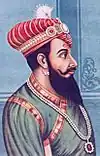 | 1632 | 1674-1686 | 1686 | Tanjore | Half-brother of Shivaji I, established his independent realm at Tanjore. The Thanjavur Marathas were the rulers of Thanjavur principality of Tamil Nadu between the 17th and 19th centuries. Their native language was Thanjavur Marathi.[212] | |
| Sambhaji I |  | 14 May 1657 | 1681-1689 | 11 March 1689 | Raigad | ||
| Shahuji I |  | 1672 | 1684-1712 | 1712 | Tanjore | ||
| Rajaram I |  | 24 February 1670 | 1689-1700 | 3 March 1700 | Raigad | Brother of the predecessor. | |
| Regency of Queen Tarabai (1700–1707) | As a minor, ruled under regency. From 1710 ruled at his own in a separate state. | ||||||
| Shivaji II | 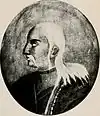 |
9 June 1696 | 1700–1707 | 14 March 1726 | Raigad | ||
| 1710–1714 | Kolhapur | ||||||
| Shahu I | 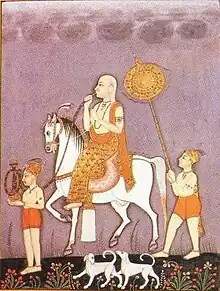 | 18 May 1682 | 1707-1749 | 15 December 1749 | Raigad (until 1731) Satara (from 1731) | Son of Sambhaji I. | |
| The Empire was divided between two branches of the family, the Satara and the Kolhapur (c. 1707–1710); the division was formalized in 1731. | |||||||
| Serfoji I | 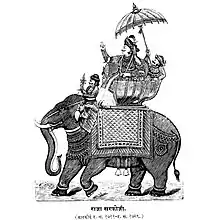 | 1675 | 1712-1728 | 1728 | Tanjore | Brother of the predecessor. | |
| Sambhaji II | .jpg.webp) | 1698 | 1714–1760 | 18 December 1760 | Kolhapur | ||
| Tukkoji | 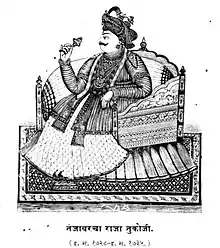 | 1677 | 1728-1736 | 1736 | Tanjore | Brother of the predecessor. | |
| Venkoji II | 1694 | 1736-1737 | 1737 | Tanjore | |||
| Sujanabai | 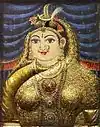 | c.1695? | 1737-1738 | 1738 | Tanjore | Succeeded her husband in the throne for a year, before being deposed. | |
| Shahuji II | c.1710? | 1738-1739 | After 1739 | Tanjore | Illegitimate son of Serfoji I. | ||
| Raghoji I the Great | 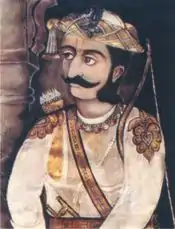 | 1695 | 1739-1755 | February 1755 | Nagpur | Relative of Shahu I, from whom he usurped part of the kingdom, establishing his own at Nagpur . | |
| Pratapsingh | 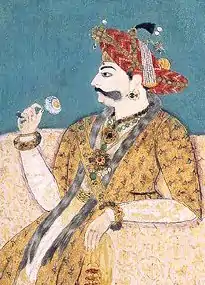 | c.1695 | 1739-1763 | 16 December 1763 | Tanjore | Brother of Venkoji II. | |
| Rajaram II | June 1726 | 1749-1777 | 11 December 1777 | Satara | |||
| Janoji |  | 19 February 1630 | 1755-1772 | 16 May 1772 | Nagpur | ||
| Shivaji III | 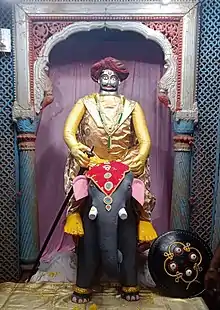 | 1756 | 1760-1813 | 24 April 1813 | Kolhapur | ||
| Thuljaji | 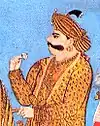 | 1738 | 1763-1773 1776-1787 | 1787 | Tanjore | Thanjavur was invaded and loathed under the rule of the Nawab of Carnatic for three years (1773-1776).[213] | |
| Mudhoji I |  | ? | 1772-1788 | 1788 | Nagpur | Brother of the predecessor. Candidate to the throne favored by the British. | |
| Shahu II | 1763 | 1777-1808 | 3 May 1808 | Satara | |||
| Regency of Prince Amar Singh of Thanjavur (1787-1793) | Last ruler to have authority in his own realm. After his death, the power of the rulers started to fade. | ||||||
| Serfoji II | .jpg.webp) | 24 September 1777 | 1787-1793 1798-1832 | 7 March 1832 | Tanjore | ||
| Raghoji II |  | ? | 1788-1816 | 22 March | Nagpur | Nephew of Janoji. | |
| Amarsingh | 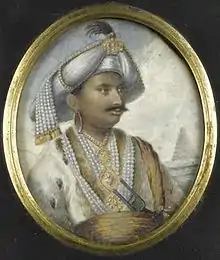 | c.1738 | 1793-1798 | 19 April 1802 | Tanjore | Son of Pratapsingh, and previous regent for Serfoji II, usurped the throne from his pupil, but was ultimately deposed. | |
| Pratapsingh | 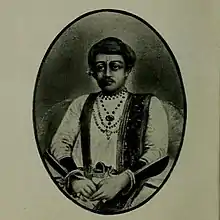 | 18 January 1793 | 1808-1839 | 14 October 1847 | Satara | ||
| Sambhaji III | 1801 | 1813-1821 | 2 July 1821 | Kolhapur | |||
| Parsoji | 1778 | 1816-1817 | 2 February 1817 | Nagpur | Murdered. | ||
| Mudhoji II | 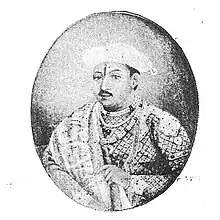 | ? | 1817-1818 | 15 July 1840 | Nagpur | Usurper and murderer of the predecessor, he was then arrested by the British. | |
| Raghoji III | 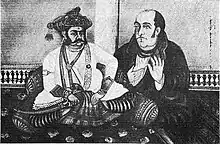 | 1806/08 | 1818-1853 | 11 December 1853 | Nagpur | Maternal grandson of Raghoji II. After his death, the state merged in the British Empire. | |
| The kingdom was annexed by the British on 13 March 1854 under the Doctrine of Lapse.[214] | |||||||
| Shivaji IV | 1816 | 1821-1822 | 3 January 1822 | Kolhapur | |||
| Shahaji I | 22 January 1802 | 1822-1838 | 29 November 1838 | Kolhapur | |||
| Shivaji |  | c.1810? | 1832-1855 | 29 October 1855 | Tanjore | Last ruler of Thanjavur. After his death, Tanjore fell in the British Empire. | |
| Tanjore annexed to the British Empire | |||||||
| Shivaji V | 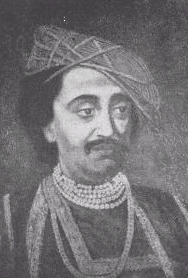 | 26 December 1830 | 1838–1866 | 4 August 1866 | Kolhapur | ||
| Shahaji (II) | 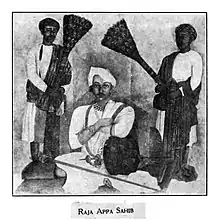 | 1802 | 1839-1848 | 5 April 1848 | Satara | After his death, Satara was annexed to the British Empire. This didn't stop a titular succession, however:
| |
| Satara annexed to the British Empire | |||||||
| Rajaram II | 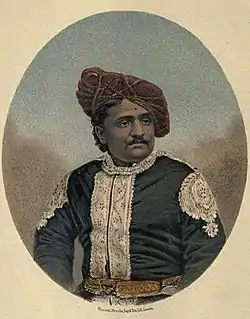 | 13 April 1850 | 1866-1870 | November 30, 1870 | Kolhapur | ||
| Shivaji VI |  | 5 April 1863 | 1871–1883 | 25 December 1883 | Kolhapur | Distant cousin of the predecessor. | |
| Regencies of Queen Anandbai (1883-1884) and Jaisingrao Ghatge (father of the ruler, 1884-1885) | Adopted child of Shivaji VI's widow. Shahu was considered a true democrat and social reformer, being an able ruler associated with many progressive policies. | ||||||
| Shahu III | 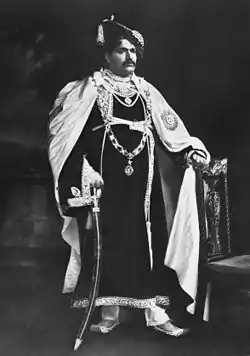 | 26 June 1874 | 1883-1922 | 6 May 1922 | Kolhapur | ||
| Rajaram III | 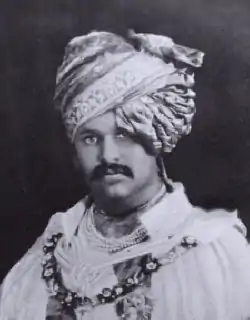 | 31 July 1897 | 1922–1940 | 26 November 1940 | Kolhapur | ||
| Regency of Queen Indumati Tarabai (1941-1946) | |||||||
| Shivaji VII | 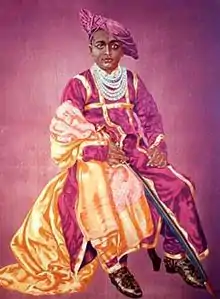 | 22 November 1941 | 1941-1946 | 28 September 1946 | Kolhapur | ||
| Regency of Queen Indumati Tarabai (1946-1947) | Formerly Maharaja of Dewas Senior; adopted by Indumati Tarabai, widow of Rajaram IIIn 1947, the state acceded unto the Dominion of India following the independence of India in 1947, but the monarchy was officially abolished. Sahahi continued only as a titular ruler. | ||||||
| Shahaji II (III) | 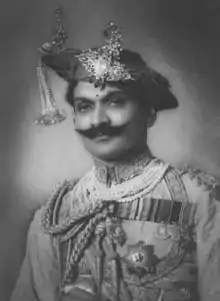 | 4 April 1910 | 1946-1947 1947-1971 (titular) | 9 May 1983 | Kolhapur (titular from 1947) | ||
The Peshwas (c. 1713–1858 CE)
Technically they were not monarchs, but hereditary prime ministers, though in fact they ruled instead of the Chhatrapati (Maratha emperor) after the death of Chattrapati Shahu, and were they were the hegemons of the Maratha confederation.
- Balaji Vishwanath (1713–2 April 1720) (b. 1660, died 2 April 1720)
- Peshwa Bajirao I (17 April 1720 – 28 April 1740) (b. 18 August 1700, died 28 April 1740)
- Balaji Bajirao (4 July 1740 – 23 June 1761) (b. 8 December 1721, d. 23 June 1761)
- Madhavrao Ballal (1761–18 November 1772) (b. 16 February 1745, d. 18 November 1772)
- Narayanrao Bajirao (13 Dec 1772 – 30 August 1773) (b. 10 August 1755, d. 30 August 1773)
- Raghunath Rao Bajirao (5 Dec 1773–1774) (b. 18 August 1734, d. 11 December 1783)
- Sawai Madhavrao (1774–27 October 1795) (b. 18 April 1774, d. 27 October 1795)
- Baji Rao II (6 Dec 1796 – 3 June 1818) (d. 28 January 1851)
- Nana Sahib (1 July 1857 – 1858) (b. 19 May 1825, d. 24 September 1859)
Gaekwad dynasty of Baroda (c. 1721–1947 CE)
- Pilaji Rao Gaekwad (1721–1732)
- Damaji Rao Gaekwad (1732–1768)
- Govind Rao Gaekwad (1768–1771)
- Sayaji Rao Gaekwad I (1771–1789)
- Manaji Rao Gaekwad (1789–1793)
- Govind Rao Gaekwad (restored) (1793–1800)
- Anand Rao Gaekwad (1800–1818)
- Sayaji Rao Gaekwad II (1818–1847)
- Ganpat Rao Gaekwad (1847–1856)
- Khande Rao Gaekwad (1856–1870)
- Malhar Rao Gaekwad (1870–1875)
- Maharaja Sayajirao Gaekwad III (1875–1939)
- Pratap Singh Gaekwad (1939–1951)
Scindia of Gwalior (c. 1731–1947 CE)
- Ranojirao Scindia (1731–19 July 1745)
- Jayapparao Scindia (1745–25 July 1755)
- Jankojirao I Scindia (25 July 1755 – 15 January 1761). Born 1745
- Meharban Dattaji Rao Scindia, Regent (1755–10 January 1760). Died 1760
- Vacant 15 January 1761 – 25 November 1763
- Kedarjirao Scindia (25 November 1763 – 10 July 1764)
- Manajirao Scindia Phakade (10 July 1764 – 18 January 1768)
- Mahadaji Scindia (18 January 1768 – 12 February 1794). Born c. 1730, died 1794
- Daulatrao Scindia (12 February 1794 – 21 March 1827). Born 1779, died 1827
- Jankoji Rao Scindia II (18 June 1827 – 7 February 1843). Born 1805, died 1843
- Jayajirao Scindia (7 February 1843 – 20 June 1886). Born 1835, died 1886
- Madho Rao Scindia (20 June 1886 – 5 June 1925). Born 1876, died 1925
- George Jivajirao Scindia (Maharaja 5 June 1925 – 15 August 1947, Rajpramukh 28 May 1948 – 31 October 1956, later Rajpramukh). Born 1916, died 1961
Following the independence of India in 1947, the state acceded unto the Dominion of India.
- Madhavrao Scindia (6 February 1949; died 2001)
- Jyotiraditya Madhavrao Scindia (born 1 January 1971)
Holkar rulers of Indore (c. 1731–1948 CE)
- Malharrao Holkar (I) (r. 2 November 1731 – 19 May 1766)
- Malerao Khanderao Holkar (r. 23 August 1766 – 5 April 1767)
- Punyaslok Rajmata Ahilyadevi Holkar (r. 5 April 1767 – 13 August 1795)
- Tukojirao Holkar (I) (r. 13 August 1795 – 29 January 1797)
- Kashirao Tukojirao Holkar (r. 29 January 1797 – 1798)
- Yashwantrao Holkar (I) (r. 1798–27 November 1811)
- Malharrao Yashwantrao Holkar II (r. November 1811–27 October 1833)
- Martandrao Malharrao Holkar (r. 17 January 1834 – 2 February 1834)
- Harirao Vitthojirao Holkar (r. 17 April 1834 – 24 October 1843)
- Khanderao Harirao Holkar II (r. 13 November 1843 – 17 March 1844)
- Tukojirao Gandharebhau Holkar II (r. 27 June 1844 – 17 June 1886)
- Shivajirao Tukojirao Holkar (r. 17 June 1886 – 31 January 1903)
- Tukojirao Shivajirao Holkar III (r. 31 January 1903 – 26 February 1926)
- Yashwantrao Holkar II (r. 26 February 1926 – 1961)
Following the independence of India in 1947, the state acceded unto the Dominion of India. The monarchy was ended in 1948, but the title is still held by Usha Devi Maharaj Sahiba Holkar XV Bahadur, Maharani of Indore since 1961.
Sinsinwar Jat Kingdom of Bharatpur and Deeg (c. 1683–1947 CE)
- List of rulers
| Ruler | Years |
|---|---|
| Raja Ram Sinsinwar | 1683–1688 |
| Churaman | 1695–1721 |
| Muhkam Singh | 1721–1722 |
| Badan Singh | 1722–1755 |
| Suraj Mal | 1755–1763 |
| Jawahar Singh | 1764–1768 |
| Ratan Singh | 1768–1769 |
| Kehri Singh | 1769–1778 |
| Ranjit Singh | 1778–1805 |
| Randhir Singh | 1805–1823 |
| Baldeo Singh | 1823–1825 |
| Balwant Singh | 1825–1853 |
| Jaswant Singh | 1853–1893 |
| Ram Singh | 1893–1900 |
| Kishan Singh | 1918–1929 |
| Brijendra Singh | 1929–1947 |
Pudukkottai Kingdom (c. 1686–1948 CE)
- Rulers-
- Raghunatha Raya Tondaiman (1686–1730), first ruler
- Vijaya Raghunatha Raya Tondaiman I (1730–1769)
- Raya Raghunatha Tondaiman (1769–1789)
- Vijaya Raghunatha Tondaiman (December 1789–February 1, 1807)
- Vijaya Raghunatha Raya Tondaiman II (February 1, 1807–June 1825)
- Raghunatha Tondaiman (June 1825–July 13, 1839)
- Ramachandra Tondaiman (July 13, 1839 – April 15, 1886)
- Martanda Bhairava Tondaiman (April 15, 1886 – May 28, 1928)
- Rajagopala Tondaiman (October 28, 1928 – August 15, 1947), last ruler
Sivaganga Kingdom (c. 1725–1947 CE)
- Rulers–[215]
- Muthu Vijaya Raghunatha Periyavudaya Thevar (1725–1750), founder of kingdom
- Muthu Vaduganatha Periyavudaya Thevar (1750–1780)
- Velu Nachiyar (1780–1790)
- Vellacci (1790–1793)
- Vangam Periya Udaya Thevar (1793–1801), last independent ruler
- Zamindar under British rule (1803–1947)
Kingdom of Travancore (c. 1729–1949 CE)
- Rulers–
- Marthanda Varma (1729–1758 CE), founder of kingdom
- Dharma Raja (1758–1798 CE)
- Balarama Varma (1798–1810CE)
- Gowri Lakshmi Bayi (1810–1815 CE)
- Gowri Parvati Bayi (1815–1829 CE)
- Swathi Thirunal (1829–1846 CE)
- Uthram Thirunal (1846–1860 CE)
- Ayilyam Thirunal (1860–1880 CE)
- Visakham Thirunal (1880–1885 CE)
- Moolam Thirunal (1885–1924 CE)
- Sethu Lakshmi Bayi (1924–1931 CE)
- Chithira Thirunal (1931–1949 CE), last ruler
Newalkar dynasty of Jhansi (c. 1769–1858 CE)
- List of rulers–
- Raghunath Rao (1769–1796)
- Shiv Hari Rao (1796–1811)
- Ramchandra Rao (1811–1835)
- Raghunath Rao III (1835–1838)
- Sakku Bai Rao (1838–1839)
- Gangadhar Rao (1843–1853)
- Rani Lakshmi Bai as regent of Damodar Rao of Jhansi (21 November 1853 – 10 March 1854, 4 June 1857 – 4/5 April 1858)[216]
Sikh Empire (c. 1801–1849 CE)
- List of rulers-
- Maharaja Ranjit Singh (b. 1780, crowned 12 April 1801; d. 1839 CE), founder of Sikh Empire
- Kharak Singh (b. 1801, d. 1840 CE), eldest son of Ranjit Singh
- Nau Nihal Singh (b. 1821, d. 1840 CE), grandson of Ranjit Singh
- Chand Kaur (b. 1802, d. 1842 CE) was briefly Regent
- Sher Singh (b. 1807, d. 1843 CE), son of Ranjit Singh
- Duleep Singh (b. 1838, crowned 1843, d. 1893 CE), youngest son of Ranjit Singh
The British Empire annexed the Punjab in 1845–49 CE; after the First and Second Anglo-Sikh Wars
Muslim vassal kingdoms of the Mughal/British Paramountcy (c. 1707–1856 CE)
Dogra dynasty of Jammu and Kashmir (c. 1846–1952 CE)
| Ruler | Reign | Notes | |
|---|---|---|---|
| Gulab Singh | 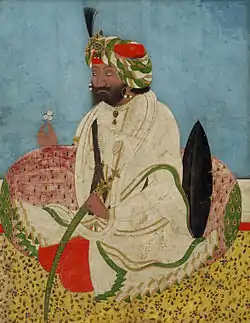 | 1846–1856 CE | Founder of Dogra dynasty and the first Maharaja of the Princely State of Jammu and Kashmir, the second largest princely state under the British Raj, which was created after the defeat of the Sikh Empire in the First Anglo-Sikh War. The Treaty of Amritsar (1846) formalised the sale by the British to Gulab Singh for 7,500,000 Nanakshahee Rupees of all the lands in Jammu and Kashmir that were ceded to them by the Sikhs by the Treaty of Lahore. |
| Ranbir Singh | 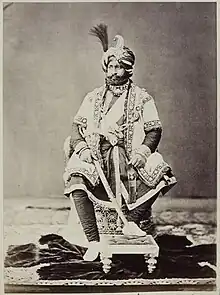 | 1856–1885 CE | Ascended the throne in 1856 after Gulab Singh's abdication due to poor health. He allied with the British during the Sepoy Mutiny. Unlike European women and children, Indian mutineers were not allowed to take refuge in his state. He also sent his troops to help the British to besiege Delhi. He was subsequently rewarded for his behaviour during the mutiny. He went on to annex Gilgit which had previously witnessed a rebellion against the state. He also established a modern judicial system. Civil and criminal laws were compiled into the Ranbir Penal Code during his reign. |
| Pratap Singh | .jpg.webp) | 1885–1925 CE | Reigned for 40 years from 1885 to 1925, the longest of all the Dogra rulers. Out of the four Dogra rulers, Maharaja Pratap Singh's era was a period of enlightenment for his subjects, particularly for Kashmiris. He established local self governing bodies, democratic processes, educational systems, health care and hygiene and infrastructure development during his reign. A beginning was made in local self-government by establishing municipalities at Jammu, Srinagar, Sopore and Baramulla. By 1925, then Kashmir, particularly Srinagar had undergone significant social and cultural transformation. |
| Hari Singh | 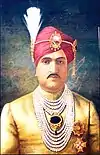 | 1925–1952 CE | Ascended the throne following the death of his uncle, Maharaja Pratap Singh in 1925. He made primary education compulsory in the state, introduced laws prohibiting child marriage, and opened places of worship to the low castes. He signed the Instrument of Accession of Jammu and Kashmir to the Union of India on 26 October 1947, through which the Princely State of Jammu and Kashmir became a part of the Dominion of India. He remained the titular Maharaja of the state until 1952, when the monarchy was abolished by Government of India under Jawaharlal Nehru. |
| Karan Singh (Prince Regent) | 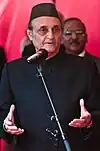 | 1949–1952 CE | Appointed as Prince Regent of Jammu and Kashmir in 1949, aged eighteen and served until the monarchy's abolition in 1952. He was appointed 'Sadr-e-Riyasat' ('Head of State') in 1952 and Governor of the State in 1964 CE. |
Unified Modern State
Imperial State of Hindustan (1526–1857 CE)
Badshahs of Hindustan
| Portrait | Titular Name | Birth (modern-day name) | Reign | Death |
|---|---|---|---|---|
1  |
Babur | 14 February 1483 Andijan, Uzbekistan | 20 April 1526 – 26 December 1530
(4 years 8 months 9 days) |
26 December 1530 (aged 47) Agra, India |
2  |
Humayun | 6 March 1508 Kabul, Afghanistan | 26 December 1530 – 17 May 1540
22 February 1555 – 27 January 1556 (10 years 3 months 25 days) |
27 January 1556 (aged 47) Delhi, India |
3  |
Akbar | 15 October 1542 Umerkot, Pakistan | 11 February 1556 – 27 October 1605
(49 years 9 months 0 days) |
27 October 1605 (aged 63) Agra, India |
4  |
Jahangir | 31 August 1569 Agra, India | 3 November 1605 – 28 October 1627
(21 years 11 months 23 days) |
28 October 1627 (aged 58) Jammu and Kashmir, India |
5  |
Shah Jahan | 5 January 1592 Lahore, Pakistan | 19 January 1628 – 31 July 1658
(30 years 8 months 25 days) |
22 January 1666 (aged 74) Agra, India |
6  |
Aurangzeb | 3 November 1618 Gujarat, India | 31 July 1658 – 3 March 1707
(48 years 7 months 0 days) |
3 March 1707 (aged 88) Ahmednagar, India |
7 .jpg.webp) |
Azam Shah | 28 June 1653 Burhanpur, India | 14 March 1707 – 20 June 1707 | 20 June 1707 (aged 53) Agra, India |
8  |
Bahadur Shah I | 14 October 1643 Burhanpur, India | 19 June 1707 – 27 February 1712
(4 years, 253 days) |
27 February 1712 (aged 68) Lahore, Pakistan |
9  |
Jahandar Shah | 9 May 1661 Deccan, India | 27 February 1712 – 11 February 1713
(0 years, 350 days) |
12 February 1713 (aged 51) Delhi, India |
10 |
Farrukhsiyar Puppet King Under the Sayyids of Barha |
20 August 1685 Aurangabad, India | 11 January 1713 – 28 February 1719
(6 years, 48 days) |
19 April 1719 (aged 33) Delhi, India |
11 |
Rafi ud-Darajat Puppet King Under the Sayyids of Barha |
1 December 1699 | 28 February 1719 – 6 June 1719
(0 years, 98 days) |
6 June 1719 (aged 19) Agra, India |
12 |
Shah Jahan II Puppet King Under the Sayyids of Barha |
5 January 1696 | 6 June 1719 – 17 September 1719
(0 years, 105 days) |
18 September 1719 (aged 23) Agra, India |
13 |
Muhammad Shah Puppet King Under the Sayyids of Barha |
7 August 1702 Ghazni, Afghanistan | 27 September 1719 – 26 April 1748
(28 years, 212 days) |
26 April 1748 (aged 45) Delhi, India |
14 |
Ahmad Shah Bahadur | 23 December 1725 Delhi, India | 29 April 1748 – 2 June 1754
(6 years, 37 days) |
1 January 1775 (aged 49) Delhi, India |
15 |
Alamgir II | 6 June 1699 Burhanpur, India | 3 June 1754 – 29 November 1759
(5 years, 180 days) |
29 November 1759 (aged 60) Kotla Fateh Shah, India |
16 |
Shah Jahan III | 1711 | 10 December 1759 – 10 October 1760
(282 days) |
1772 (aged 60–61) |
17 |
Shah Alam II | 25 June 1728 Delhi, India | 10 October 1760 – 31 July 1788
(27 years, 301 days) |
19 November 1806 (aged 78) Delhi, India |
18 |
Mahmud Shah Bahadur | 1749 Delhi, India | 31 July 1788 – 11 October 1788
(63 days) |
1790 (aged 40–41) Delhi, India |
19 |
Shah Alam II Puppet King under the Maratha Empire |
25 June 1728 Delhi, India | 16 October 1788 – 19 November 1806
(18 years, 339 days) |
19 November 1806 (aged 78) Delhi, India |
20 |
Akbar II Puppet King under the East India Company |
22 April 1760 Mukundpur, India | 19 November 1806 – 28 September 1837
(30 years, 321 days) |
28 September 1837 (aged 77) Delhi, India |
21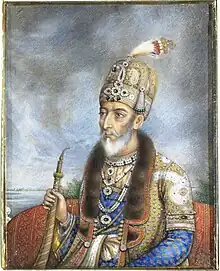 |
Bahadur Shah II | 24 October 1775 Delhi, India | 28 September 1837 – 21 September 1857
(19 years, 360 days) |
7 November 1862 (aged 87) Rangoon, Myanmar |
Empire of India (1876–1947 CE)
Emperors/Empresses of India
| Portrait | Name | Birth | Reign | Death | Consort | Imperial Durbar | Royal House |
|---|---|---|---|---|---|---|---|
 |
Victoria | 24 May 1819 | 1 May 1876 – 22 January 1901 | 22 January 1901 | None[lower-alpha 1] | 1 January 1877 (represented by Lord Lytton) |
Hanover |
_Luke_Fildes.jpg.webp) |
Edward VII | 9 November 1841 | 22 January 1901 – 6 May 1910 | 6 May 1910 | 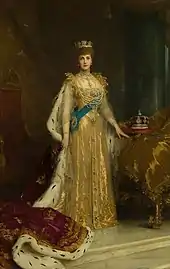
|
1 January 1903 (represented by Lord Curzon) |
Saxe-Coburg and Gotha |
 |
George V | 3 June 1865 | 6 May 1910 – 20 January 1936 | 20 January 1936 | 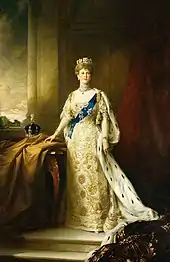
|
12 December 1911 | Saxe-Coburg and Gotha (1910–1917) Windsor (1917–1936) |
.jpg.webp) |
Edward VIII | 23 June 1894 | 20 January 1936 – 11 December 1936 | 28 May 1972 | None | None[lower-alpha 2] | Windsor |
 |
George VI | 14 December 1895 | 11 December 1936 – 15 August 1947[217] | 6 February 1952 | 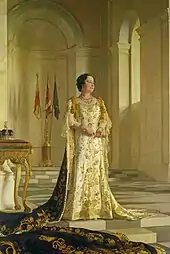
|
None[lower-alpha 3] | Windsor |
Union of India (1947–1950 CE)
King of India
| Portrait | Name | Birth | Reign | Death | Consort | Royal House |
|---|---|---|---|---|---|---|
 |
George VI | 14 December 1895 | 15 August 1947 – 26 January 1950[217] | 6 February 1952 | 
|
Windsor |
Republic of India (1950 to onwards)
See also
- Greater India
- History of India
- History of Hinduism
- Middle kingdoms of India
- Timeline of Indian history
- List of wars involving India
- Pottery in the Indian subcontinent
- Outline of South Asian history
Other lists of monarchs
- List of Tamil monarchs
- List of rulers of Assam
- List of rulers of Malwa
- List of rulers of Bengal
- List of rulers of Odisha
- List of rulers of India
- Lists of ancient kings
- List of heads of state of India
- List of Manipuri kings
- List of monarchs of Kashmir
- Legendary early Chola kings
- List of monarchs of Magadha
- List of Lunar dynasty kings
- List of Solar dynasty kings
- List of Jat dynasties and states
- List of Rajput dynasties and states
- List of Brahmin dynasties and states
- List of Jain states and dynasties
- List of Maratha dynasties and states
- List of rulers of the Delhi Sultanate
- List of dynasties and rulers of Rajasthan
- List of Rajput dynasties and states
- List of Hindu empires and dynasties
Notes
- Victoria's husband Prince Albert died on 14 December 1861.
- Edward VIII abdicated after less than one year of reign.
- A durbar was deemed expensive and impractical due to poverty and demands for independence.[218]
References
- Cunningham, Alexander (1877). Inscriptions of Asoka.
- Inscriptions of Asoka de D.C. Sircar p.30
- Dutt, Jogesh Chandra (1879). Kings of Káshmíra. Trübner & Co. pp. xix–xxiii.
- Stein, Marc Aurel (1979) [First published 1900]. Kalhana's Rajatarangini: A Chronicle of the Kings of Kasmir. Vol. 1. Motilal Banarsidass. pp. 133–138. ISBN 9780896841017.
- Stein 1979, pp. 133–138.
- Stein 1979, pp. 65.
- Cribb, Joe (April 2017). "Early Medieval Kashmir Coinage – A New Hoard and An Anomaly". Numismatic Digest. 40.
- D. C. Sircar (1969). Ancient Malwa And The Vikramaditya Tradition. Munshiram Manoharlal. p. 111. ISBN 978-8121503488. Archived from the original on 17 June 2016.
- Stein 1979, pp. 66.
- Stein, Marc Aurel (1989). Kalhana's Rajatarangini: a chronicle of the kings of Kasmir. Motilal Banarsidass. pp. 439–441. ISBN 978-81-208-0370-1.
- Raychaudhuri, H.C. (1972) Political History of Ancient India, Calcutta: University of Calcutta, pp.130–1.
- PK Bhattacharya (1977). Historical Geography of Madhya Pradesh from Early Records. Motilal Banarsidass. pp. 170–175. ISBN 978-81-208-3394-4.
- Kaalpurush Sahasrarjun. (n.d.). (n.p.): Atmaram & Sons.
- Thapar, Romila (1996). Ancient Indian Social History Some Interpretations, New Delhi: Orient Longman, ISBN 81-250-0808-X, p.282
- Gaṅgā Rām Garg (1992). Encyclopaedia of the Hindu World. Vol. 1. Concept Publishing Company. ISBN 9788170223740. Retrieved 28 October 2012.
- "Kalingas". www.ancientvoice.wikidot.com. Retrieved 29 November 2018.
- Krishna-Dwaipayana Vyasa (March 2008). The Mahabharata of Krishna-Dwaipayana Vyasa, Second Book Sabha Parva. Echo Library. p. 10. ISBN 9781406870442. Retrieved 28 October 2012.
- Raychaudhuri, Hemchandra (2006). Political History Of Ancient India. Genesis Publishing. p. 75. ISBN 9788130702919. Retrieved 25 October 2012.
- Mohamed, Naseema (2005). "First Settlers". Note on the Early History of the Maldives: 9. doi:10.3406/arch.2005.3970. Retrieved 21 March 2021.
- Pliny the Elder (77 CE), Natural History VI, 22.1, quoting Megasthenes (3rd century BCE), Indika, Fragm. LVI.
- Sahu, J. K. (1977). "The Meghas of Kosala". Proceedings of the Indian History Congress. 38: 49–54. ISSN 2249-1937. JSTOR 44139050.
- Jha, Kamal Kant; Vidyabhushan, Pt. Sri ganeshrai; Thakur, Dhanakar. "A Brief History of Mithila State Bihar Articles". bihar.ws. Archived from the original on 1 March 2012. Retrieved 10 January 2008.
- Encyclopaedia of Hinduism. Nagendra Kumar Singh, p. 3239.
- Raychaudhuri, Hemchandra (1972), Political History of Ancient India, University of Calcutta, Calcutta, pp. 106–113, 186–90
- Walshe, Maurice (1995). The Long Discourses of the Buddha: A Translation of the Digha Nikaya (PDF). Wisdom Publications. p. 409. ISBN 0-86171-103-3.
- Neelis, Jason (2010). Early Buddhist Transmission and Trade Networks: Mobility and Exchange Within and Beyond the Northwestern Borderlands of South Asia. BRILL. p. 232. ISBN 978-90-04-18159-5.
- Eggermont, Pierre Herman Leonard (1975). Alexander's Campaigns in Sind and Baluchistan and the Siege of the Brahmin Town of Harmatelia. Peeters Publishers. pp. 175–177. ISBN 978-90-6186-037-2.
- B. Kölver, ed. (1997). Recht, Staat und Verwaltung im klassischen Indien [Law, State and Administration in Classical India] (in German). München: R. Oldenbourg. pp. 27–52.
- Samuel, Geoffrey (2010). The Origins of Yoga and Tantra. Cambridge University Press.
- Misra, V.S. (2007). Ancient Indian Dynasties, Mumbai: Bharatiya Vidya Bhavan, ISBN 81-7276-413-8, pp.283-8, 384
- Debroy, Bibek (25 October 2017). The Valmiki Ramayana. Vol. 3. ISBN 9789387326286.
- Malik, Dr Malti (2016). History of India. New Saraswati House India Pvt Ltd. pp. 51–54. ISBN 978-81-7335-498-4.
- Kisari Mohan Ganguli, The Mahabharata of Krishna-Dwaipayana Vyasa Translated into English Prose, 1883-1896, Bk. 1, Ch. 3.
- Raychaudhuri, H.C. (1972). Political History of Ancient India, Calcutta: University of Calcutta, p. 85
- Upinder Singh (2008). A History of Ancient and Early Medieval India. Pearson Education India. pp. 381–384. ISBN 9788131711200.
- Charles Higham (2009). Encyclopedia of Ancient Asian Civilizations. Infobase Publishing. p. 299. ISBN 9781438109961.
- Rajesh Kumar Singh (2013). Ajanta Paintings: 86 Panels of Jatakas and Other Themes. Hari Sena. pp. 15–16. ISBN 9788192510750.
- Reddy (2005). General Studies History 4 Upsc. Tata McGraw-Hill Education. p. A-55. ISBN 9780070604476. Retrieved 25 October 2012.
- Mani, Chandra Mauli (2005). A Journey Through India's Past. Northern Book Centre. p. 51. ISBN 9788172111946. Retrieved 25 October 2012.
- Ancient India, History of Ancient India for 1000 years in four volumes. [From 900 B.C. to 100 A.D.]. Vol. IV. Baroda: Shashikant & Co. 1941. pp. 103.
- Raychaudhuri, Hemchandra (2006). Political History Of Ancient India. Genesis Publishing. p. 348. ISBN 9788130702919. Retrieved 25 October 2012.
- R. T. Vyas; Umakant Premanand Shah (1995). Studies in Jaina Art and Iconography and Allied Subjects. Abhinav Publications. p. 31. ISBN 9788170173168. Retrieved 12 November 2012.
- "Biography of His Highness Maharaja Bodhachandra Last King of Manipur Part 1". e-pao.net. Retrieved 2 December 2019.
- "Biography of His Highness Maharaja Bodhachandra Last King of Manipur Part 2". e-pao.net. Retrieved 2 December 2019.
- K. Gopalachari (1976). Early History of the Andhra Country. University of Madras. p. 39.
- Virottam, Balmukund (1969). The Nagbanshis and the Cheros. Munshiram Manoharlal.
- Wicks, Robert S. (31 May 2018). Money, Markets, and Trade in Early Southeast Asia: The Development of Indigenous Monetary Systems to AD 1400. Cornell University Press. p. 87. ISBN 978-1-5017-1947-9.
- Johnston, E. H. (1944). "Some Sanskrit Inscriptions of Arakan". Bulletin of the School of Oriental and African Studies, University of London. 11 (2): 357–385. doi:10.1017/S0041977X00072529. ISSN 0041-977X. JSTOR 609320. S2CID 191758063.
- Soni, Lok Nath (2000). The Cattle and the Stick: An Ethnographic Profile of the Raut of Chhattisgarh. Anthropological Survey of India, Government of India, Ministry of Tourism and Culture, Department of Culture. ISBN 978-81-85579-57-3.
- Ronald M. Davidson (2012). Indian Esoteric Buddhism: A Social History of the Tantric Movement. Columbia University Press. p. 35. ISBN 978-0-231-50102-6.
- Hans Bakker (2014). The World of the Skandapurāṇa. BRILL. p. 83. ISBN 978-90-04-27714-4.
- "Though there exists no direct evidence, there are indirect evidence of a king who ruled for a short period after Bhaskaravarman, but was ousted by Salasthamba."Sharma, Mukunda Madhava (1978). Inscriptions of Ancient Assam. Gauhati University, Assam. pp. xxxi–xxxii..
- "Detail History of Orissa". Government of Odisha. Archived from the original on 12 November 2006.
- Mirashi, Vasudev Vishnu (1975). Literary and Historical Studies in Indology. Motilal Banarsidass. p. 138. ISBN 978-81-208-0417-3.
- "The Historical Value of Gangavamsanucharita Champu" (PDF). www.shodhganga.inflibnet.ac.in. Retrieved 22 September 2018.
- Panda, Dr. Sanjay Kumar (2014). Chiktira Sahitya O Sahityika [Chikiti's literature & litterateurs] (in Odia). Bhubaneswar: Sahitya Swetapadma. pp. 15–16. ISBN 978-93-80759-65-4.
- Genealogical Table of the Zamindaras of Chikiti, Chikiti Estate. Sachhidananda Rajendra Deba, 28th Nov 1928. Typed by A. Rama Murthi, Clerk, Chikiti Estate.
- "PARLA KHIMEDI (Zamindari)". www.members.iinet.net.au. Retrieved 22 September 2018.
- ODISHA DISTRICT GAZETTEERS GAJAPATI (PDF), GAD, Govt of Odisha, 2002, p. 51
- Vanina, Eugenia, ed. (1988). Indian History (Audiobook). Allied Publishers. p. 409. ISBN 9788184245684.
- Mahajan V.D. (1960, reprint 2007). Ancient India, S.Chand & Company, New Delhi, ISBN 81-219-0887-6, pp.594–6
- Laloo, Betty (20 July 2016). "III: Early Jaintia State Formation" (PDF). Reconstructing the early Jaintia state through oral traditions (PhD). North-Eastern Hill University.
- "Jaintia Hills-Land of Myths and Legends". Mesmerizing Meghalaya. Archived from the original on 12 August 2020.
- Ronald M. Davidson 2012, p. 37.
- V. V. Mirashi (1974). Bhavabhuti. Motilal Banarsidass. ISBN 978-81-208-1180-5.
- P. C. Roy (1980). "The Coinage of the Kalachuris of Ratnapura". The Coinage of Northern India. Abhinav Publications. ISBN 978-81-7017-122-5.
- von Hinüber, Oskar, Professor Emeritus, University of Freiburg. "Bronzes of the Ancient Buddhist Kingdom of Gilgit". www.metmuseum.org.
{{cite web}}: CS1 maint: multiple names: authors list (link) - "Metropolitan Museum of Art". www.metmuseum.org.
- R. B. Singh (1964). History of the Chāhamānas. N. Kishore. pp. 51–70.
- Ashok Kumar Srivastava (1979). The Chahamanas of Jalor. Sahitya Sansar Prakashan. p. xvi. OCLC 12737199.
- Dasharatha Sharma (1959). Early Chauhān Dynasties. S. Chand / Motilal Banarsidass. p. 169. ISBN 978-0-8426-0618-9.
- Ashok Kumar Srivastava 1979, p. 53.
- Wink, André (1996) [First published 1990]. Al-Hind: The Making of the Indo-Islamic World. Vol. I (3rd ed.). BRILL. pp. 152–153. ISBN 978-90-04-09249-5.
- Pralambha, read from the Tezpur plates, can be corrected to Salambha, in light of the Parbatiya plates, Sharma, Mukunda Manhava (1978). Inscriptions of Ancient Assam. Guwahati: Gauhati University. p. 105.
- Handa 2002, p. 28 to 32.
- Sen, Sailendra Nath (1999) [First published 1988]. Ancient Indian History and Civilization (2nd ed.). New Age International. pp. 264–668. ISBN 81-224-1198-3.
- Georg Bühler, 'Pâiyalachchhî Nâmamâlâ', in Beiträge zur Kunde der Indogermanischen Sprachen, vol. 4, edited by Adalbert Bezzenberger (Göttingen, 1878) and B. J. Dośī, Pāia-lacchīnāmamāla (Prākṛta-Lakṣmināmamālā) (Bombay, 1960): v. 276
- Alexander Cunningham, ed. (1871). Archaeological Survey of India: Reports 1862–1884. Vol. I. Archaeological Survey of India. pp. 141–145. OCLC 421335527.
- D. C. Ganguly (1981). R. S. Sharma (ed.). A Comprehensive History of India (A. D. 300–985). Vol. 3, Part 1. Indian History Congress / Orient Longmans. p. 704.
- Alexander Cunningham 1871, p. 149.
- Jagbir Singh (2002). The Jat Rulers of Upper Doab: Three Centuries of Aligarh Jat Nobility. Aavishkar. p. 28. ISBN 978-81-7910-016-5.
- Dilip Kumar Ganguly (1994). Ancient India, History and Archaeology. Abhinav. pp. 33–41. ISBN 978-81-7017-304-5.
- Susan L. Huntington (1984). The "Påala-Sena" Schools of Sculpture. Brill Archive. pp. 32–39. ISBN 90-04-06856-2.
- R. C. Majumdar (1971). History of Ancient Bengal. G. Bharadwaj. p. 161–162.
- Abdul Momin Chowdhury (1967). Dynastic history of Bengal, c. 750-1200 CE. Asiatic Society of Pakistan. pp. 272–273.
- Bindeshwari Prasad Sinha (1977). Dynastic History of Magadha, Cir. 450–1200 A.D. Abhinav Publications. pp. 253–. ISBN 978-81-7017-059-4.
- Dineshchandra Sircar (1975–1976). "Indological Notes - R.C. Majumdar's Chronology of the Pala Kings". Journal of Ancient Indian History. IX: 209–10.
- "Nasik History - Ancient Period". State Government of Maharashtra. Archived from the original on 29 April 2005. Retrieved 14 October 2006.
- Sen 1999, p. 264.
- "Kannauj after Harsha". Jagran Josh. 14 October 2015.
- Dikshit, R. K. (1976). The Candellas of Jejākabhukti. Abhinav. p. 25. ISBN 978-81-7017-046-4.
- Sullerey, Sushil Kumar (2004). Chandella Art. Aakar Books. p. 25. ISBN 978-81-87879-32-9.
- Jackson, Peter (2003). The Delhi Sultanate: A Political and Military History. Cambridge University Press. p. 199. ISBN 978-0-521-54329-3.
- Jain, Kailash Chand (1972). Malwa Through the Ages, from the Earliest Times to 1305 A.D. Motilal Banarsidass. p. 329. ISBN 978-81-208-0824-9.
- Smith, Walter (1994). The Mukteśvara Temple in Bhubaneswar. Motilal Banarsidass. pp. 23–24. ISBN 978-81-208-0793-8.
- Dániel Balogh (2012). "Raṇasiṃha Revisited: A New Copper-plate Inscription of the Candrāvatī Paramāra Dynasty". Journal of the Royal Asiatic Society. Third Series. 22 (1): 103. JSTOR 41490376.
- Dániel Balogh (2010). "A Copperplate Land Grant by Raṇasiṃhadeva of the Candrāvatī Paramāras". Acta Orientalia Academiae Scientiarum Hungaricae. 63 (3): 270. doi:10.1556/AOrient.63.2010.3.3. JSTOR 23659005.
- Petech, Luciano (1977). The Kingdom of Ladakh, c. 950–1842 A.D. Instituto Italiano Per il Medio ed Estremo Oriente. pp. 171–172.
- Sali, M. L. (20 April 1998). India-China Border Dispute: A Case Study of the Eastern Sector. APH Publishing. ISBN 9788170249641. Retrieved 20 April 2018 – via Google Books.
- Kaul, H. N. (20 April 1998). Rediscovery of Ladakh. Indus Publishing. ISBN 9788173870866. Retrieved 20 April 2018 – via Google Books.
- Romila Thapar (2008). Somanatha. Penguin. p. 236. ISBN 9780143064688.
- A. K. Majumdar (1956). Chaulukyas of Gujarat. Bharatiya Vidya Bhavan. p. 199. OCLC 4413150.
- Michael D. Willis (1996). "Architecture in Central India under the Kacchapaghata Rulers". South Asian Studies. 12 (1): 14. doi:10.1080/02666030.1996.9628506.
- "Exploration Of Kadwaha, District Ashoknagar, Madhya Pradesh (2009-2010)". Bhopal: Archaeological Survey of India (Temple Survey Project). Archived from the original on 28 August 2016. Retrieved 9 May 2016.
- Prasad, Rajiva Nain (1966). Raja Man Singh of Amber. pp. 1.
- Sarkar, Jadunath (1994) [1984]. A History of Jaipur: C. 1503–1938. Orient Longman. p. 31. ISBN 81-250-0333-9.
- Sarkar (1994, p. 33)
- Sarkar (1994, p. 259)
- Sarkar (1994, p. 260)
- Arms & Armour at the Jaipur court by Robert Elgood p.10
- Prasad (1966, pp. 1–3)
- Stein 1989b, p. 433.
- Thakur 1990, p. 287.
- Tucci 1956, p. 66.
- Sen 1999, p. 272.
- Niyogi 1959, pp. 115–117.
- Niyogi 1959, p. 38.
- Niyogi 1959, p. 41.
- Hodgson, B. H. (1835). "Account of a Visit to the Ruins of Simroun, once the capital of the Mithila province". Journal of the Asiatic Society. 4: 121−124.
- Chaudhary, Radhakrishna. Mithilak Itihas (in Hindi). Ram Vilas Sahu. pp. 70–112. ISBN 9789380538280.
- "genealogy of the royal house of jaffna". Archived from the original on 28 December 2014. Retrieved 16 July 2021.
- Suresh K. Sharma, Documents on North-East India: Tripura, pp. 93-95
- Talbot, Cynthia (2001). Pre-colonial India in Practice: Society, Region, and Identity in Medieval Andhra. Oxford University Press. p. 177. ISBN 978-0-19803-123-9.
- The list presented for the Gingee line follows Srinivasachari, which takes chronicles mentioned in copper plate grants into account and notes governorship of Gingee began in Saka era 1386 / CE 1464.
- "History of Shimoga District, page 16" (PDF). District Gazette of Shimoga, Gazetteer Department, Government of Karnataka. Retrieved 8 August 2015.
- Friedberg, Arthur L.; Friedberg, Ira S. (2009). Sadashiva Nayaka reign. ISBN 9780871843081. Retrieved 30 June 2015.
- Portuguese Studies Review (ISSN 1057-1515) (Baywolf Press) p.34
- Portuguese Studies Review (ISSN 1057-1515) (Baywolf Press) p.35
- The quarterly journal of the Mythic society Vol.XI. Bangalore: The Mythic Society, Daly Memorial Hall. 1921. pp. 47–48.:”Venkatappa. ruled from 1504 to 1551. His son Bhadrappa died before him. During his reign the Moghals under Ranadullakhan seized Ikkeri and set up a, viceroy there. Then Virabhadrappa Nayaka ascended the Gadi and -retiring to Bidarur ruled over his country more peacefully than before. His rule lasted for 15 years from 1551 to 1566. During his reign the rule of Vokkaligas came to an end and was replaced by the rule of Banajigas”
- "BUCHANAN, Francis, A journey from Madras through the countries of Mysore, Canara, and Malabar, Vol 111, 1807, p.254"
- Advanced Study in the History of Modern India 1707-1813 by Jaswant Lal Mehta p.458
- Somasekhara Sarma, Mallampalli (1946). History of the Reddi Kingdoms (Circa. 1325 A.D., to circa. 144B A.D.). Waltair: Andhra University. p. 81.: "How this discrepancy arose and why such a wrong account was given in the Kaluvaceru grant is a mystery which is yet to be unravelled."
- Rama Rao, M. (1947). "The Fall of Warangal and After". Proceedings of the Indian History Congress. 10: 295. JSTOR 44137150.
It is thus impossible that Prolaya Vema could at any time have been a subordinate of the Musunuri chiefs.
- Howes, Jennifer (1 January 1998). The Courts of Pre-colonial South India: Material Culture and Kingship. Psychology Press. p. 28. ISBN 07-0071-585-1.
- Rao, Velcheru Narayana; Shulman, David; Subrahmanyam, Sanjay (1998). Symbols of substance : court and state in Nayaka period Tamil Nadu. Oxford University Press. p. 18.
- Jha, Makhan (1997). Anthropology of Ancient Hindu Kingdoms: A Study in Civilizational Perspective. M.D. Publications Pvt. Ltd. pp. 155–157. ISBN 9788175330344.
- Love Songs of Vidyāpati. Translated by Bhattacharya, Deben. London: G. Allen & Unwin. 1963.
- Coomaraswamy, Ananda Kentish (1915). Vidyāpati: Bangīya Padābali; Songs of the Love of Rādhā and Krishna. London: The Old Bourne Press.
- Dhere, Ramchandra (2011). Rise of a Folk God: Vitthal of Pandharpur South Asia Research. Oxford University Press, 2011. p. 243. ISBN 9780199777648.
- Kalyan Kumar Chakravarty (1984). Gwalior Fort: art, culture, and history. Arnold-Heinemann. pp. 98–116. ISBN 978-0-391-03223-1.
- B. D. Misra (1993). Forts and fortresses of Gwalior and its hinterland. Manohar. pp. 27–46. ISBN 978-81-7304-047-4.
- Kishori Saran Lal (1963). Twilight of the Sultanate. Asia Publishing House. p. 6. OCLC 500687579.
- Sant Lal Katare (1975). "Two Gangolatal, Gwalior, Inscriptions of the Tomara Kings of Gwalior". Journal of the Oriental Institute. Oriental Institute, Maharajah Sayajirao University. XXIII: 346.
- Somani 1976, pp. 105–107.
- Somani 1976, pp. 109–111.
- Somani 1976, pp. 112–113.
- Somani 1976, pp. 117–119.
- Somani 1976, pp. 122–144.
- Somani 1976, pp. 146–147.
- Somani 1976, pp. 146–148.
- Somani 1976, pp. 151–153.
- Somani 1976, pp. 152–169.
- "Maharana Sanga; the Hindupat, the last great leader of the Rajput race: Sarda, Har Bilas, Diwan Bahadur, 1867–1955 : Free Download, Borrow, and Streaming". Internet Archive. Retrieved 16 August 2020.
- Somani 1976, pp. 171–181.
- Somani 1976, pp. 189.
- Somani 1976, pp. 189–193.
- Somani 1976, pp. 193.
- Somani 1976, pp. 208–215.
- Somani 1976, pp. 220–230.
- Somani 1976, pp. 253–259.
- Somani 1976, pp. 260.
- Sharma, Gopinath. Rajasthan Ka Itihas. Agra. p. 278. ISBN 978-81-930093-9-0.
- Hooja, Rima (1 November 2006). A history of Rajasthan. Rupa & Co. p. 617. ISBN 9788129108906.
- Somani 1976, pp. 281–282.
- Sen, Sailendra (2013). A Textbook of Medieval Indian History. Primus Books. p. 183. ISBN 978-9-38060-734-4.
- Somani 1976, pp. 315.
- "Kingdom that Mughals could never win". The Tribune. 22 February 2016. Retrieved 29 January 2018.
- International Cyclopaedia: A Library of Universal Knowledge. Vol. 6. Dodd, Mead & Company. 1885. p. 451.
- "Bishnupur". Britannica.
Mallabhum kingdom
- Steemers, Koen (2000). Architecture, City, Environment: Proceedings of PLEA 2000 : July 2000 ... James & James (Science Publishers) Ltd. p. 377. ISBN 1902916166.
- Dasgupta, Gautam Kumar; Biswas, Samira; Mallik, Rabiranjan (2009). Heritage Tourism: An Anthropological Journey to Bishnupur. A Mittal Publication. pp. 31–43. ISBN 978-81-8324-294-3.
- Mallik, Abhaya Pada (1921). History of Bishnupur-Raj: An Ancient Kingdom of West Bengal (the University of Michigan ed.). Calcutta. pp. 128–130. Retrieved 11 March 2016.
- Jodhpur's Umaid Bhawan: The Maharaja of Palaces, by Aman Nath. Published by India Book House, 2008.
- Niyogi, Roma (1959). The History of the Gāhaḍavāla Dynasty. Oriental. p. 30. OCLC 5386449.
- Gogoi records that Sukhrangphaa died without leaving a son and the two ministers administered the kingdom without a king for five years (Gogoi 1968, p. 273). Gait and others do not record this (Gait 1906, p. 358), though Baruah does (Baruah 1993, p. 282)
- Sutuphaa was the younger brother of Sukhrangphaa, who was settled in a village called Lahanjing. He was invited by the Burhagohain and Borgohain to become the king and he set up his seat at Chapagurinagar (Gogoi 1968, p. 273)
- Sukhramphaa was assassinated by the king of the Chutiya kingdom on a barge ride on Suffry river (Gogoi 1968:273).
- Sukhangphaa and his chief queen were deposed and executed by the ministers for their autocratic rule (Gogoi 1968:274).
- Sudangphaa Bamuni Konwar was born to the second queen of Tyao Khamti in a Brahmin household of Habung (Gogoi 1968:274–275).
- Suhenphaa was speared to death in his palace by a Tai-Turung chief in revenge for being accused of theft (Gogoi 1968:282).
- Suhungmung was assassinated by a palace staff in a plot engineered by his son, Suklenmung (Gogoi 1968:309).
- Suramphaa was deposed by the ministers when he insisted on burying alive a son of each minister in the tomb of his dead step-son (Gogoi 1968:386). He was later murdered on the instructions of his nephew, the son of his brother and succeeding Swargadeo.
- Sutingphaa was a sickly king (Noriaya Raja), who participated in an intrigue by his chief queen to install a prince unpopular with the ministers. He was deposed and later murdered on the instructions of his son and successor king Sutamla (Gogoi 1968:391–392).
- Supangmung was grandson of Suleng (Deo Raja), the second son of Suhungmung (Gogoi 1968:448).
- The Maju Gohain, the brother of Chakradhwaj Singha, became the king. (Gogoi 1968, p. 470)
- Udayaaditya Sinha's palace was stormed by his brother (and successor king) with a thousand-strong contingent of men led by Lasham Debera, and the king was executed the next day. Udayaaditya's religious fanaticism under the influence of a godman had made him unpopular, and the three great gohains implicitly supported this group (Gogoi 1968:479–482). This event started a very unstable nine-year period of weak kings, dominated by Debera Borbarua, Atan Burhagohain and Laluk-sola Borphukan in succession. This period ended with the accession of Gadadhar Singha.
- Ramadhwaj Sinha was poisoned on the instructions of Debera Borbarua when he tried to assert his authority (Gogoi 1968:484).
- Deyell, John S. Ahom Language Coins of Assam.
- The Samaguria raja was deposed by Debera Borbarua, the de facto ruler, and later executed, along with his queen and her brother (Gogoi 1968:486).
- Gobar Rojaa was the son of Saranga, the son of Suten, the son of Suhungmung Dihingiya Roja.
- Gobar Raja was deposed and executed by the Saraighatias (the commanders of Saraighat/Guwahati), led by Atan Burhagohain (Gogoi 1968:486–488). Their target was the de facto ruler, Debera Borbarua, who was also executed.
- After Ramdhwaj Singha, Chamaguriya Khamjang Konwar alias Shujinpha ruled only 20 days from 10 April 1674 (e.i. Lakni Kat plao (or 26th year) of 18th Taosinga Circle) and on 30 April he was killed. There after Tungkhongiya Gobar Raja rose only 12 ruled. Both were killed by the powerful minister Debera Baruah. After Gobar Raja two more princes rose only for another 12 days who are not recorded in chronicles. The title of Suhung is suitable for Dihingia Arjun Konwar, who minted coins and ruled more than six months and the minted year 1675 is his rising year (e.i. Lakni khut ni (or 27th year) of 18th Taosinga Circle) -- (Phukan, J.N. (1987). Reattribution of the Coins of Suhung)
- Dihingia Arjun Konwar tried to assert control by moving against the de facto ruler, Atan Burhagohain, but was routed in a skirmish. Sujinphaa was blinded and held captive when he committed suicide by striking his head against a stone (Gogoi 1968:489).
- Sudoiphaa was the grandson of Suhungmung's third son, Suteng (Gogoi 1968:490).
- Sudoiphaa was deposed by Laluk-sola Borphukan, who styled himself as the Burhaphukan, and later executed. Atan Burhagohain, the powerful minister, had been executed earlier (Gogoi 1968:492–493).
- Sulikphaa Lora Roja was deposed and then executed by Gadadhar Singha (Gogoi 1968:496–497).
- Kamaleswar Singha was installed as the king by Purnananda Burhagohain when he was still an infant. He was the son of Kadam Dighala, the son of Ayusut, the son of Lechai, the second son of Gadadhar Singha. Kadam Dighala, who could not become the king because of physical blemishes, was an important influence during the reign (Baruah 1993:148–150).
- Chandrakanta Singha was deposed by Ruchinath Burhagohain, mutilated and confined as a prisoner near Jorhat (Baruah 1993:221). The Burhagohain choose Brajanath, a descendant of Suremphaa Pramatta Singha, as the king and coins were struck in the new king's name, but it was discovered that he had mutilations on his person and his son, Purandar Singha, was instated instead (Gait 1906:223).
- Purandar Singha's forces under Jaganath Dhekial Phukan defeated the forces led by the Burmese general Kee-Woomingee (Kiamingi or Alumingi Borgohain) on 15 February 1819, but due to a strategic mistake Jorhat fell into Burmese hands. Kiamingi brought back Chandrakanta Singha and installed him the king (Baruah 1993:221–222).
- Chandrakanta Singha fled to Guwahati when the army of Bagyidaw king of Burma, led by Mingimaha Tilwa, approached Jorhat (Baruah 1993:223).
- Jogeshwar Singha was the brother of Hemo Aideu, one of the queens of Bagyidaw. He was installed as the king by Mingimaha Tilwa (Baruah 1993:223).
- Jogeshwar Singha was removed from all pretense of power and Mingimaha Tilwa was declared the "Raja of Assam" toward the end of June 1822 (Baruah 1993:225).
- Purandar Singha was set up by the East India Company as the tributary Raja of Upper Assam (Baruah 1993:244).
- "Princess Daisy of Pless: The Happy Years. An exhibition at Castle Pless". www.rvondeh.dircon.co.uk.
- Bhattacharjee, J B (1994). "Pre-colonial Political Structure of Barak Valley". In Sangma, Milton S (ed.). Essays on North-east India: Presented in Memory of Professor V. Venkata Rao. Indus Publishing Company. p. 71. ISBN 978-81-7387-015-6.
The Khaspur state originated with Chilarai's invasion in 1562 AD and remained in existence till 1745 when it merged with the Dimasa state of Maibong.
- "The Collected Works of Mahatma Gandhi, Volume 94" (PDF). GandhiServe.
- India), Asiatic Society (Kolkata (1901). Journal.
- Cultural Heritage of [Orissa]: pts. 1-2. Katak. State Level Vyasakabi Fakir Mohan Smruti Samsad. 2002. ISBN 978-81-902761-5-3.
- Cultural Heritage of [Orissa]: Dhenkanal. State Level Vyasakabi Fakir Mohan Smruti Samsad. 2002. ISBN 978-81-902761-5-3.
- Bhaskar Mishra (July 2011), The Traditional Role of Gajapati Maharaja in Shri Jagannath Temple (PDF), Orissa Review
- Indu Ramchandani, ed. (2000). Student's Britannica: India (Set of 7 Vols.) 39. Popular Prakashan. p. 8. ISBN 978-0-85229-760-5.
- Anwar, Kombai S. (26 April 2018). "Thanjavur emerged as a thriving cultural capital under the Marathas". The Hindu. ISSN 0971-751X. Retrieved 16 April 2021.
- Subramanian, Pg 61
- Prabhakar Gadre (1994). Bhosle of Nagpur and East India Company. Jaipur, India: Publication Scheme. p. 257. ISBN 978-81-85263-65-6.
Cogent arguments were advanced against the lapse of Nagpur State. But ... the view of the Governor-General, Lord Dalhousie, pravailed and the Nagpur kingdom was annexed on 13th March, 1854.
- K. R. Venkatarama Ayyar, Sri Brihadamba State Press, 1938, A Manual of the Pudukkóttai State, p.720
- Guida M. Jackson; Guida Myrl Jackson-Laufer (1999). Women Rulers Throughout the Ages: An Illustrated Guide. ABC-CLIO. p. 227. ISBN 9781576070918.
- George VI retained the title "Emperor of India" until 22 June 1948.
- Vickers, Hugo (2006), Elizabeth: The Queen Mother, Arrow Books/Random House, p. 175, ISBN 978-0-09-947662-7
Books
- Baruah, S. L. (1993). Last Days of Ahom Monarchy. New Delhi: Munshiram Manoharlal. OCLC 31777697.
- Gait, Edward A. (1906). A History of Assam. Calcutta: Thacker, Spink & Co.
- Gnyawali, Surya Bikram (1 December 1971) [1962], "The Malla Kings of Western Nepal" (PDF), Regmi Research Series, 3 (12): 265–268
- Gogoi, Padmeshwar (1968). The Tai and the Tai kingdoms. Gauhati University. OCLC 199460.
- Handa, O. C. (Omacanda) (2002). History of Uttaranchal. New Delhi: Indus Publishing. ISBN 9788173871344.
- Pande, Badri Datt (1993). History of Kumaun : English version of "Kumaun ka itihas". Almora: Shyam Prakashan. ISBN 81-85865-01-9.
- Somani, Ram Vallabh (1976). History of Mewar, from Earliest Times to 1751 A.D. Mateshwari. OCLC 2929852.
- Stein, Mark Aurel (1989a) [1900]. Kalhana's Rajatarangini: a chronicle of the kings of Kasmir, Volume 1 (Reprinted ed.). Motilal Banarsidass. ISBN 978-81-208-0369-5. Retrieved 11 July 2011.
- Stein, Mark Aurel (1989b) [1900]. Kalhana's Rajatarangini: a chronicle of the kings of Kasmir, Volume 2 (Reprinted ed.). Motilal Banarsidass. ISBN 978-81-208-0370-1. Retrieved 10 July 2011.
- Thakur, Laxman S. (1990). "The Khaśas: An Early Indian Tribe". In K. K. Kusuman (ed.). A Panorama of Indian Culture: Professor A. Sreedhara Menon Felicitation Volume. Mittal Publications. pp. 285–293. ISBN 978-81-7099-214-1.
- Tucci, Giuseppe (1956). Preliminary Report on Two Scientific Expeditions in Nepal. David Brown Book Company. ISBN 978-88-575-2684-3.